*Updated for 2024
Welcome to another official guide here at GND-Tech. This one is about consumer audio playback products ranging from speakers to headphones, digital to analog converters (DACs), amplifiers, sound cards, and more. This is primarily a buying guide, sorting highly recommended audio products by category and price range. But of course, we will provide you with some basic information on different kinds of audio products and their function.
Another goal of this article is to help people avoid the “ignorant and overspending” phase that I and many others went through. For modern day consumer hi-fi, the most common pattern is: people start with headphones because they’re generally more affordable, they join Head-Fi forums, and then they are misled by groupthink along with entirely subjective published reviews by popular websites and YouTubers with a complete lack of data, reviews meant to help sell overpriced products because the reviewer has a relationship with these companies.
In this article, the consumer hi-fi or audiophile industry is broken down, fundamentals of audio equipment is discussed, and products are recommended and categorized by price point.
Avoid “Gaming” Audio Equipment
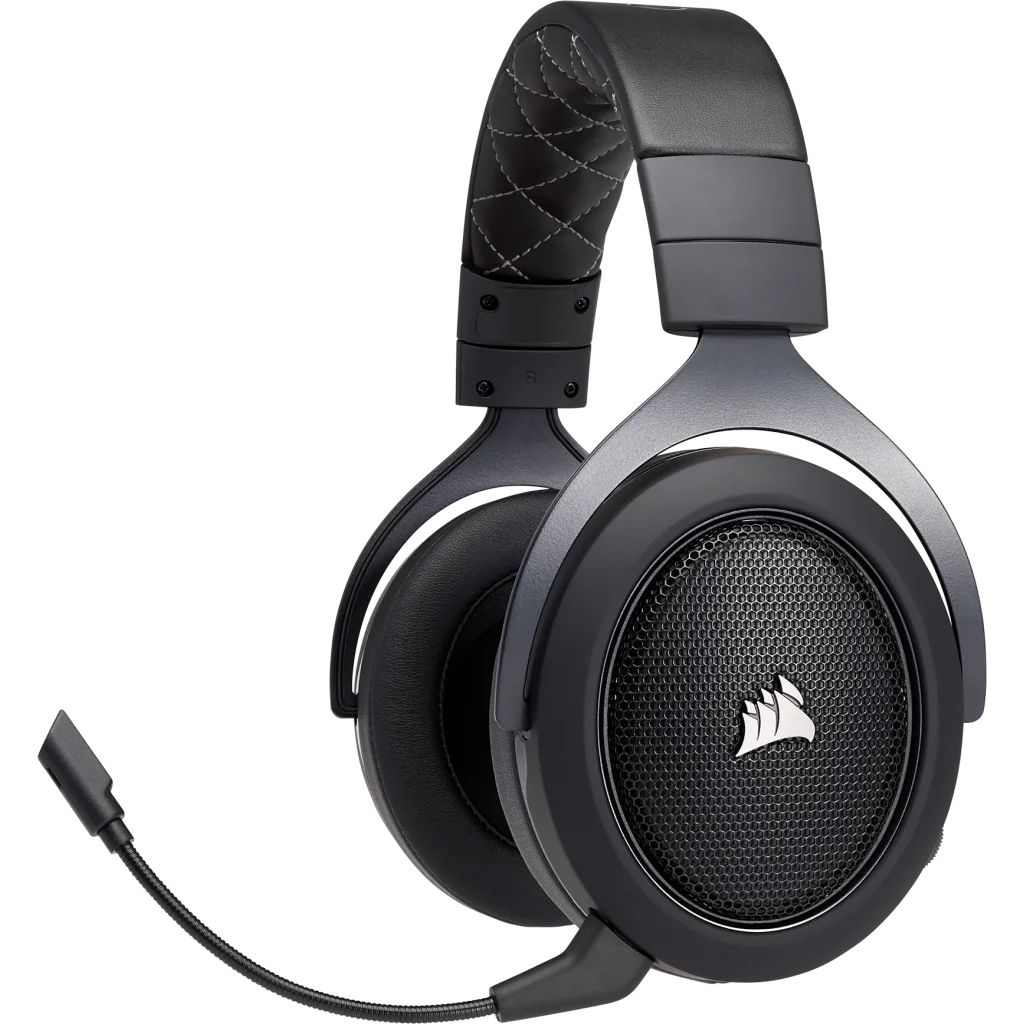
Although most of us here at GND-Tech are gamers, gaming headsets (headphone and microphone combinations from companies like Logitech, Razer, Steelseries, and Corsair) are really not the way to go. Especially $100+ ones, not only are they not worth the money, they’re complete ripoffs: poor performing, dirt cheap build quality products with gimmicks and a name slapped on and a ridiculous price. Much like the old gaming keyboards that used to exist, like the Logitech G15 and Logitech G19. Some exceptions exist though, and they will be covered in the product recommendation sections.
Gaming headsets are really cheap headphones with a microphone attached. You’re paying for the brand name more than anything. Even the sub $50 Monoprice headphones outperform at least most of them by a considerable margin. Later in this article, much better headphones are recommended by price point, including under $100.
On a related note, avoid “gaming” speakers from gaming companies too for all the same reasons. Their performance is terrible at any price, yet they are overpriced.
Note: some legitimate audio brands like Sennheiser do have gaming headsets that might actually be good. One is recommended below and is surprisingly good.
Onboard Audio Will Never be High End
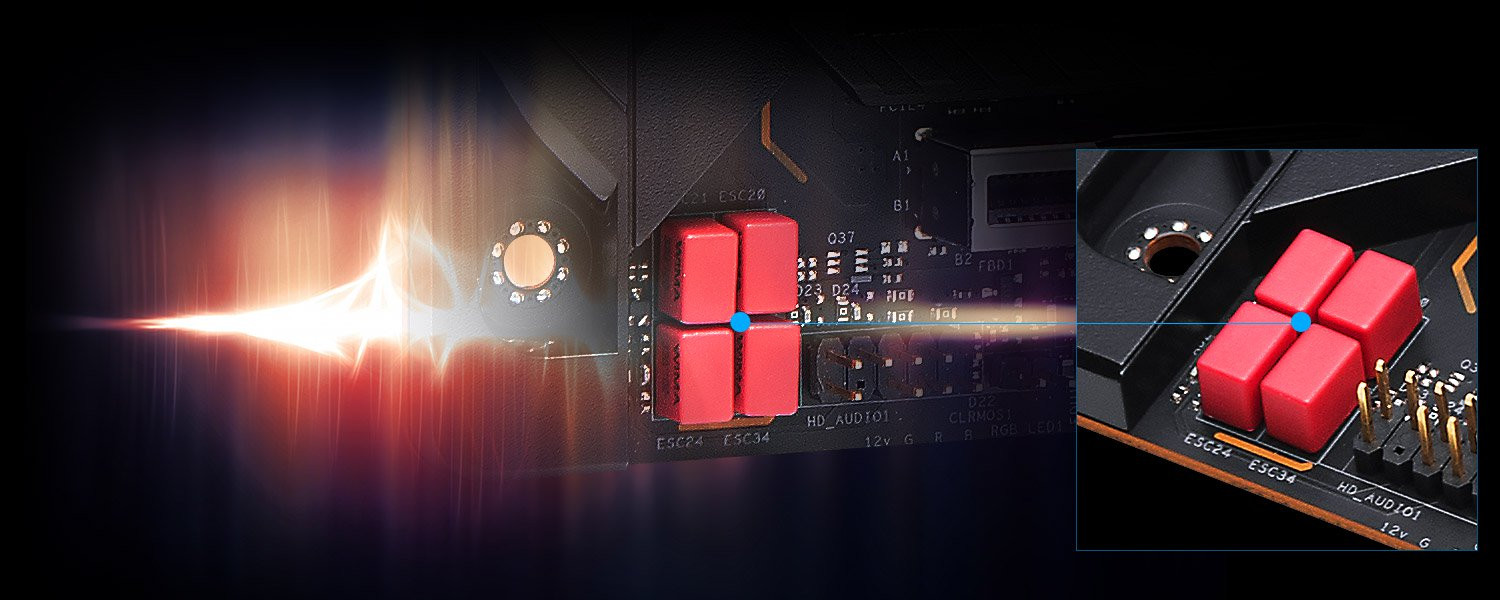
But it’s objectively higher end than most uber expensive DACs! Apple’s $10 dongle is likewise a better DAC than almost all the uber expensive hi-fi DACs. We’ll get into this later. Building on the previous subject about avoiding gaming audio stuff, a computer’s motherboard’s onboard audio solution leaves a lot to be desired. The quality of the DAC itself isn’t a huge problem on the high end ones these days, but they can be susceptible to jitter and channel imbalance issues. More likely than not, these won’t be audible in higher end boards. However, they are lacking in amplification both for passive speakers and headphones, you can never connect more than a 5 channel active speaker system to them, they have no Dolby Atmos or DTS:X support, no useful DSP features like PEQ and of course no digital room correction.
So if you’re getting into the hi-fi hobby, you won’t want to connect your speakers or headphones directly to your motherboard or PC case. If replacing onboard audio, chances are you’ll be looking at sound cards but sound cards are pointless. They were only useful for gaming before Windows Vista came and brought upon the end of DirectSound3D, explained here.
If you’re getting nice headphones, you’ll want a DAC and headphone amplifier. If looking to get into speakers, for surround sound you’ll want an A/V processor + active speakers or A/V receiver + passive speakers. For two channel speaker systems, you’ll want a DAC, preamplifier, and if using passive speakers then also a power amplifier – or an integrated amplifier instead of preamp + power amp. Now is a good time to explain what these things are.
What are DACs and Amplifiers?
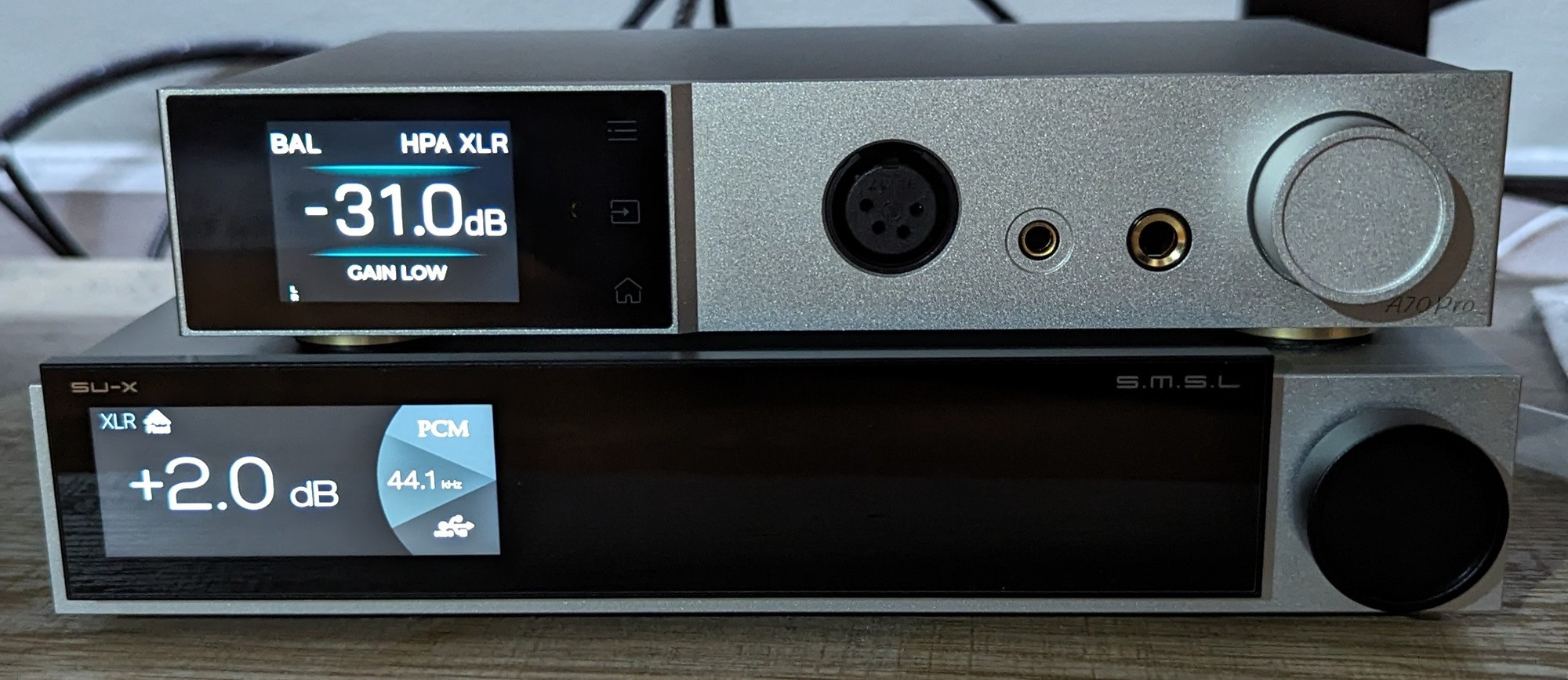
DAC stands for Digital to Analog converter. If you’re listening to any speakers or headphones out of a computer/phone, then there is a DAC in there somewhere. As the name implies, a DAC converts a digital audio signal to analog, because analog is ultimately what we hear – it’s the signal being played by speakers/headphones. We can’t get sound out of a computer (and yes this includes a phone) without one.
But of course, not every DAC is the same. Some are more accurate than others in the actual conversion, some have badly designed analog stages, and get this: DAC price does not correlate with performance! Power amplifier price/performance correlation may generally exist up to around $1,000, and for headphone amplifiers there is minimal correlation. Technical details about this are discussed later in this article, but this image from this AES research paper sums it up. Not that SINAD is the only measurement or even the most audible one, but the more important measurements (reconstruction filter accuracy and attenuation, linearity and frequency response) generally also fall in line with this lack of correlation.
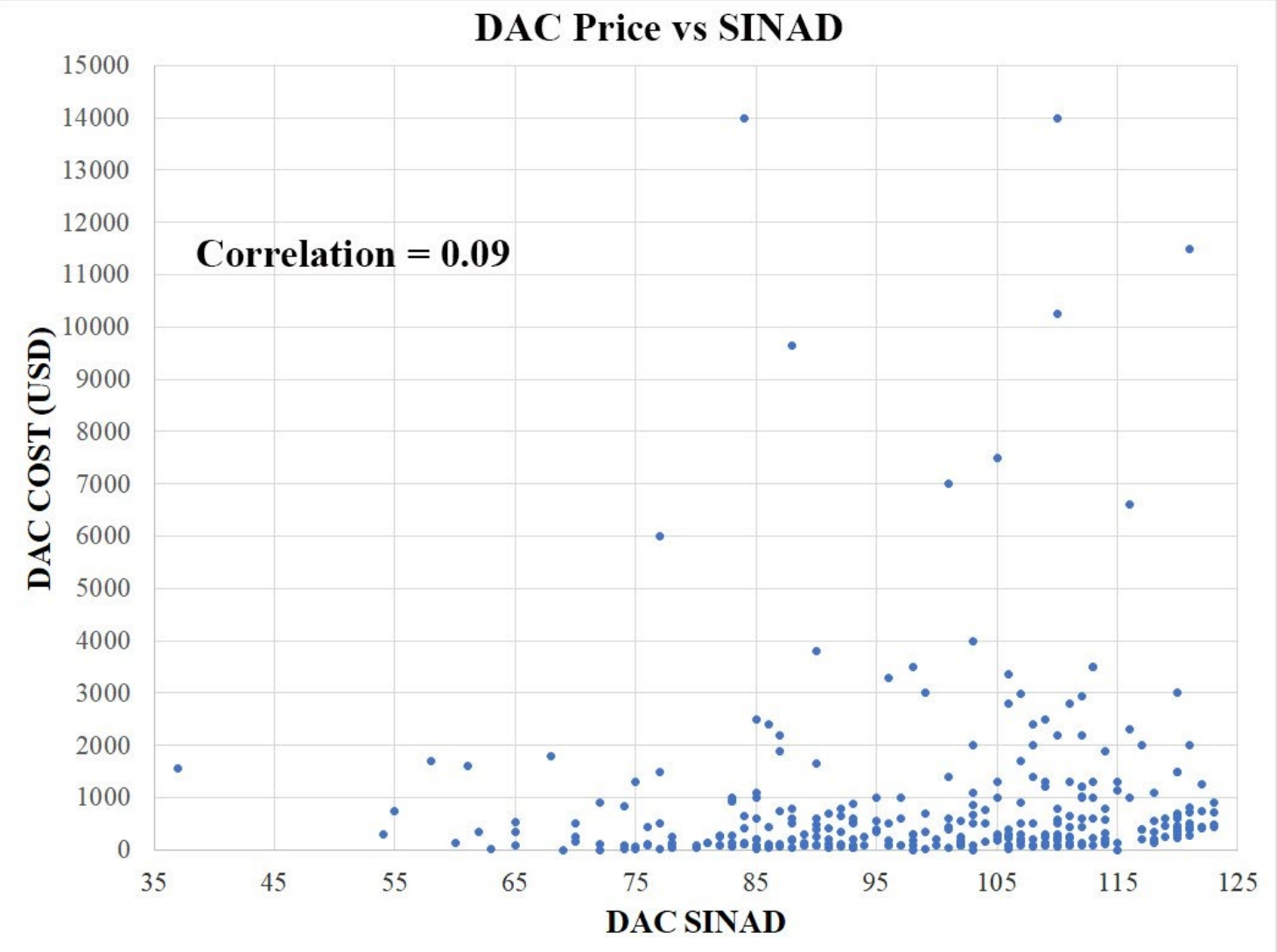
Amplifiers of course amplify an audio signal to make it stronger. Their main use case is to increase the volume from speakers/headphones, but ideally they’d do so without creating audible noise, distortion, or other issues, which are also discussed later in this article.
All passive speakers need to be amplified, but active speakers have amplification built-in (more on this later). Not all headphones need to be amplified. There are product specs that indicate whether or not a headphone needs amplification – most of all the sensitivity spec, which will likewise be discussed more later in this article.
Unfortunately, it is unwise to choose any audio product, including these, based on most reviews or specs alone. Most reviews are useless subjective ramblings, not taking into account that everyone has different hearing preferences, different ears, different listening environments. Specs are generally misleading, designed to make a product look better than it is by only showing best case scenario and even skewed numbers. Legitimate reviewers are recommended below, and in this article we’ll go over how to avoid being misled. To start, we should move onto some of the most fundamental elements of audio components and what they mean.
Frequency Response
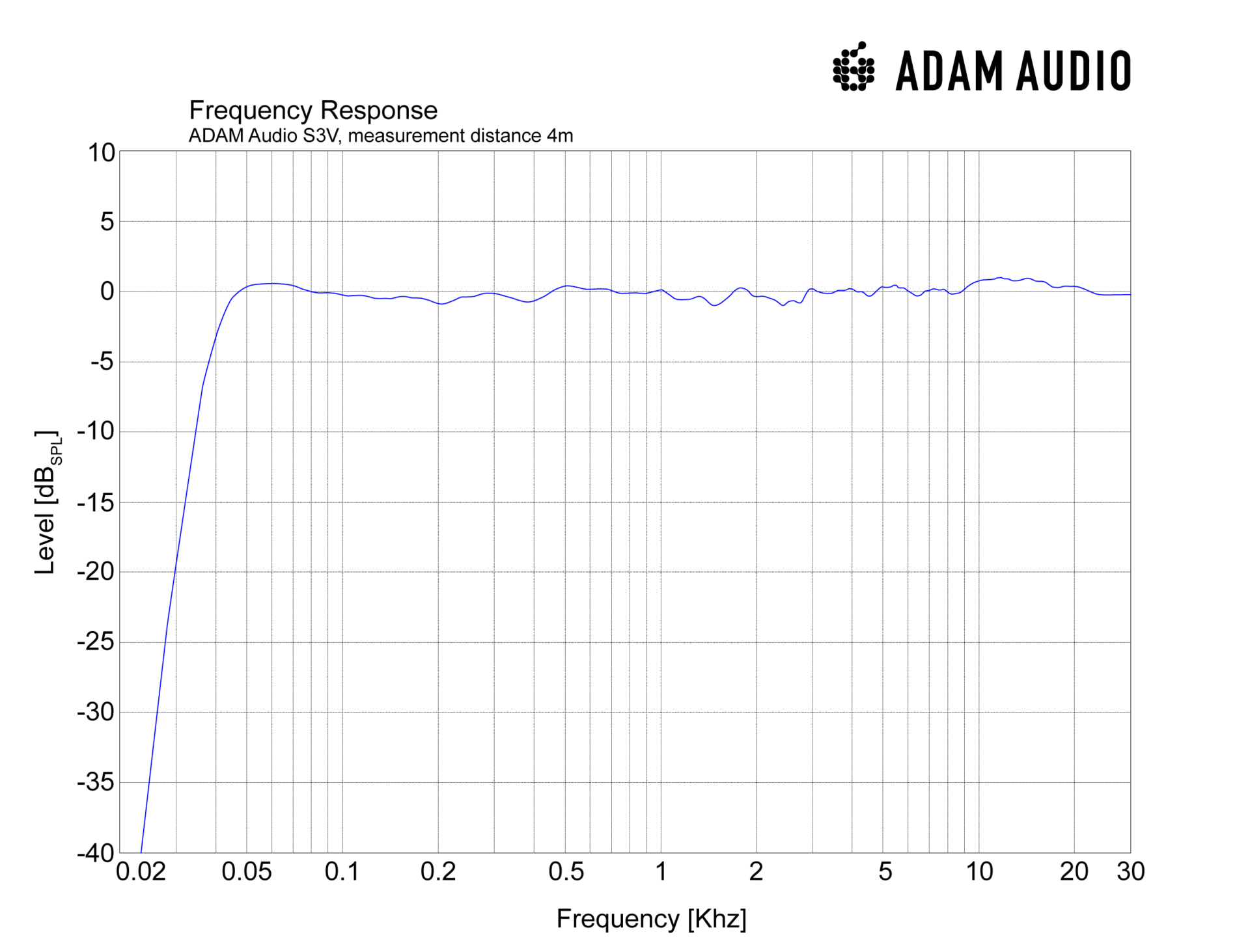
One of the first things people look at when buying headphones or speakers is the frequency response, which generally refers to a graph like the above which consists of the sound frequency vs sound pressure level (SPL) which is the volume. This is the most fundamental measurement of how a speaker or headphone sounds.
Sound that we hear is measured primarily in the frequency domain. Lower frequency means deeper sound, with the lowest range being bass (<=250 Hz). The highest, shrieking range is referred to as treble (4-20+ KHz). In between that is the mid range. For audio equipment, we are only really concerned about the performance between 20 Hz and 20 KHz, known as the audible band. Anyone who wants to retort about phase, that is discussed later in this article in its own section. Very few people can hear outside of this frequency range, and as you age, your ability to hear higher frequencies dies off considerably. Young adults and below may be able to hear 20 KHz, or perhaps even higher, while middle aged people can only hear up to 14 KHz on average. Therefore, the older you get, the less discerning a listener you can be.
Looking at a frequency response graph will help you get an idea of how the headphone or speaker in question will sound. It’s a tonality measurement above all. The example above shows a speaker with a generally flat or linear frequency response, in this case from just under 50 Hz to over 20 KHz. The term “linear” or “flat” frequency response is used often in the audio world, as it is the reference point, a “neutral” sounding speaker; a speaker that does not skew the sound. A speaker with a linear frequency response is the most tonally accurate speaker, giving you the closest representation of the sound signal, as it is not playing one frequency band considerably higher or lower than another.
The frequency response plot above, which is a rather low resolution one (provided by the speaker manufacturer), shows less than a +2 dB or -2 dB variation from just under 50 Hz to over 20 KHz. So all the sound from around 50 Hz to the top range of your hearing has an almost equal volume level, at least in the anechoic chamber they measured in. At 40 Hz, that speaker’s volume level is down by around 5 dB, so that low frequency is quieter than it should be. Of course, sound reflects all around your room, so in a normal room it won’t measure anywhere near this flat.
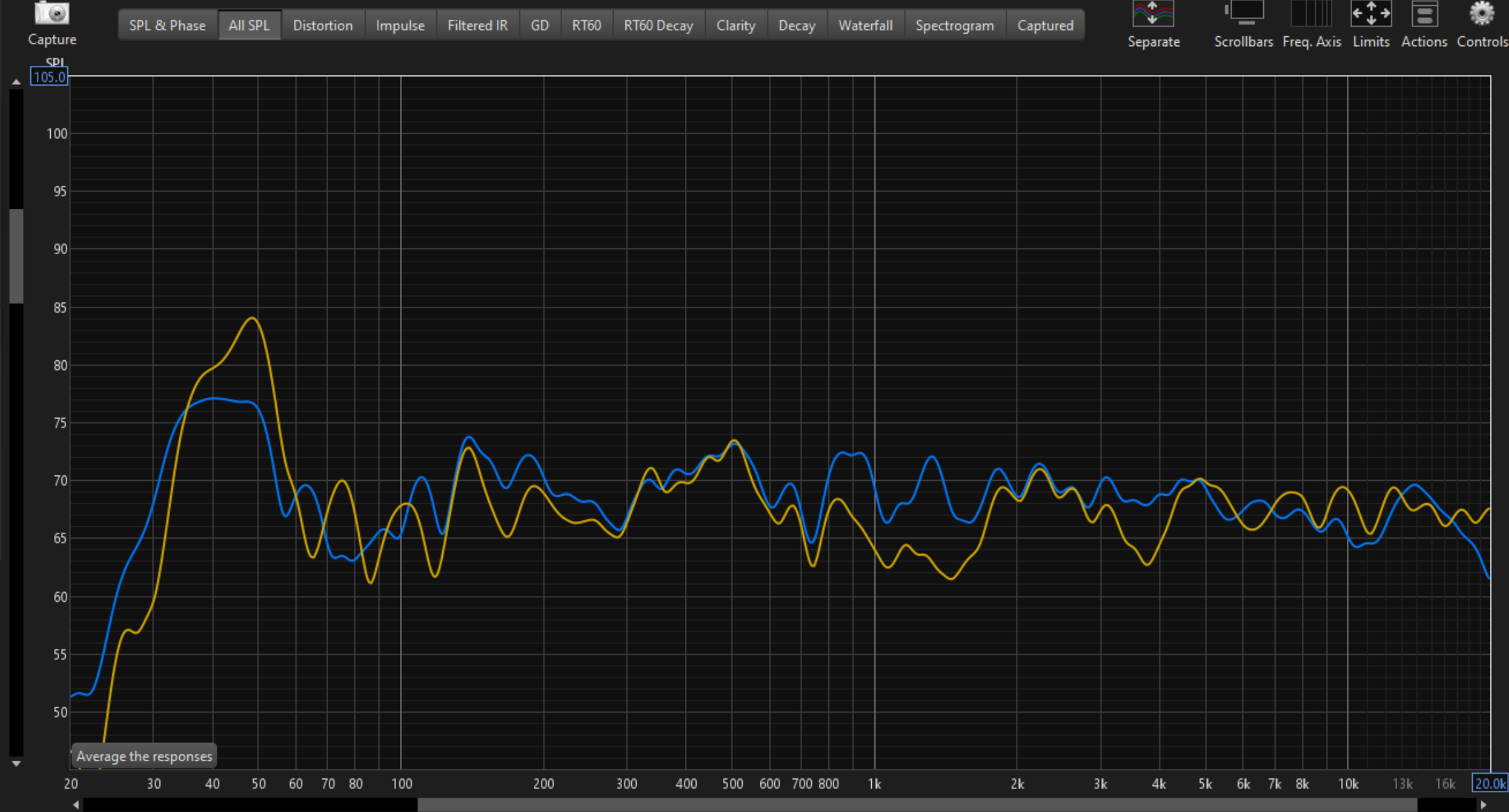
Here’s that same speaker, the ADAM Audio S3V, as I measured it in my room – the yellow line is without any sort of room correction/EQ, while the blue line is with Dirac Live digital room correction. What a far cry from the anechoic chamber results, even with room correction! We see a massive sub-bass peak from around 34 Hz to 55 Hz, followed by a massive dip until around 130 Hz. The whole thing is far from flat. Room acoustics ultimately ruin how a speaker performs, which is where room correction comes in. Also, there is one speaker lineup that is not so badly ruined by room acoustics even without room correction – Genelec’s “The Ones”. More on them later, but they are the top recommendations for anyone who can afford them for this reason.
The ideal speaker would have a completely linear frequency response from 20 Hz to 20 KHz, or even just past these boundaries. This requires an anechoic chamber, but with the use of parametric equalization and more feasible room treatment (more on both of these later), one can try to correct their speakers to reach this goal.
I don’t think any speaker achieves better than a mostly linear frequency response from 30 Hz – 20 KHz though, and such speakers are extremely expensive – the Neumann KH 420 and some Geithains are the only ones I’ve seen, though the ADAM Audio S5V may also accomplish this but that’s unconfirmed. The Genelec 8361A gets close, and this is the best measuring speaker by far in a normal room (except at close proximity of course). Such speaker recommendations are listed later in this article.
However, a speaker’s frequency response measurements are extremely different than how they’d measure in your room. For this reason, it’s very important to seek reviews that measure a speaker’s frequency response using a Klippel NFS in a fairly typical room, as this system calculates room imperfections and shows how the speaker measures both with and without them. This is also why directivity is one of the most important metrics in how a speaker performs. We’re not in perfect rooms. Good directivity (how the sound is dispersed) helps.
But there are audiophiles who talk about preferring “color” and disliking linear frequency responses, sometimes calling them lifeless or clinical or sterile. This is merely groupthink and while yes, not everyone will always prefer a linear frequency response, but also you might not prefer your “coloration” (skewed frequency response) for every song. This is why one should pursue equipment with the most linear frequency response, as it’s the most accurate representation of the sound recording. If you want to make changes, apply equalization from there and hope it doesn’t create audible distortion.
Or, just get used to tonally accurate sound. We’re very good at adapting to a speaker or headphone’s sound as long as it isn’t full of horrendous peaks and dips in the frequency response; this is how people developed a like for headphones over the years before Harman’s research in 2013; before that, even most big headphone manufacturers lacked a clear goal in how to tune their headphones, they were shooting in the dark.
Not to mention: very few people have even heard a linear frequency response like the above in their lifetimes. It requires being in an anechoic chamber. Who gets to go to those? But what about headphones, you ask? Well, a linear headphone frequency response wasn’t published until 2013. So let’s move onto headphone frequency response.
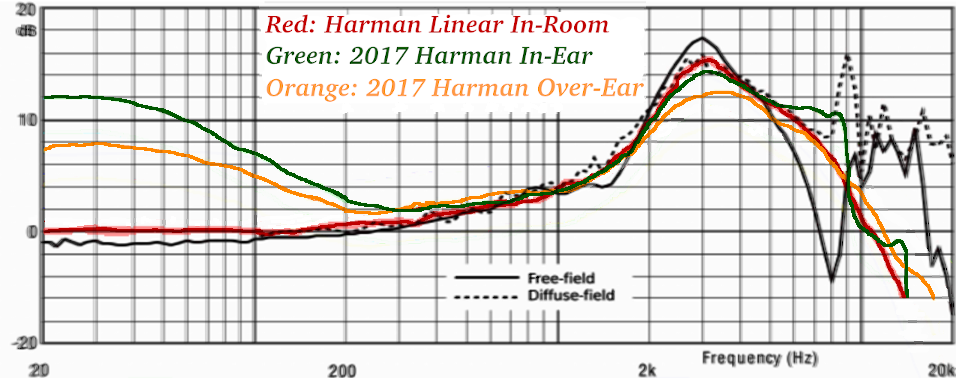
Headphone frequency response is a different beast entirely to measure. For headphones, frequency response measurements are done with simulated ears. Our ears skew the frequency response that we hear. For a headphone to sound linear like a speaker, the frequency response actually cannot be a straight line when measured with an ear simulator rig, due to the complexities of our ears. Not to mention, everyone’s ears are different.
Harman tried to model what a linear loudspeaker frequency response would sound like in headphones using an ear simulator rig, which eventually led to their research in using many listening subjects to model the “preferred” headphone frequency response. These are called the Harman preference curves, and some of the older ones are illustrated in the image above. These change every year they publish more data; the latest ones are 2018 for over ear and 2019 for in-ear.
OE stands for over-ear (circumaural) while IE stands for in-ear. Not everyone will prefer frequency responses like this – in at least one of the years Harman published data for, 40% of listeners deviated slightly, primarily in bass response preference. Within that 40%, one group preferred a bit more bass and another preferred a bit less. If you compare the Harman preference curves over the years, bass is the main difference.
The Harman preference curves represent a good starting point for your preferred frequency response, even if yours isn’t exactly the same. It’s a good baseline for what generally sounds good to people.
Harman’s published data dates back to 2013. Before this, all headphone manufacturers were firing blindly into the dark when it comes to tuning their headphones, though some of the bigger companies like Sennheiser definitely did their own research. With the Harman linear in-room frequency response, that gives us a model of what a linear loudspeaker setup sounds like in a headphone. The other plots show preferred frequency responses from their research.
Here was Harman’s measured deviation from their preference curves based on age, sex, and whether or not they were trained listeners.
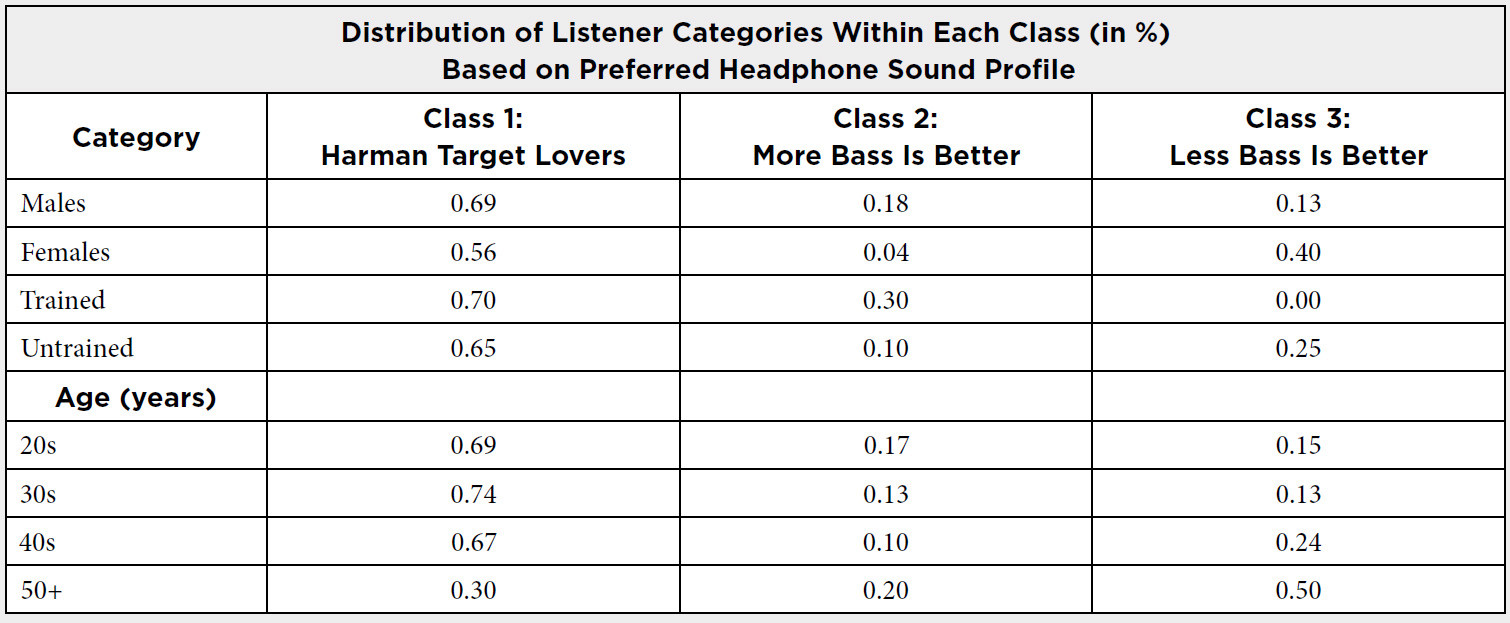
So if you want a tonally accurate headphone, get one that has a frequency response that closely adheres to the Harman linear in-room response. It’s the best research we have. Or, if you want a headphone with a frequency response you’re most likely to prefer, get one that generally follows the Harman preference curves, making sure to keep in mind the difference between in-ear and over-ear. Most people don’t prefer the linear in-room response, according to Harman’s research, hence the development of the preference curves. There are other preference curves, such as Crinacle’s IEF neutral and others, but Harman’s research has more data backing it. However, I encourage you to experiment with every target curve out there just to find out what you favor.
Note that headphone frequency response measurements above 7-8 KHz are significantly less precise. The higher you go, the less precise.
Ultimately, you won’t know what you favor until you experiment. Furthermore, not everyone has a single favorite frequency response for every song, which is why it’s best to invest in tonally accurate gear and tune from there if you refuse to adapt your listening preference to a tonally accurate model. This is wiser than buying a different headphone for each of your genres – instead of wasting money like that, I recommend getting one superb one like the AKG K371 and loading up different EQ profiles per genre if needed.
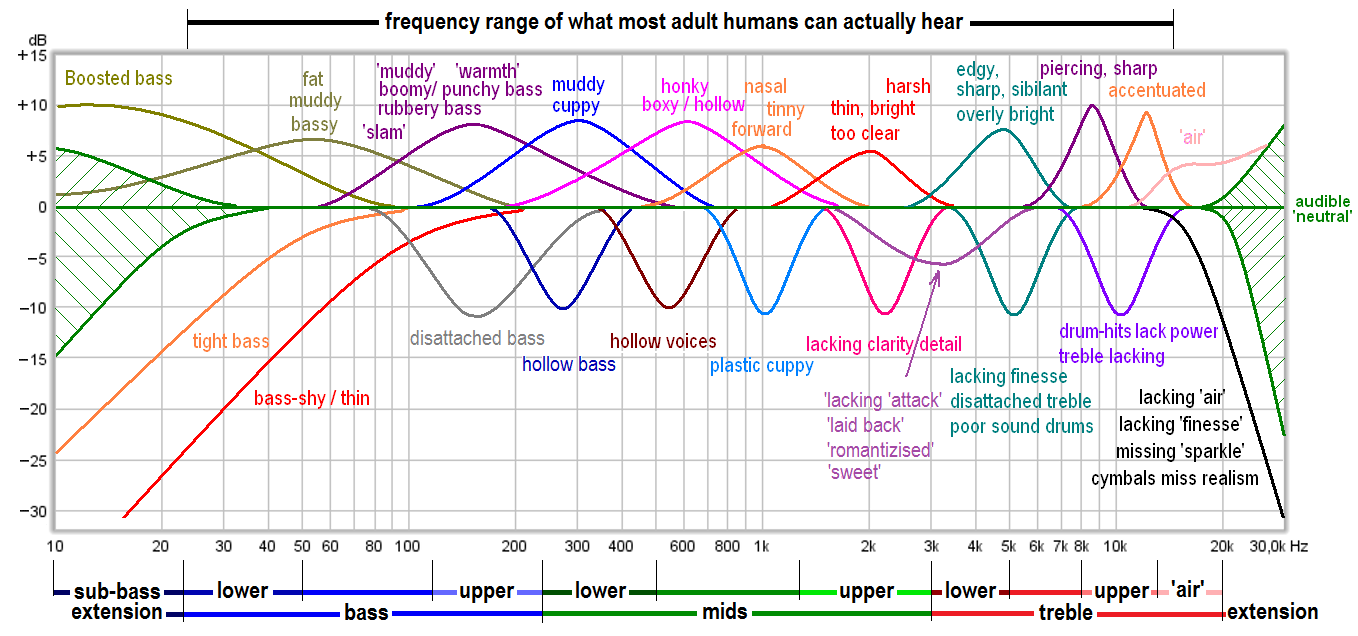
To understand what we hear in these frequencies, the image above depicts an interesting subjective breakdown of it from DIY Audio Heaven. This is by no means complete, nor is it scientific, but it is a helpful starting point.
For further reading on headphone frequency response, here’s a good reference.
Equalization
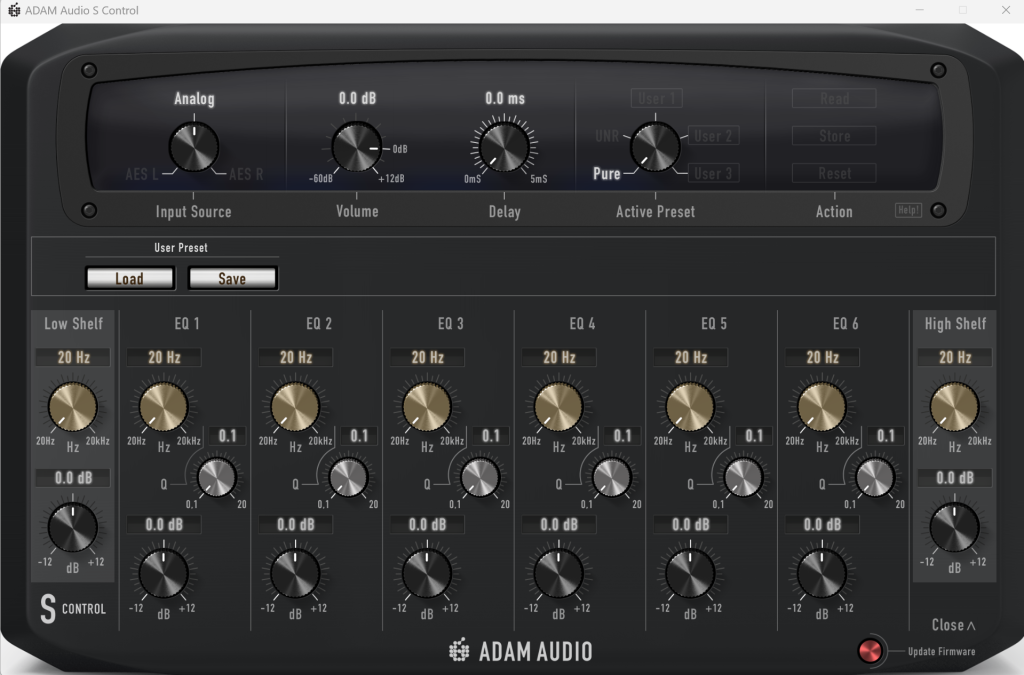
Most people have heard of equalizers (EQ), and know that they are used for adjusting sound at specific frequencies, i.e. raising or lowering the response at a given frequency. This is common in the pro audio world to create that ideal linear frequency response described in the previous section. But equalization also has flaws: it adds harmonic distortion. So when equalizing, you have to avoid creating audible distortion. Especially in the higher frequency regions.
The vast majority of speakers and headphones, and also severe EQ adjustments, have audible harmonic distortion on their own. This makes it more important to have a low distortion speaker and headphone, which is what is recommended below. Most of the best speakers have built-in EQ capability as shown above (DSP controlled studio monitors).
These days, the most popular enthusiast method for EQ is parametric equalization (PEQ), because it’s very accurate and gives you the most EQ control possible in the digital domain, which is less harmful than analog EQ in terms of added distortion. On that note, you do have to be mindful of digital clipping which can possibly occur even without an audible increase in harmonic distortion. This is what the preamp or pre-gain setting is for in equalization. The other common settings are the type of EQ filter being used, the gain (increase or decrease measured in decibels), the frequency to apply this to, and Q factor (how gradual the setting is).
Benefits of Parametric EQ:
- Can be used to correct sound, such as correcting room acoustic issues or speaker/headphone frequency response issues
- Can be used to color the sound to your desire
- Easy to turn on/off
- Entry cost is zero. It’s both far more effective and far more cost effective at experimenting with different sound signatures than purchasing different speakers, headphones, amplifiers, DACs, vacuum tubes, opamps.
- Building on the above, you can use EQ with a competent speaker/headphone (like those recommended in this article) to achieve another speaker/headphone’s frequency response, while avoiding the issues of the other speaker/headphone.
Drawbacks of Equalization:
- Using EQ to boost a frequency also inherently adds harmonic distortion. This is especially true with analog EQ, which is very rare nowadays. This limits how much you can boost frequencies before running into problems. This is why it’s important to prioritize purchasing speakers, headphones, amplifiers, and DACs with the lowest distortion possible. This article only recommends such equipment.
Don’t be afraid of EQ, just don’t boost to the point of creating audible distortion, and don’t expect good results when equalizing a frequency that suffers from bad phase issues in your setup – for example, no amount of EQ can perfect any speaker’s frequency response in a normal room.
While this is not an EQ guide, the most commonly used filters just for listeners (not music producers) are:
- Peak Filter: This is for raising or lowering the frequency response at a specific point, with the effect gradually decreasing from this point in both directions. How gradual this is depends on the Q factor: lower equals more gradual, causing the peak filter to affect a greater frequency range.
- High/Low Shelf Filter: Causes the rest of the frequency range above (high) or below (low) the given frequency to be either elevated or reduced. For example, my 7Hz x Crinacle Zero:2 IEM has too much bass below 50 Hz, so I apply a low shelf filter here that reduces all frequencies below 50 Hz only. Q factor represents the steepness or slope.
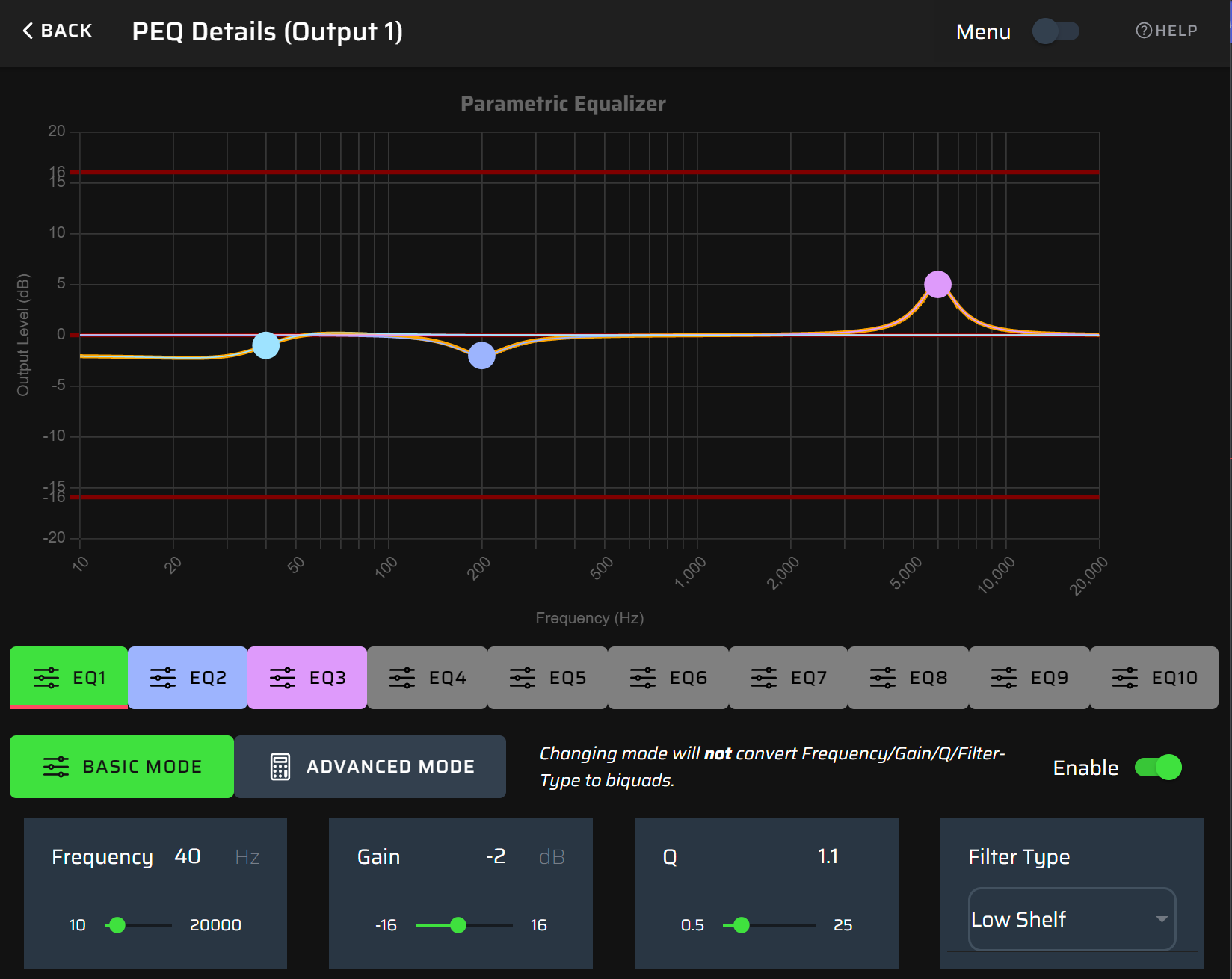
Not all issues can be solved with EQ. For loudspeakers, EQ can’t solve most room acoustic issues. Your best bet is to use Dirac Live or an alternative digital room correction solution, which requires investing in a DSP or A/V Processor that has this. Applying EQ to a frequency range that has severe issues with reflections/resonances (phase errors), whether those issues are in the room (speakers) or inside the device itself (speaker cabinet/headphone cups), is ineffective, and subject to create more problems, especially with higher frequencies. The measurement that shows such issues within a speaker/headphone is the group delay measurement, and in a waterfall/CSD measurement.
For example, if you look at my ADAM Audio S3V in-room frequency response posted earlier, we see massive shortfall from 55 Hz to around 150 Hz. This is happening because those frequencies are getting partially cancelled by reflections. The only solution is acoustic room treatment, which has its own section below.
For headphones, there’s nothing you can do about it besides physically mod the headphone and improve the dampening within the cups. Some people have done this with certain headphones, with mixed results. The Fostex T50RP headphone was one of the most modified headphones in this regard, and a few of those modifications were incredibly successful (ZMF Blackwood, ZMF Ori, MrSpeakers (now Dan Clark Audio) Alpha series). Therefore, for headphones, if you have the money you’ll want to get one with a good group delay and CSD measurement. Recommendations are below.
Digital room correction solutions like Dirac Live apply not only parametric equalization, but also adjust the impulse response to account for differences in how each individual speaker performs in your room. Your room is also measured at various positions during the process.
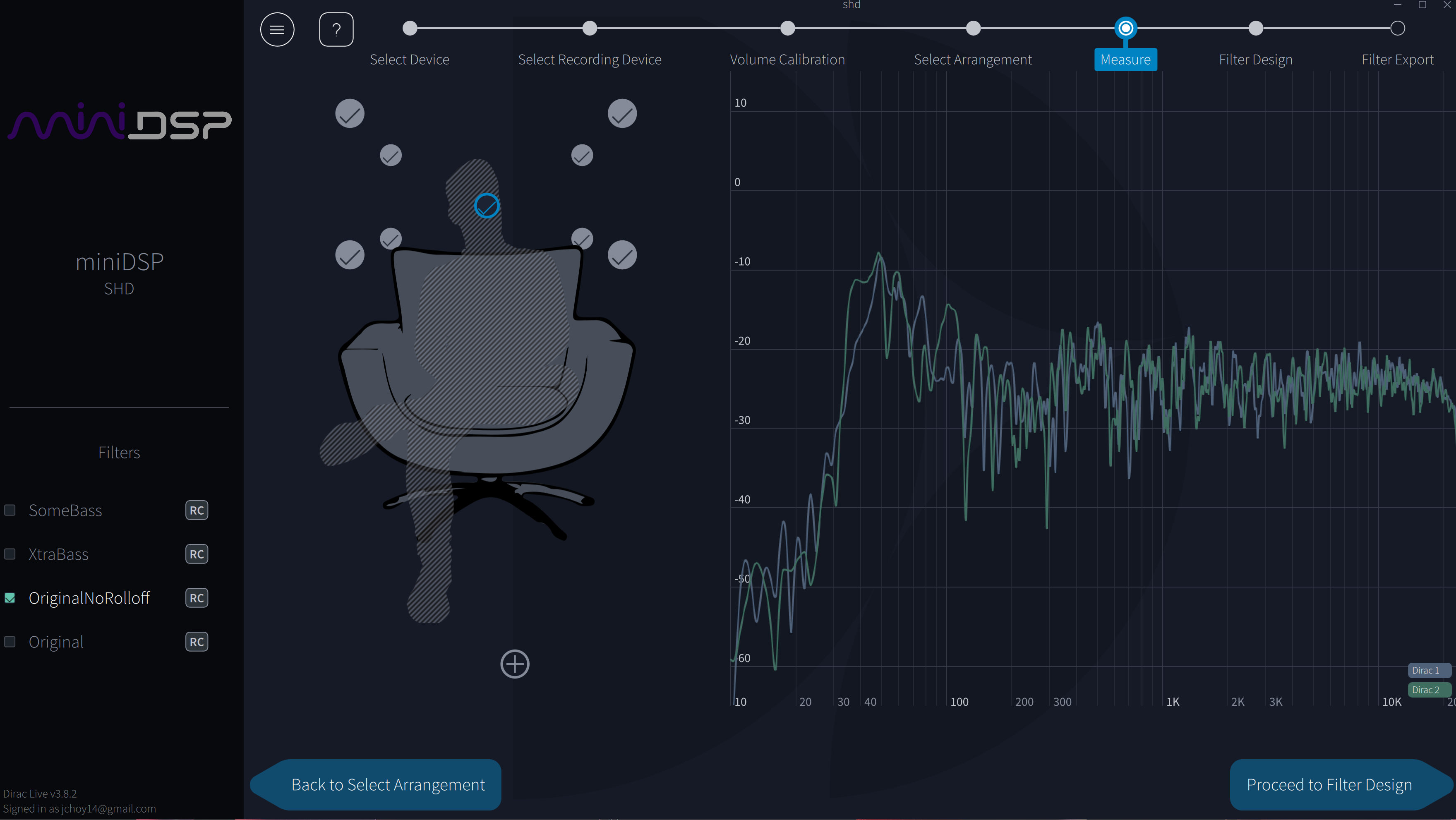
A possible downside to parametric EQ is that it is static – whatever changes you set are always made. Alternatively, there is dynamic EQ which is nonlinear, only applying EQ depending on what’s in the signal. Essentially, with dynamic EQ you define a decibel threshold – if and only if the audio signal exceeds this threshold, then your dynamic EQ will be applied. One reason this is liked is, it can lead to higher dynamic range. The application must be broader than that, but I can’t speak to this. The downside is its pro audio exclusivity; if you want to use dynamic EQ, you are stuck using plugins for mastering programs on computers (Windows or Mac) and probably can’t apply it system wide or to any music playback or streaming app.
If you want to equalize headphones, some very helpful resources include headphone frequency response databases with an equalizer function, letting you visualize your PEQ changes. Here’s Crinacle’s (if you are a Patreon subscriber, you can compare it to other target curves besides latest Harman and their own), here’s TechPowerUp’s with their ambiguous “Harman combined” preference (best to sanity check it versus Crinacle’s).
For importing PEQ settings to different EQ software, here’s a helpful web app.
Audiophile Common Terminology – Explained and Debunked
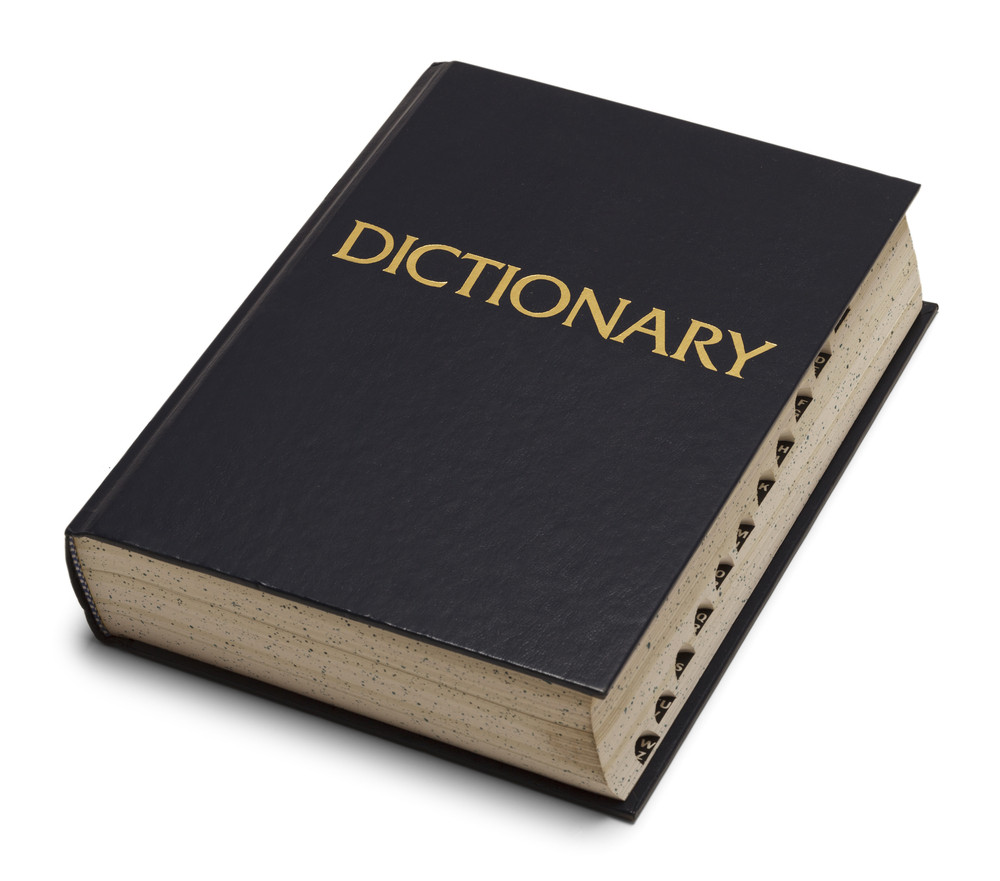
When reading audiophile reviews of any audio equipment, you’ll come across some key phrases they use to describe how something sounds. Here’s a list of them, of what they attempt to refer to, and, where applicable, why they misuse the terminology and make no sense objectively. Note that most of the terms described in the above frequency response image will not be redundantly covered below.
- Attack – also referred to as the leading edge of notes. Audiophiles (usually those with experience only limited to headphone systems, so junior audiophiles) like to make false claims about this, as if some headphones do only this aspect better than other headphones, or as if DACs and amplifiers (not dynamic EQ) affect this. Using common sense, this obviously would extend into the time domain, so what you’re really talking about here is impulse response. But good time domain performance (i.e. minimal phase distortion) isn’t perceived as just the leading edge of a sound being better, it is perceived as there being fewer reflected sounds since that’s exactly what’s happening.
- Black Background – refers to a lack of background noise, which may or may not actually be noise. Excess gain can result in us hearing background noise from a speaker/headphone, but this isn’t actually measured noise from the electronics that have too much gain. This can also refer to a headphone or speaker+room with minimal phase errors or phase distortion, as measured in group delay (measures time vs frequency), impulse response, and waterfall/CSD (measures frequency, time, and SPL): examples of this include an anechoic chamber (the best example) or the equivalent in headphones which are good IEMs and a few models from Dan Clark Audio (confirmed for the AEON 2 Noire, E3, Stealth, and Expanse, but likely also applies to the CORINA).
- Bright – refers to a headphone or speaker with a relatively high upper mid and treble frequency response compared to the rest of the frequency response. Audiophiles will sometimes apply this term to electronics, which is then a false claim – no DAC or amplifier has a relatively elevated high frequency response. In this case, what they really mean is – they are used to hearing recessed upper frequencies (typical of tube gear, R2R DACs, many headphones, and many audiophile loudspeakers) so when they hear something tonally correct, it sounds “bright” to them.
- Clinical/Analytical/Sterile/Cold/Not Musical – many audiophiles say that products that have a flat frequency response, along with other measurements that prove that they’re elite technical performers, such as studio/pro audio equipment (studio monitors or pro audio DACs/interfaces like those from RME, Topping, SMSL), have a clinical, analytical, or cold sound. This is used in a negative fashion, but if anything it’s a good thing since a flat frequency response and low distortion/noise are obviously good performance attributes. This term is very much tied into mental gymnastics, used by audiophiles to put down superior (and usually lower cost) sound gear, claiming that technically great equipment is “not musical.” This is clearly nonsense if you think about it for a moment: the music you’re listening to here is a digital audio signal, being played by your streaming service or on your music player software. The music is the music. Equipment with a linear frequency response and inaudible levels of noise and distortion play the music as intended by the studio that mastered and released the music. Whereas, these audiophiles are trying to claim the opposite – they prefer audio gear that colors, or taints, the sound because a nonlinear frequency response does exactly that by playing some frequencies at a very different volume level than others, and by introducing noise and distortion. Distortion is literally audio information not present in the recording. The opposite audiophile term for these is “warm.”
- Dark – as expected, the opposite of bright. This refers to headphones or speakers in which lower frequencies dominate the frequency response, recessing the upper frequencies. Audiophools might apply this to electronics too, which is again false: no measured electronics have a dark or bright frequency response as such.
- Decay – refers to how long a sound lingers before vanishing. This is effectively measured by impulse response, group delay, and waterfall/CSD, but audiophiles who use this term generally don’t know what any of these mean so they’re very misleading when bringing this up. Give this a read, but ultimately, the cleaner the group delay/CSD measurement/impulse response, the faster the decay so to speak. Cleaner means fewer reflected sounds reach your ears, which means less phase distortion. This is achieved by room treatment with speaker systems, or effective damping in headphones. IEMs naturally excel the most here.
- Dip/Valley – a sharp and brief drop in frequency response
- Dynamics – it should refer to dynamic range – the difference in volume (sound pressure level or SPL) between the quietest sound and the loudest. So in that regard, it relates to the crest factor of a waveform. Audiophiles however tend to use this inconsistently and inaccurately. Dynamics can obviously be measured easily. Some audiophiles like to claim that certain transducer types in headphones have greater or lesser dynamics than others, but these are false claims with no data to back them up. Elevated mid-bass and upper-mid or treble response can present the illusion of greater dynamics, or instead contribute to one of the most hilarious audiophool terms, “PRaT” which is defined below.
- Forward – refers to a speaker or headphone’s sound presentation that makes sounds out to be closer to you. Obviously a “distant” sound would be the opposite.
- Fullness – ultimately the same thing as warmth which is defined below
- Imaging – refers to the precision of sounds coming from a speaker or headphone. More precise imaging means it’s easier to pinpoint where sounds come from. The best way to experience this with headphones are with the Sennheiser HD 800 or HD 800 S headphones and binaural audio.
- Impact/Slam – refers to bass impact. Elevated mid-bass contributes to bass slam, while elevated sub-bass makes bass rumble more.
- Lush – audiophile colloquial term generally used to refer to a warm sound signature that also has a rolled off or even recessed treble region. More on roll-off and recession below.
- Musicality – audiophile drivel that just means they like what they hear
- Peak – a sharp and brief elevation in frequency response
- Plankton – some kind of nonsensical audiophile term attempting to refer to low level details or something, utterly meaningless and unfounded
- PRaT – stands for “Pace, Rhythm, and Timing”. Means absolutely nothing technically, though may be used to refer to headphones or speakers with an elevated mid-bass and treble response like described above. Or not. Really, audiophiles just tend to use this to describe anything they like. If they like something, it has good PRaT. If they don’t like it, it has bad PRaT.
- Recession – an audible reduction in frequency response
- Shrill/Etched – sort of like bright, but even brighter. Refers to equipment with not only an elevated high frequency response but also distorted (they might claim otherwise, but what they describe does amount to distortion and nothing else). Often misused by audiophiles the same way “bright” is.
- Sound Stage – refers to the perceived area that sounds come from, so a larger sound stage means the sounds seem to come from a larger area.
- Speed – not the drug. In audiophile land, this is pretty much meaningless. You’ll often see headphone audiophiles claim that electrostatic headphones have more “speed” although you never see this claim in the loudspeaker realm. If you want to claim something in the time domain, then look at impulse response, group delay, and CSD measurements. Something that excels there can feasibly be called fast, but this is not what audiophiles mean as they don’t look at or understand measurements.
- Roll-off – refers to a frequency response that drops off to 0 dB, so it’s at either end of the frequency response of the equipment. For example, (early) treble roll-off means that well before 20 KHz, the frequency response drops to 0.
- Transparent/Clear – generally refers to sound equipment with no audible levels of noise or distortion of any kind, but colloquially means not only this but is reserved for speakers/headphones without a very dark or warm sound signature.
- Warm – technically this refers to an elevated mid-bass response that causes all other sounds to have more bass in them, which has the secondary effect of bringing those sounds “closer” to you, making for a more “forward” sound signature which was described above.
- Wet – another on of the funniest audiophool terms. It’s absolutely meaningless, but they tend to use it in conjunction with “decay” and apparently it’s the opposite of “fast.” Just ignore it.
Over 95% of “Audiophile” Products are Highly Inaccurate
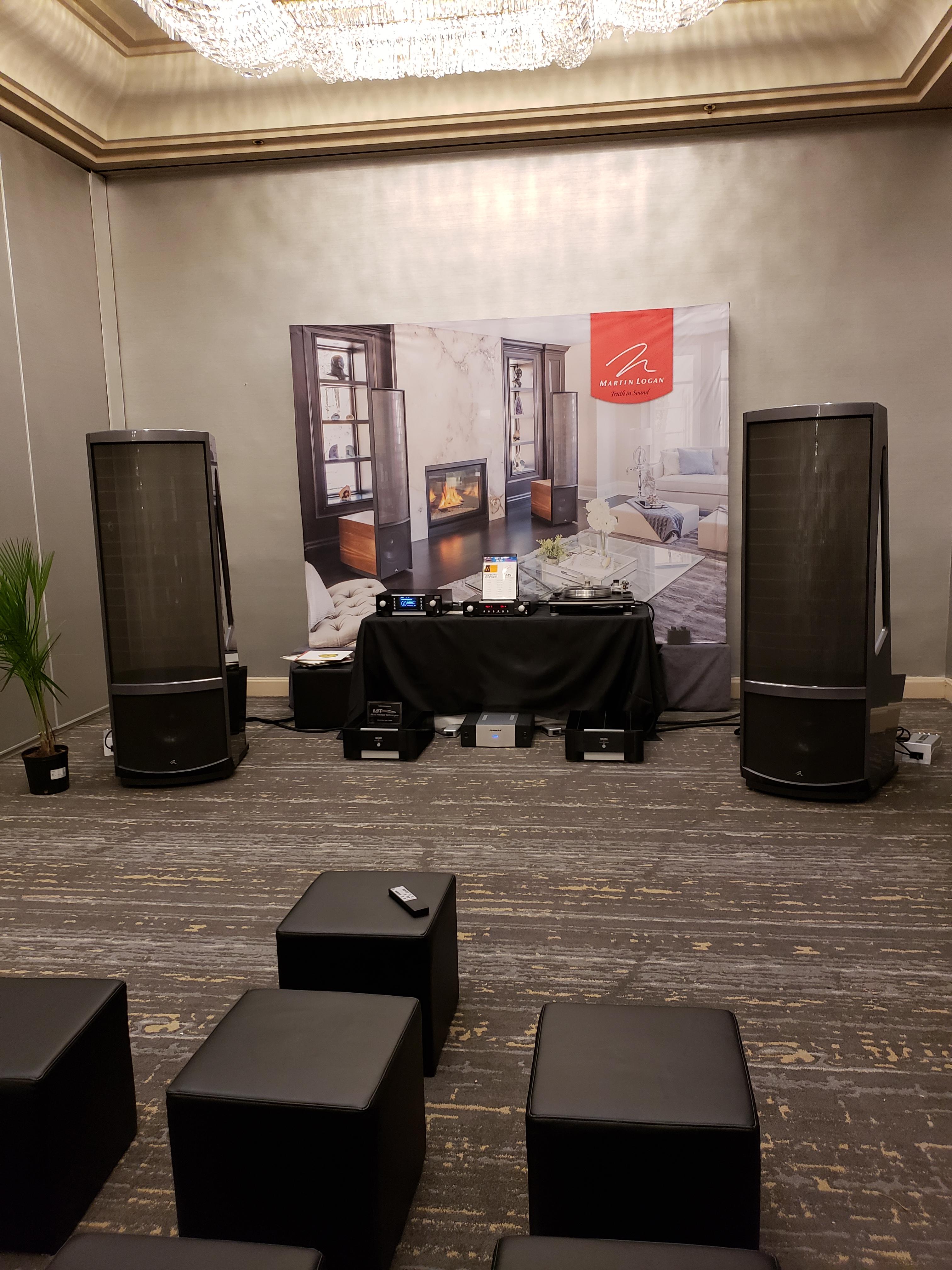
The “audiophile” industry isn’t about the pursuit of high fidelity sound, it is about fashion – about boutique speakers, headphones, and electronics that look cool and are super expensive. This is most prominently displayed in speakers with 4-6 figure price tags with fancy wooden enclosures but poor sound quality, vacuum tube amplifiers which all measure very poorly and can’t resolve 16-bit audio (the minimum), and very fancy looking DACs that likewise can’t resolve 16-bit audio, as explained below.
The reasons for this discrepancy in price and performance for high end audio equipment is, the really expensive audiophile stuff generally uses decades out of date technological design that performs horribly compared to what we have today at lower price points. But this does succeed in one of their goals: providing nostalgic sound for their older audience. As with any technology, it improves considerably over the years and thus price to performance improves significantly. Advancements in material science have led to transducer technology (e.g. speaker cones or domes) that performs better in every metric: more linear frequency response, lower harmonic distortion, higher maximum SPL, etc. Such research has also led to innovations in damping materials for speaker cabinets and headphones, such as eliminating standing waves and killing off harmful resonances, resulting in better group delay/CSD and significant performance improvements.
Advancements in computer design have led to the introduction and rapid improvement of DSPs or digital signal processing in speakers and audio electronics. Modern studio monitor speakers for example employ DSP for various forms of precise equalization (EQ), improving the linearity of the frequency response. While boutique “audiophile” speakers are just transducers in a fancy enclosure without the latest research in transducer design or damping materials, and only passive crossovers, resulting in significantly less linear frequency response, worse group delay/CSD, higher distortion levels, all for more money.
Research led by Harman throughout the 2010s has led to a much better understanding of how humans perceive the frequency response of headphones. So as with speakers, headphone technical performance has improved drastically over the years for those that follow the latest research.
Audio electronics (DACs and amplifiers as far as consumers go) have also seen significant evolution in the last 10 years. Several breakthroughs have occurred in amplifier design, resulting in the simultaneous benefits of: significantly increased performance in every metric, yet simpler designs with lower material costs resulting in smaller, less expensive devices. This is nothing new: electronics improve, shrink, and go down in price over time.
Unfortunately, the consumer hi-fi (audiophile) industry actively works together in order to suppress measurements/data in order to continue selling poorly designed, obsolete products for ridiculous prices.

This technological improvement in affordable products was very evident in the early 2010s with the release of the now iconic Objective2 headphone amplifier and ObjectiveDAC (ODAC), which were designed with the most cutting edge research at the time resulting in a sub $150 headphone amplifier and DAC (each) producing the best measured performance of all time. This was soon followed by THX headphone amplifiers setting new benchmarks, delivering performance even better than the Objective2 plus more power. After JDS Labs and then THX, then Topping, SMSL, and Gustard caught on and started delivering similar excellence. Similarly elite headphone amplifiers but with even more power than the Objective2 gained more popularity through Drop (formerly Massdrop) using THX amplifiers. These all changed the game.
Similar breakthroughs occurred in the power (speaker) amplifier industry in the mid 2010s starting with Benchmark (not surprising for that company as they’re usually industry leading), followed by Hypex and then Purifi revolutionizing Class D amplification in the late 2010s. Many of these were nested feedback, also known as composite amplifiers, which brought higher levels of performance than ever seen before, and this performance is achieved without great expense because it’s very efficient.
The drawbacks of Class D amps of past were: high frequency rolloff (even though those same audiophiles like their Class A tube gear that does the same thing), higher distortion, load dependent performance, and possibly switching noise increasing the noise floor – but less of an increase than what vacuum tubes or transformers in the signal path add! Hypex, Purifi, and others like 3e Audio have since overcome all of these limitations.
Because of this progress, the manufacturers of those now outdated, hugely inefficient, worse performing amplifiers attack these new and improved designs to this day, inventing concepts such as, “Global feedback is always bad! Ruins sound stage!” with no data to back this up. Because humans unfortunately have a tendency to develop brand loyalty (exactly what corporations want, this only hurts you) and also overwhelming nostalgia (in this case for oversized, fancy looking, outdated sound equipment), the customers of these audiophile snake oil brands also attack these newer, better-in-every-way products and go as far as claiming that, “There’s no correlation between measurements and sound quality.” This is an actual quote an audiophile to me directly. So they believe what we hear cannot be measured… so how does sonar work? How does sonic weapon R&D work? How does the audio industry work? People like this are why the term “audiophool” was invented.
Similarly, audiophile discrete DACs all perform poorly compared to more modern designs. They do not have the engineering resources to compete with the DAC integrated circuits (ICs) produced by ESS Tech, AKM, ROHM, Cirrus Logic, Texas Instruments – big tech companies with resources and R&D that audiophile companies have no hopes of competing with when it comes to developing products that actually perform.
As a result of this, we have $80-130 DACs that outperform all the 3-6 figure price tag boutique audiophile DACs. Yes, $80 outperforming $150,000, but that’s because the $80 one was designed to perform unlike the $150k one. There’s no catch. It’s modern superior electronics vs extremely outdated technology, and in this case failed technological design philosophy (R2R D/A conversion). More on this specific example later.
On that note, here’s an article by Tom’s Hardware in which two very different listeners couldn’t reliably single out a top tier expensive DAC vs inexpensive ones in blind testing. And yes, a complete set of measurements tells the whole story about the performance of audio electronics, as well as speakers/subwoofers and the room they’re in. The only exception to this are headphones, particularly on-ear and over-ear, for which we can’t measure frequencies above 8 KHz with precise accuracy due to the nature of ear canals and simulated head measurement systems. Otherwise, we know how to measure everything about them when it comes to their sound quality, and some reviewers do. And the audiophile industry hates that.
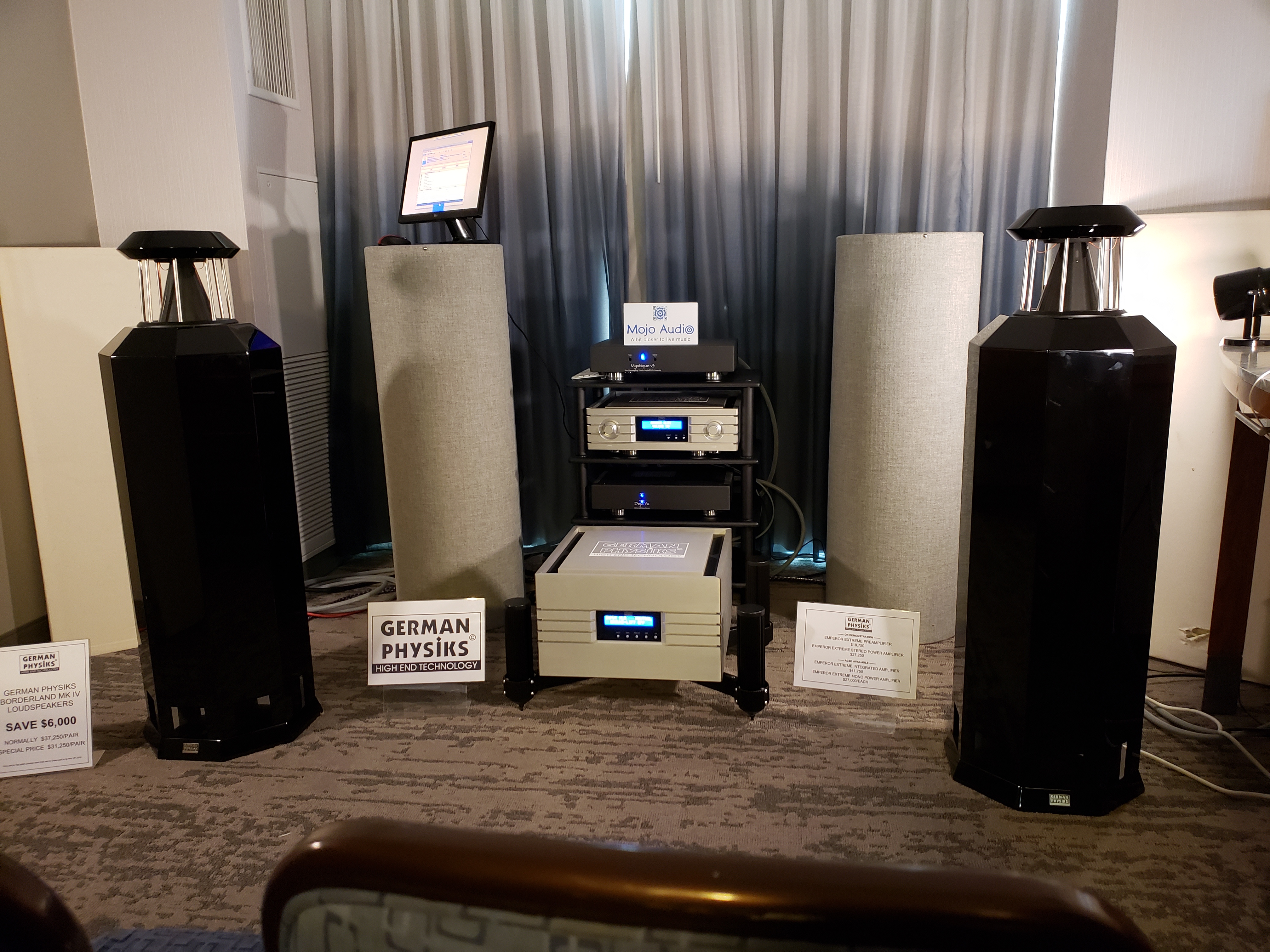
The super expensive boutique audiophile speakers, most headphones, and electronics have not adopted these improvements nor this latest research. For the electronics, it’s because it goes against their design ethos: expensive boutique audiophile gear isn’t actually high fidelity gear, it’s furniture. For the electronics to look impressive, they have to be huge, heavy, classic (hence the continued presence of vacuum tubes and vinyl), expensive, shipped in wooden crates even. While modern superior electronics are small, light, and generally affordable. The same goes for speakers: there’s no legitimate functionality in having 3m tall loudspeakers with 7+ transducers and tweeters way over your head not pointing down. On the contrary, all of this expensive furniture performs far worse. The proof is in the pudding, and this will be presented later in this article.
Moreover, generally speaking the ultra high end of hi-fi isn’t actually about high fidelity reproduction, it’s about recreating the sound that was produced by 20th century systems with vacuum tube amplification and vinyl. Remember: analog/vinyl fidelity is in the realm of 11-13 bits, while digital is 16 or 24 bits. So once again, nostalgia leads to regression, as it has in our most common topic on GND-Tech – video games.
Try to avoid buying equipment for which the manufacturers provide no measurements, or overly vague and meaningless measurements. Unless perhaps if there’s a good return policy you can use. Sadly, most hi-fi equipment is like this: minimal to no measurements and misleading, vague, dishonest specs. Turns out they are hiding things, as reviews that take measurements reveal.
The “audiophile” (consumer hi-fi) industry has earned the nickname “audiophool” for good reason. The vast majority of it consists of overpriced equipment that measures poorly and thus sounds inaccurate to us. Measurements such as non-linear frequency responses, messy group delay/CSD suggesting bad internal resonances/reflections further disrupting the frequency response, audible distortion, flawed time domain, and possibly more.
The industry plays off of placebo, nostalgia, and psychology: “More expensive and cool looking gear MUST perform better!” Audiophiles have a lot of money to spend on this furniture, so sell them cool looking equipment for an outrageous price that does sound immediately different – due to the presence of audible distortion and limited dynamic range usually. They hear these differences, or they hear no differences but are listening to the music more carefully than before, determine said equipment sounds better, and so the snake oil sells.
I have even spoken to audiophiles, beyond just the one quoted above, who outright believe that they can hear things that are impossible to measure. In reality, our ears are poor, low resolution measuring devices unlike good microphones. Our hearing is also unreliable as it is subject to bias and can change based on things like mood, fatigue, having your jaw clenched, having your ears clogged, not sitting in the exact same position, and of course placebo and bias.
I’ve even encountered electrical engineers working in this field who believe that measurements and data driven reviews are irrelevant and should be avoided. Of course, that’s because they work for these snake oil companies and they need to make a living. There are only a few brands producing audio equipment designed to actually perform, so one benefit of the snake oil audiophile industry is that it creates jobs. Overpriced boutique audiophile gear is not an investment though as it all depreciates rapidly, sorry to disappoint anyone who was hoping otherwise.
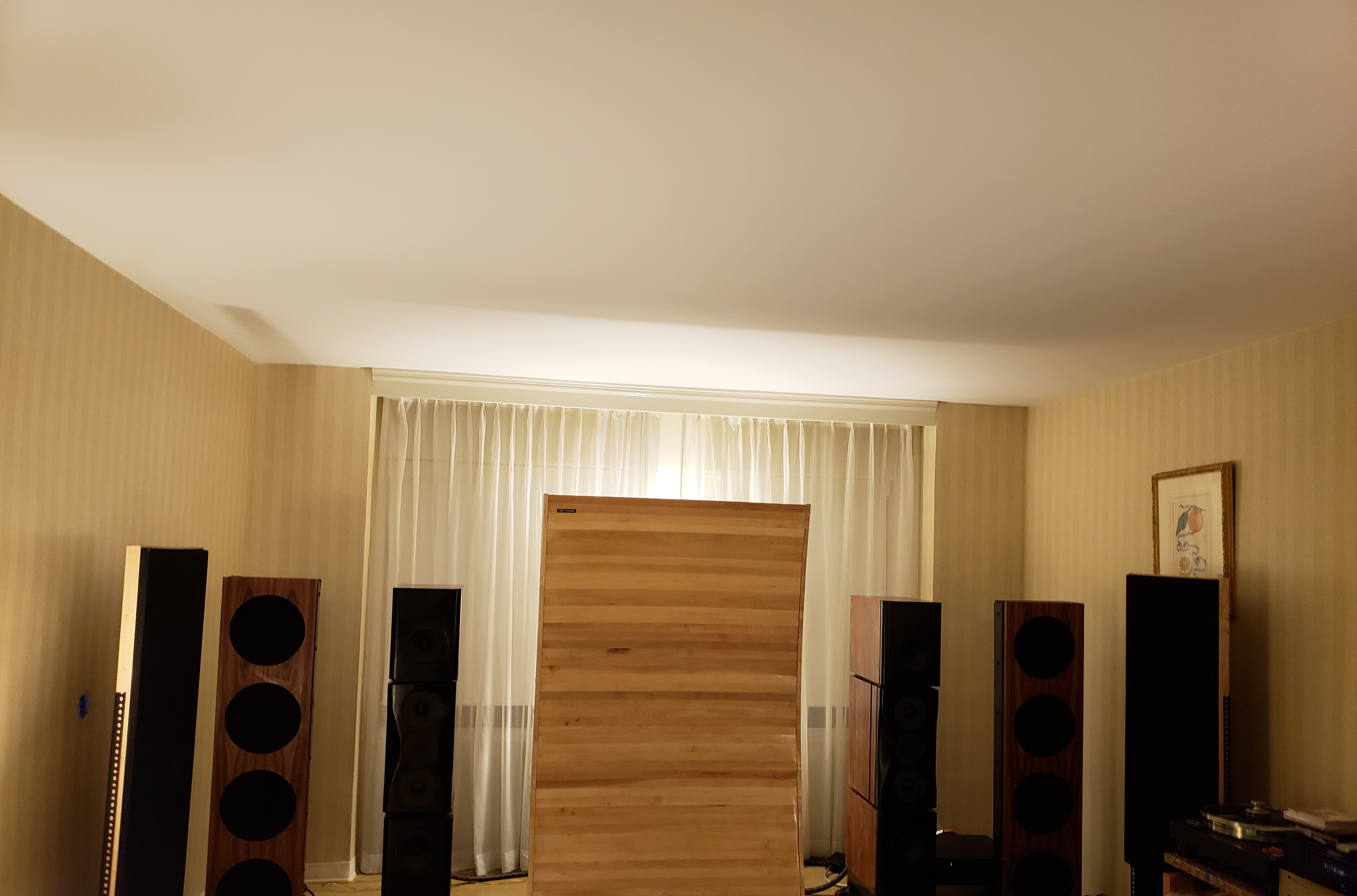
Let’s review some examples of audiophile grade snake oil. I was once at an audio show where some audiophool company was trying to sell some wooden boards for $30k, pictured above. Yes, just some 2x4s stuck together to form a wall for $30k. It was nothing more than that. They were saying that by placing this in between your speakers, it improves the perceived spatial properties. Even if it did, you can just nail together some 2x4s yourself. This is the audiophile industry in a nutshell, and this is apparently the audiophool’s idea of room treatment.
See for yourself: look at how the popular $17k Klipschorn AK6 loudspeakers measure. Horrendous in every metric, and for the frequency response, that almost looks like what I’d expect from a speaker with no tweeter! The impulse response is atrocious. It’s one of the worst measuring speakers out there, and it’s $17k. It’s a piece of furniture – it’s built to decorate a room, nothing more.
But perhaps my favorite example of this are the 5-6 figure priced custom resistor ladder (R2R) DACs (digital to analog converters), especially the non-oversampling ones, such as TotalCRAPDAC. Every time I hear such a DAC, they sound “soft” and muted because of audible distortion (especially the non-oversampling/filterless ones that don’t filter noise and jitter from the digital signal), as well as blatant treble rolloff (so many can’t reproduce audible output above 18 KHz). It also doesn’t help that this expensive paperweight can’t transparently resolve 16-bit audio, though our listening conditions (including volume) make this a nonissue. In any case, these non-oversampling DACs sound terrible, and that review for the TotalDAC proves it.
That TotalDAC, with its 5 figure price tag, achieves a SINAD of 84 dB, although it does achieve 113 dB dynamic range which is decent but not state of the art, and it doesn’t quite have 16-bits of distortion free range for 16-bit audio. It also fails to achieve a linear frequency response, which you really don’t want from a DAC, and it has issues with intermodulation distortion (IMD). Most shocking of all though: its distortion is directly proportional to frequency! This is because this is one of those DACs with no reconstruction filter, so it’s just highly inaccurate at converting digital signals to analog across a range of frequencies, which is the devices only job. For five figures. It also has a useless garbage headphone amp built in.
Keep those numbers in mind while we look at another audiophile favorite DAC brand: PS Audio. Many swear by their DACs such as the PerfectWave DirectStream ($6,900) and Stellar Gain Cell ($1,700 and supposedly a bargain). Very deceiving names as the measurements show they’re anything but perfect and stellar. The former achieves a pathetic SINAD of 76 dB with 0.02% THD+N! The latter is indeed worse with a SINAD of 58 dB with 0.1% THD+N – one of the worst DACs ever measured! Truly abysmal. The $6,900 one has a dynamic range of 93 dB which is about 15.3-bits – still beneath 16-bit audio which is the musical minimum (even MP3 music is 16-bit). Furthermore, both fail to achieve a linear frequency response largely due to audible noise problems, and both have IMD problems. The $1,700 one has jitter issues, and get this: the $6,900 one only has a distortion free sound range of 10-bits, while the $1,700 one has 12-bits – both pathetic results, neither device can playback 16-bit audio properly. Apparently PS Audio uses output transformer coupling in these devices, so most of these performance issues are presumably transformer induced distortion ruining the analog signal. Hilarious.
And no, the DirectStream Mk2 is no better. See Stereophile’s measurements. It still has an output transformer coupled output stage, and therefore it’s still full of audible noise issues and nonlinearity in the audible band. This is supposed to be a sine wave!
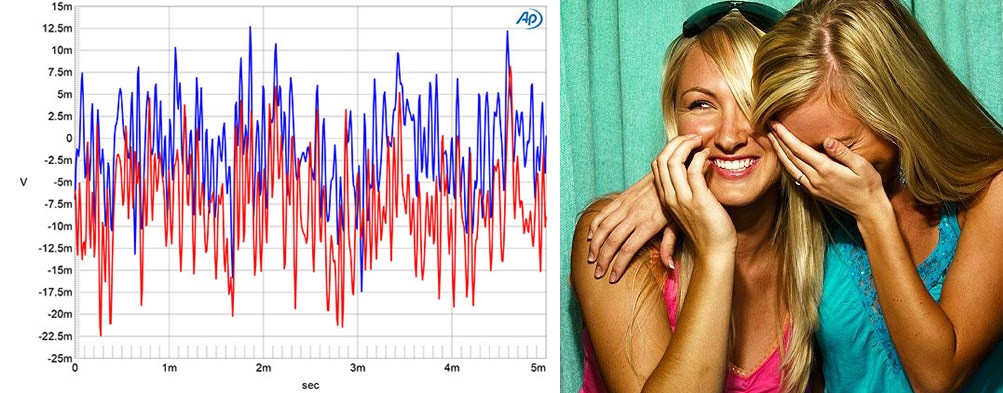
Now compare the numbers for the TotalCRAP and two PS Audio DACs (Piece of Shit Audio?) to the $150 Topping E30 II DAC: 118 dB SINAD (0.0001% THD+N), 119 dB dynamic range (20-bits), supremely low IMD, no jitter issues over USB, slight noise at -120 dB in the linearity test, 22-bits of distortion free range. The Topping annihilates those super expensive DACs, and every other super expensive DAC.
It gets even better: onboard audio performs much better than the above uber expensive DACs!
Another excellent example of this is the $5,650 Chord Hugo M-Scaler. This is a simple standalone upscaling device (totally unnecessary in principle) for which the only fancy parts are the software and the chassis/lighting, not any of the cheap hardware inside. As the measurements show, it destroys the overall performance of 3rd party DACs (which is fine – not the intended use but audiophools recommend using it with 3rd party DACs) by ruining the THD+N and dynamic range, it’s full of jitter, and even for the Chord DACs it’s meant to be used with, it has no measurable benefits. And this is measured with far more precise instruments than our ears. Pure snake oil.
Also, the DAC meant to go with the Hugo M-Scaler, the $6,725 Chord Hugo TT 2, performs about the same as the $80 SMSL SU-1. There’s no catch, this is what audiophoolery is. Don’t get me wrong, I know the TT 2 is also a headphone amp unlike the SU-1, but that headphone amp is a terrible one. If you want a DAC+headphone amp device, some are recommended below starting at $190 which significantly outperform the TT 2 in every way except headphone amp power output capability, but who cares about power when your amp is junk and not close to transparent for 16-bit audio in the first place?
Check out the Mytek Brooklyn Bridge II. Not only is it full of power supply noise and not only does it also get destroyed by the $80 SMSL SU-1, but look at the massive rise of THD+N with frequency within the audible band! From around 0.003% THD+N to almost 0.2% at 10 KHz, and then it clips before even reaching 20 KHz!
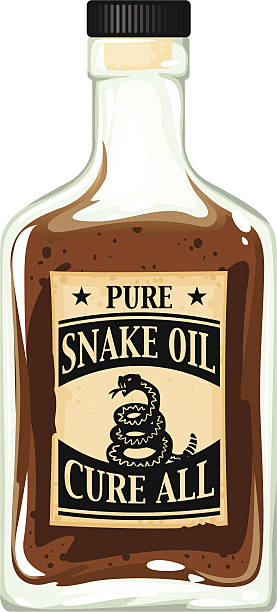
Audio electronics are relatively simple to evaluate. Everything about audio electronics that can affect sound quality, we know how to measure and they are measured in proper reviews. The data proves that the best DAC chip is the ESS Sabre ES9039PRO, the best consumer DACs are made by SMSL and Topping using ESS Tech DAC ICs, the best consumer stereo preamp is the Benchmark LA4 followed closely by the Topping Pre90, the best low power 1-2 channel speaker amplifier is the Topping LA90/LA90 Discrete, the best powerful 1-2 channel speaker amplifier is the Hypex NCOREx NCx500, the best low to mid power headphone amp is the Topping L30 II, and the best performing powerful headphone amplifier is the Topping A70 Pro. Measurements don’t lie, but perception can thanks to bias and placebo.
This is why properly conducted blind testing is important. Such blind tests need to have matched volume, and there shouldn’t be a significant time delay between listening to item A vs item B. For example, if you want to evaluate different DACs, it would be best to do so using a speaker system with a preamplifier that has both DACs connected to it. Or a headphone amplifier with multiple inputs with each DAC connected to it.
The job of audio electronics is simple: first of all, the amplifier must be able to continuously, safely deliver the power you require in order to get your desired SPL. Beyond that, if you’re spending more than pennies, they must be transparent for 16-bit audio across the entire audible frequency range (20 Hz – 20 KHz), and this must also be true when delivering the power required for your desired SPL. This means a SINAD and dynamic range of over 96 dB (technically overkill but this should be the standard for anything not cheap), as little noise and distortion as possible (both harmonic and intermodulation distortion). This level of performance must be maintained regardless of the impedance of your speakers/headphones. Furthermore, they must have a flat frequency response across the entire spectrum regardless of the load, have no audible channel balance issues, no audible crosstalk issues (nonissue these days), and DACs should have a digital filter with very sharp/accurate cutoff and excellent attenuation. That’s all. We know how to measure it all, and the reviewers recommended above do.
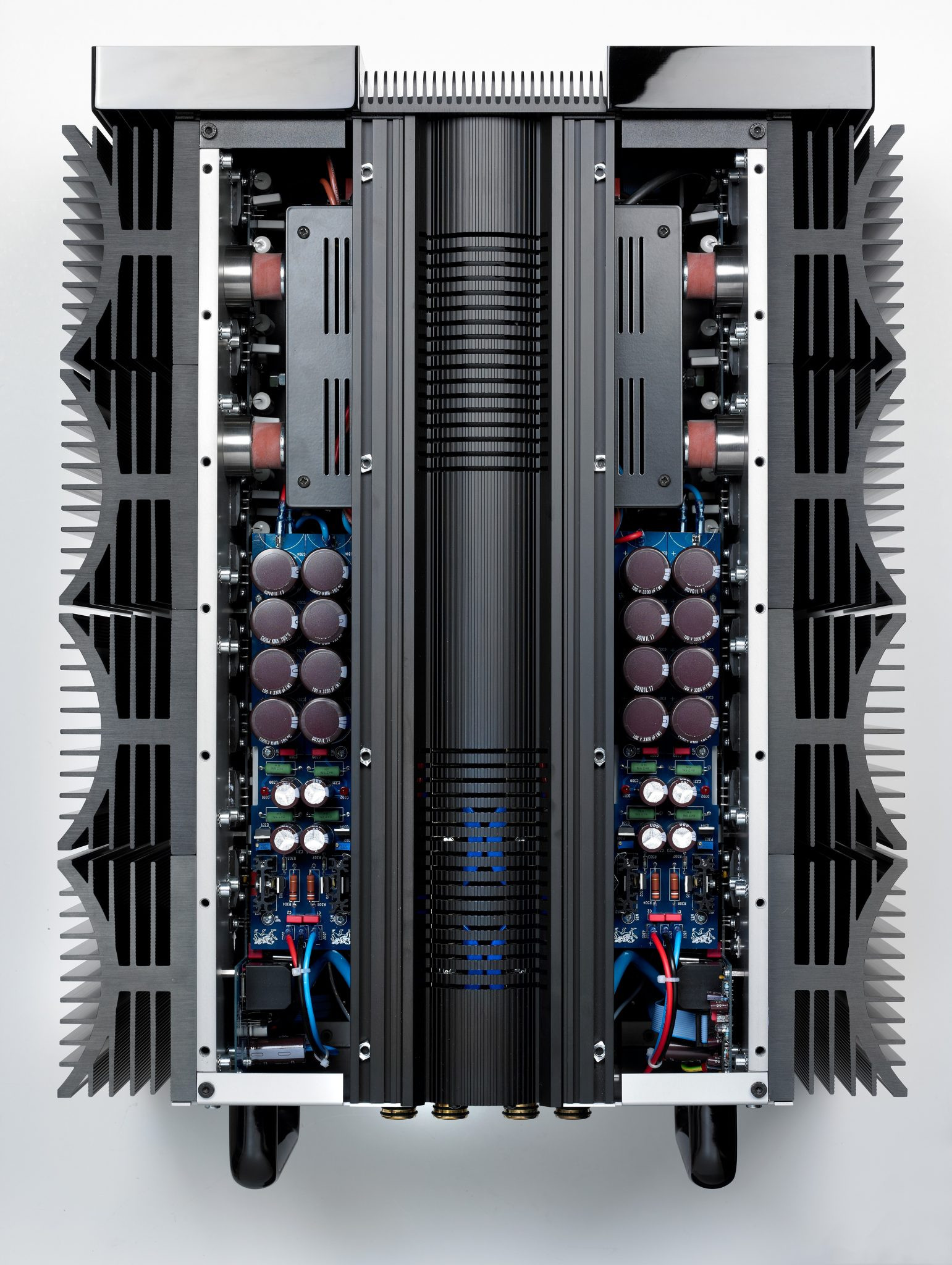
Your electronics shouldn’t look like this, if you care about performance
However, you don’t have to chase perfect measuring devices, because of our hearing limitations and listening conditions. As shown in the two blind testing case studies linked above, a good budget DAC sounds indistinguishable from a state of the art one, and 92 dB vs 78 dB SINAD doesn’t appear to make an audible difference. These are limited studies, but Audio Science Review forums have had many like that, turning up the same results. Try it for yourself though with proper blind testing.
Also check out the $6,000 HiFiMan Susvara headphone. That’s right, a $6,000 headphone – this is absurd to begin with, and the measurements audible distortion peaks at 94 dB (in one of our most critical frequencies of 4-5 KHz) and lots of resonances. It is not designed to sound accurate, because it absolutely does not. Did the manufacturer provide any measurements? Nope, only professional audio products do. Was the product advertised as having some sort of special, non-neutral sound? Nope, although knowing the HiFiMan product range, it may have been going for some sort of concert hall sound. It does have a more distant sound presentation, and is designed to not offend its older audience who generally want a more “smoothed” sound. The product page however advertises it as some sort of top technical performer, but it’s far from it. But it is safe to say, accuracy was not a goal. You can get the same sound signature with better technical performance from some of their much less expensive headphones like the Arya.
So throughout this guide, I will emphasize accurate equipment because it’s the safest bet and the most logical reference point. I would say people (with extensive audio gear listening experience, so not your average person who only has experience with Apple products) generally fall into a spectrum of listening preferences, somewhere between a preference for: #1 very accurate sound, #2 generally accurate but elevated bass slam, and #3 generally accurate but somewhat reduced treble response due to sensitivity to higher frequencies that appears to come with old age (before they lose the ability to hear those frequencies entirely). But this is just my observation.
Blind Testing – The Cure for Audiophilia
Not everyone wants to read through a bunch of data, and as helpful as that is, proper level matched blind testing always has its merits. There’s no better way to prove to yourself that 5-6 figure priced audiophile electronics, or things like fancy upscaling and DSD, are audibly the same or worse than what’s recommended throughout this article. This is the main use case for blind testing, as blind testing speakers is difficult, while for over-ear and on-ear headphones it’s impossible as you can identify the headphones by feel (unless you don’t know which headphones are being tested).
Why is blind testing so important? Because of listener bias. With sighted testing, your mind will invent differences that aren’t there. You may subconsciously prefer the better looking or more expensive gear, which is a definitive trend in this industry. Proper blind testing takes all of that bias away. It has to be level-matched and you have to be able to switch rapidly between the products. Like everyone else who has done such testing, I’ve found that I actually cannot distinguish between certain pieces of audio electronics that, with sighted testing, I thought I could distinguish.
The difference between an “educated listener” and one who isn’t has also proven to be important in controlled listening tests. See the video above to find out more.
Reviews
The vast majority of reviews for audio components are useless and purely subjective, made up of people commenting on how something sounds to them which varies per person. As far as audiophile reviews go on all the most common publications, this typically devolves into the reviewer romantically describing how they find the equipment to sound with various songs that they like. It’s pure entertainment, not informative. They also don’t do proper, level-matched blind testing ever, because that shatters audiophile illusions.
Other people’s subjective listening impressions mean next to nothing, especially considering most are not “educated listeners”, people are generally unaware of or ignore psychoacoustics, almost all reviewers avoid proper blind level-matched testing, and we all have different preferences as to what we hear. Proper blind testing takes the fun out of it for these people, and it challenges their biases which is one of the main reasons it’s avoided.
All speaker reviews should measure the speakers with a Klippel NFS. All headphone reviews should measure the headphones with a B&K BK5128, GRAS 45CA, or GRAS 45CC. All reviews of audio electronics (DACs, amplifiers) should measure them using the appropriate Audio Precision analyzer and supporting equipment, and if they’re using the significantly less precise APx515B or APx516B, they must factor in the precision loss for every measurement.
For proper reviews that use standard testing and measurement methodologies to provide real data, refer to the following:
- Erin’s Audio Corner (the best, most complete speaker reviews out there)
- Audio Science Review
- Audioholics
- Home Theater Review
- Stereophile (measurements section only) – skip to the measurements section because they’re in the business of selling audiophoolery, which is immediately evident in their awards and subjective listening impressions especially when they contradict the measurements (often). So this makes them similar to Userbenchmark in that regard. Unfortunately their site design is stuck in the 2000s and there’s no proper search engine. Google dorking is the best way to search the site.
- Innerfidelity (now part of Stereophile, again the measurements are most useful)
- Zaph Audio (no longer active)
- DIY Audio Heaven
- Spinorama (speaker frequency response comparisons)
- Reference Audio Analyzer (no distortion measurements though, so it’s only useful for frequency response comparisons)
- loudspeakerdatabase
- Super Best Audio Friends measurements
- To a lesser extent rtings for headphones
Crinacle also has a useful feature for comparing the frequency response of various headphones versus the Harman targets, and more. But frequency response is just one measurement, and while it is the most important one for a headphone or speaker, it doesn’t paint the whole picture.
Unfortunately not all of these places feature complete reviews, so you will often have to cross-reference reviews from multiple sites above to get a complete picture of the data. A proper speaker review must test against CTA-2034 standards, and any additional tests on top of that might be welcome if they’re practical, as Erin from Erin’s Audio Corner does.
A complete headphone review should provide all the data from B&K BK5128 or GRAS 45CA/45CC measurements. The most important data for us viewers to look at are the frequency response (raw and plotted against the relevant Harman preference curve and the Harman linear in-room ideally), harmonic distortion vs frequency response at multiple SPLs, group delay, impulse response, and waterfall/CSD.
A complete DAC review must be conducted at a commonly attainable output voltage from the DAC, such as 2v single ended and 4v balanced. A full Audio Precision analyzer report should be included for reviews of both DACs and amplifiers, but more tests must be conducted. A DAC review should also feature a SINAD vs output voltage graph, jitter, at least a 32-tone “multitone distortion” test, and digital filter graph.
An amplifier review must contain many of the same analog domain measurements as a DAC, but most importantly THD+N vs power must be graphed at the supported impedances of the amplifier and at many different frequencies, to show its true power. THD+N vs output voltage are similarly important (versus output current would also be nice, but we can calculate that from the other two), as are reactive load tests across different impedances. Frequency vs impedance must also be graphed. For the sake of completeness, amplifier reviews should also measure crossover distortion and phase response. THD+N vs output power must also be measured at different frequencies across the audible band. Also, any DAC and/or amplifier with analog volume control needs to have its channel matching measured across the volume control range.
Active vs Passive Speakers
When it comes to speakers, you’ll find both active and passive speakers. Passive speakers need an amplifier, while active speakers have one built-in. Active speakers are thus generally the better value.
These days, most (or nearly most) active studio monitors are DSP controlled – meaning not only do they have built-in amplifiers and active crossovers, but they also have a built in ADC and DAC (analog to digital and digital to analog converters). If you feed them an analog signal, they convert it to digital, and then back to analog. Here’s what the signal path looks like in a DSP controlled speaker (monitor) for example:
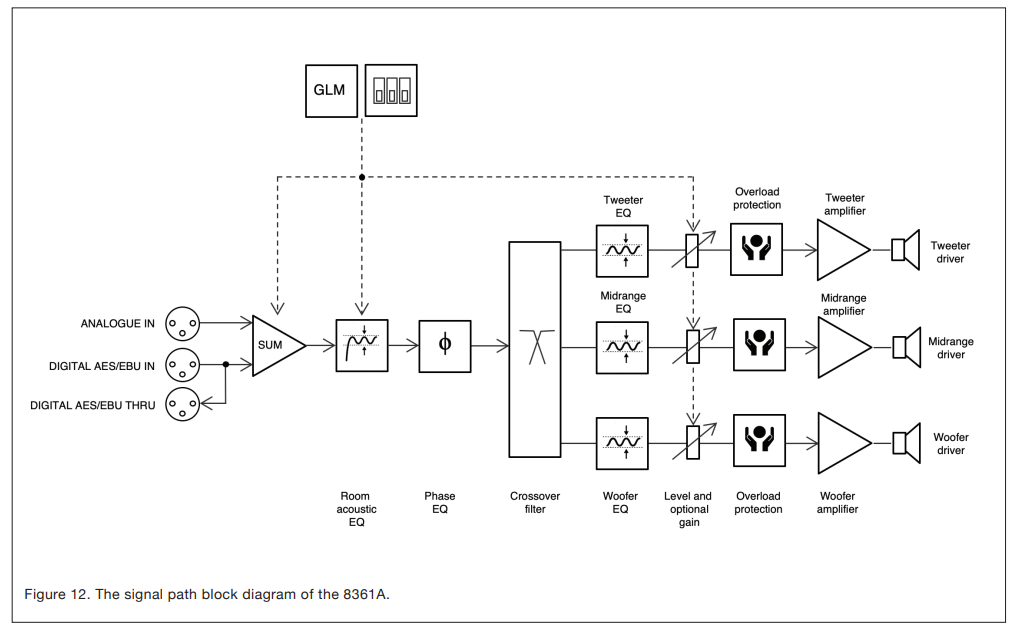
The advantage to DSP controlled monitors is that they usually, but not always, achieve a flatter frequency response due to equalization. OS level parametric EQ can also achieve this though. The downside is if you want the best possible volume control (analog), this is less efficient with a DSP speaker because the signal path is:
Source (e.g. computer playing the music) -> DAC -> Preamp with analog volume control -> DSP speaker -> Analog to digital conversion -> All the DSP stuff -> Digital to analog conversion -> output
So in this case, you go from digital to analog, back to digital, and then back to analog. This isn’t a real issue though, since while in this example you might use a higher performing DAC than what’s in the speaker, the speaker’s amplifiers not performing as well in SINAD or dynamic range nullify the advantage of having a better DAC. All of this is why I wish more (all) 3-way DSP monitors came with external electronics rather than inside each speaker, using better DACs, analog volume control, and better amplification from Hypex or Purifi while we’re at it.
But with DSP controlled monitors, you still want a DAC and preamp just for analog volume control, because no matter what, digital volume control reduces the digital signal and thus reduces the dynamic range. I’ve blind tested this to see how audible it is: my ADAM Audio S3V monitors sound like far lower end speakers when using any form of digital volume control, because of how severe the adjustment is (usually around -48 dB), which takes so much fidelity out of the original music signal, thus the DAC inside the S3V has less to work with. Lowering volume in your OS or playback software is the easiest way to ruin fidelity.
Professional monitoring speakers are almost always active. High fidelity (Hi-Fi) stereo music systems can be either one; passive has more presence in this market due to the abundance of snake oil products which dominate the really high end market.
Speaker Placement and Room Acoustics
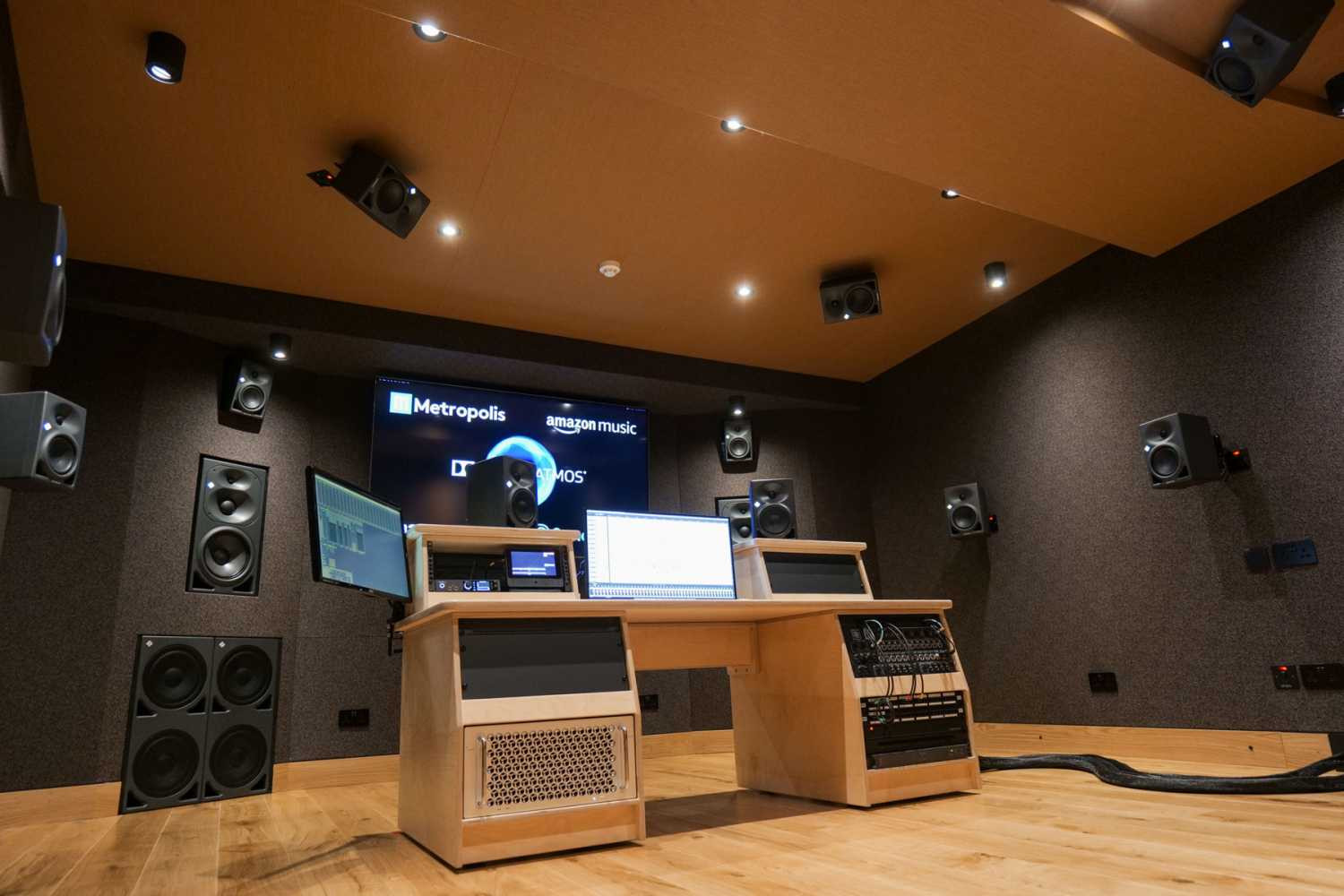
Once you acquire at least half-decent speakers, the biggest performance bottleneck by far will be your room. Any normal house or apartment room is an acoustic disaster. Normal people cannot change this: it will always be an acoustic disaster. Few people have the budget and the space to overcome this. The best we can do is get an acoustic measurement microphone, find out where the biggest problems are, apply equalization to minimize those problems, and apply whatever effective room treatment you can.
I won’t go too deep into this subject, but speaker placement and room acoustics can be as important as speaker selection. They can make top of the line studio monitor speakers sound far worse than they really are. Here’s some high level advice:
- Get an acoustic measurement microphone, it’s a must. Entry prices for a good enough one aren’t high, such as the miniDSP UMIK-1 which I use along with Room EQ Wizard. Using parametric equalization, flatten your frequency response as much as possible.
- Going one level above this, invest in a Dirac Live room correction DSP/DAC or an alternative, like the miniDSP Flex, DDRC-22D, SHD, or SHD Studio which all provide Dirac Live. If you buy Genelec “Smart” monitors, buy Genelec GLM instead. If you by Neumann studio monitors, buy Neumann’s MA 1 instead.
- Make sure your speakers are several feet away from walls
- Get some acoustic panels behind your speakers, especially if they’re rear ported
- Angle the speakers in slightly, so that they are pointed at your ears
- If you have solid flooring, get a big rug
- Your ears should generally be level with the tweeters
- Perfection is unfeasible for most of us, it’s for studios
For extremely accurate setups, room acoustics are measured, the entire room treated (sacrificing the actual space in the room significantly), the speakers are flush mounted into walls (soffits), but all of that is mostly for studios or those with loads of money.
General Headphone Advice
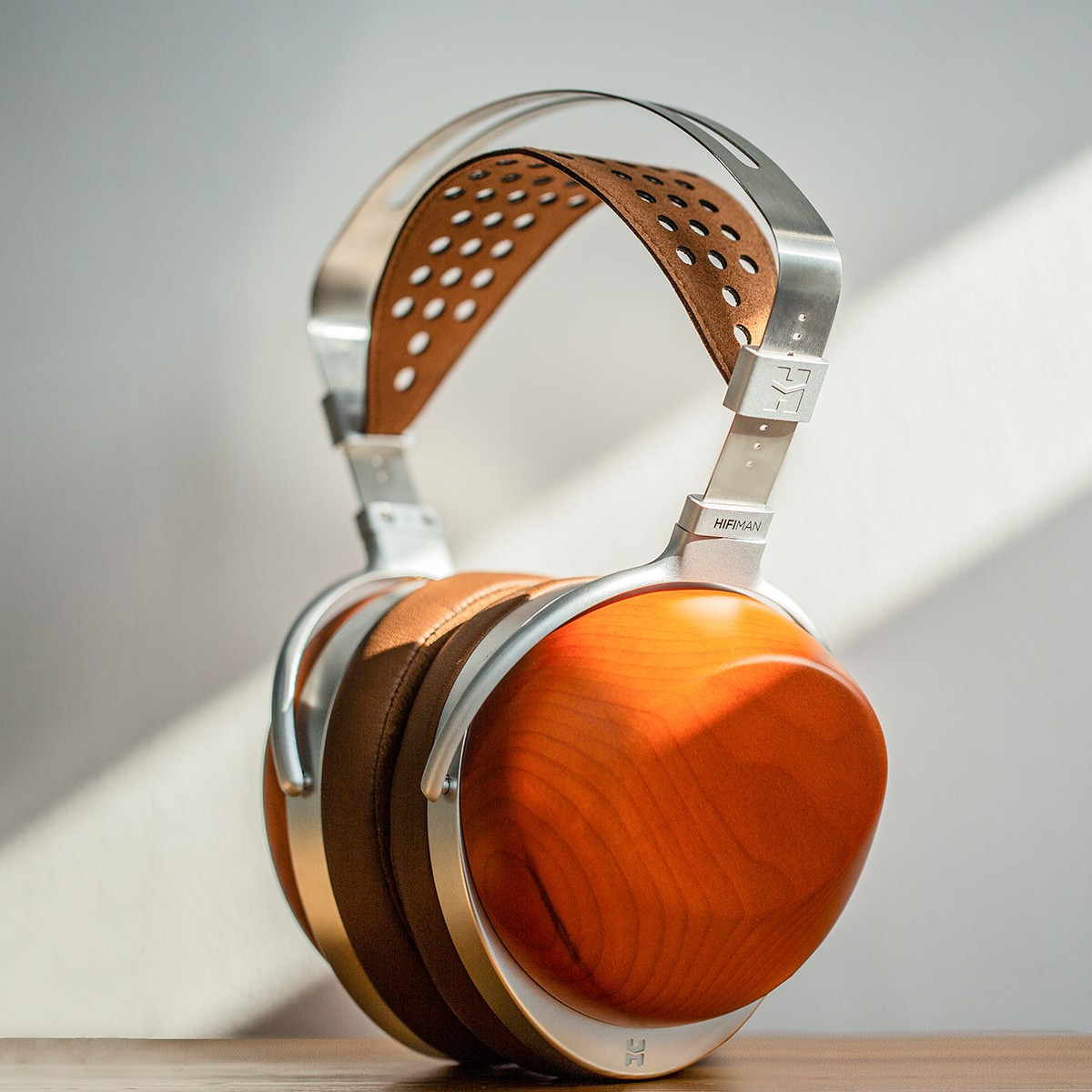
Let’s start with perhaps the more common choice for PC gamers, headphones. Over-ear, or circumaural, headphones are generally the most popular for people at home listening off of computers or game consoles, but in addition to over-ear, there are also on-ear headphones and in-ear headphones. In-ears are also known as IEMs, earphones, or earbuds.
Over-Ear Headphone Advantages:
- Isolation from the outside environment, especially with closed back headphones (more on this below), and especially with active noise cancelling
- Comfort
- Potential microphone quality
- Larger drivers = more potential for elevated basshead performance and rumble, for those who like inaccurately elevated bass
Over-Ear Headphone Disadvantages:
- Highest amount of phase errors – sound reverberates around the inside of the headphone, on your head, and on the surface of your ears, so you end up hearing a mix of these reflected sounds, much like a speaker’s sound reverberating around a room. The primary measurements for this are group delay and cumulative spectral decay (CSD) aka waterfall diagram. Very few over-ear headphones have the engineering prowess to mostly overcome this – Dan Clark Audio is the leader by far here, though the more recent Focal models (Stellia, Celestee, probably other high end models released after these) are catching up.
- Fit affects perceived sound, especially for those with cavernous cups
- Less ventilation for your head/ears
On-Ear Headphone Advantages:
- Fewer potential phase errors than over-ear
- Can be equipped with the same quality microphones as over-ear
On-Ear Headphone Disadvantages:
- Comfort compared to over-ear. Most but not all of them are horribly uncomfortable, which has caused them to fall out of favor
- Extremely limited options due to the small market, none are recommended in this article as a result
- The least isolating type of headphone
In-Ear Headphone Advantages:
- Least amount of phase errors
- Best value – the 7Hz x Crinacle Zero:2 is $25 and has nearly perfect measuring performance; to get comparable performance in an over-ear headphone (that is in frequency response, group delay/CSD, and total harmonic distortion), you have to spend at least $2,000 on a Dan Clark Audio E3
- Excellent isolation for active noise cancelling models
- Ventilation is hardly an issue
In-Ear Headphone Disadvantages:
- Fit is a hit or miss for different models, which is why tailored ones exist. Most IEMs fall out of my ears for example.
- More limited microphone quality due to the size
When shopping for circumaural headphones, you’ll come across Open Back and Closed Back headphones, and sometimes mixed “semi-open.” These are easily recognizable by their appearance too: closed back headphones have fully sealed ear cups on the outside, like most gaming headsets. Open back headphones have open ear cups with mesh or a grill covering it. See the images below.
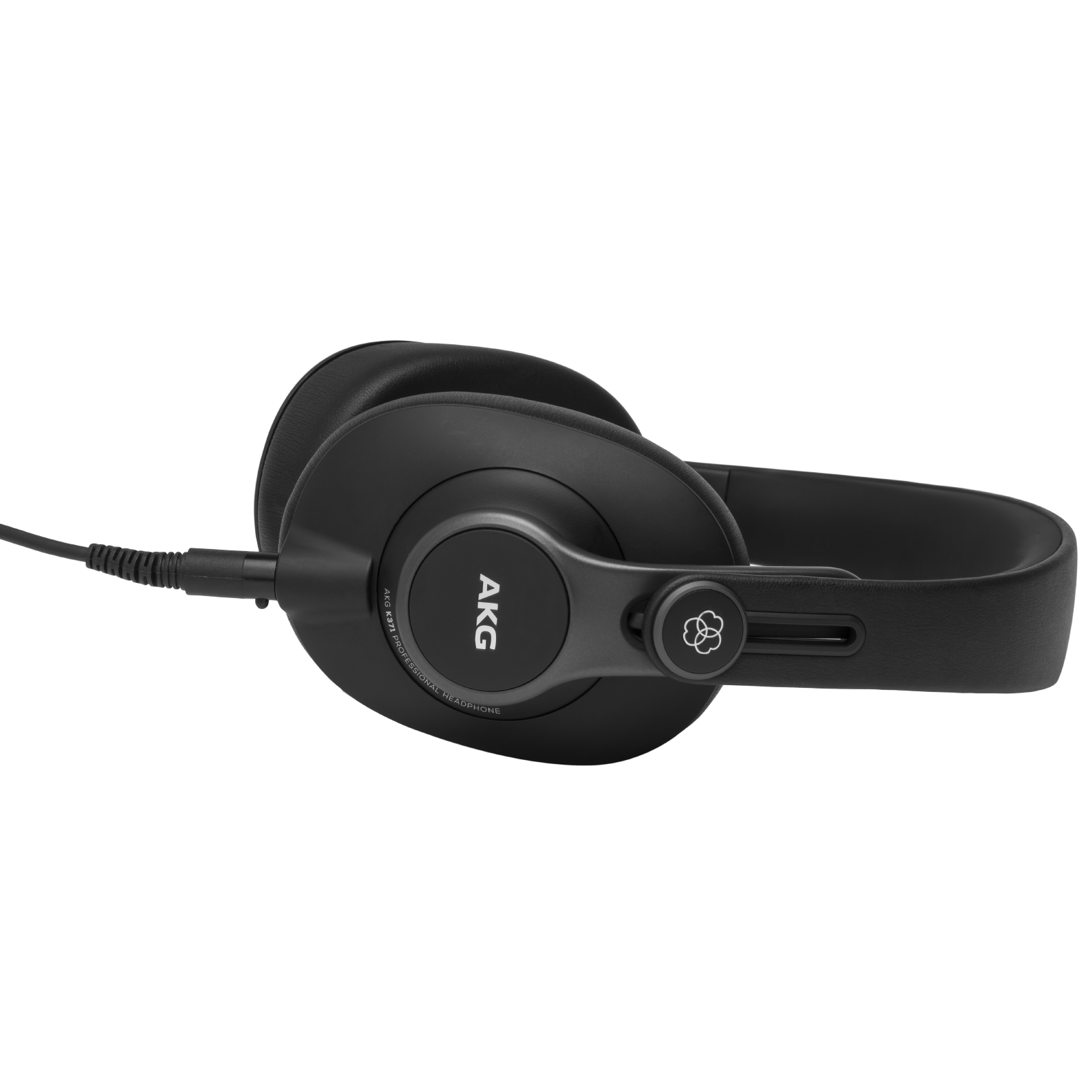
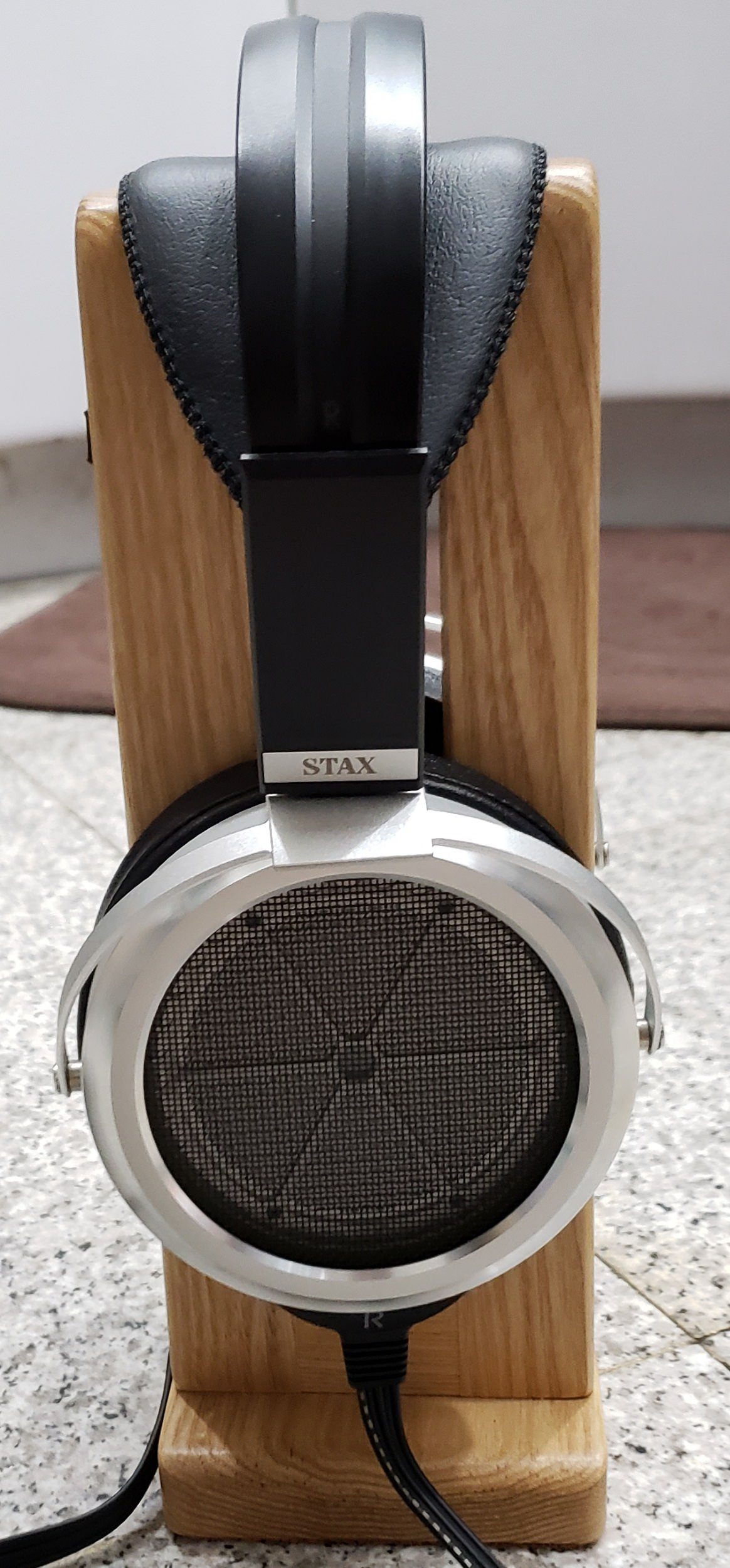
Semi-open will have some openings and some sealed spots. Designs here may vary, for example:
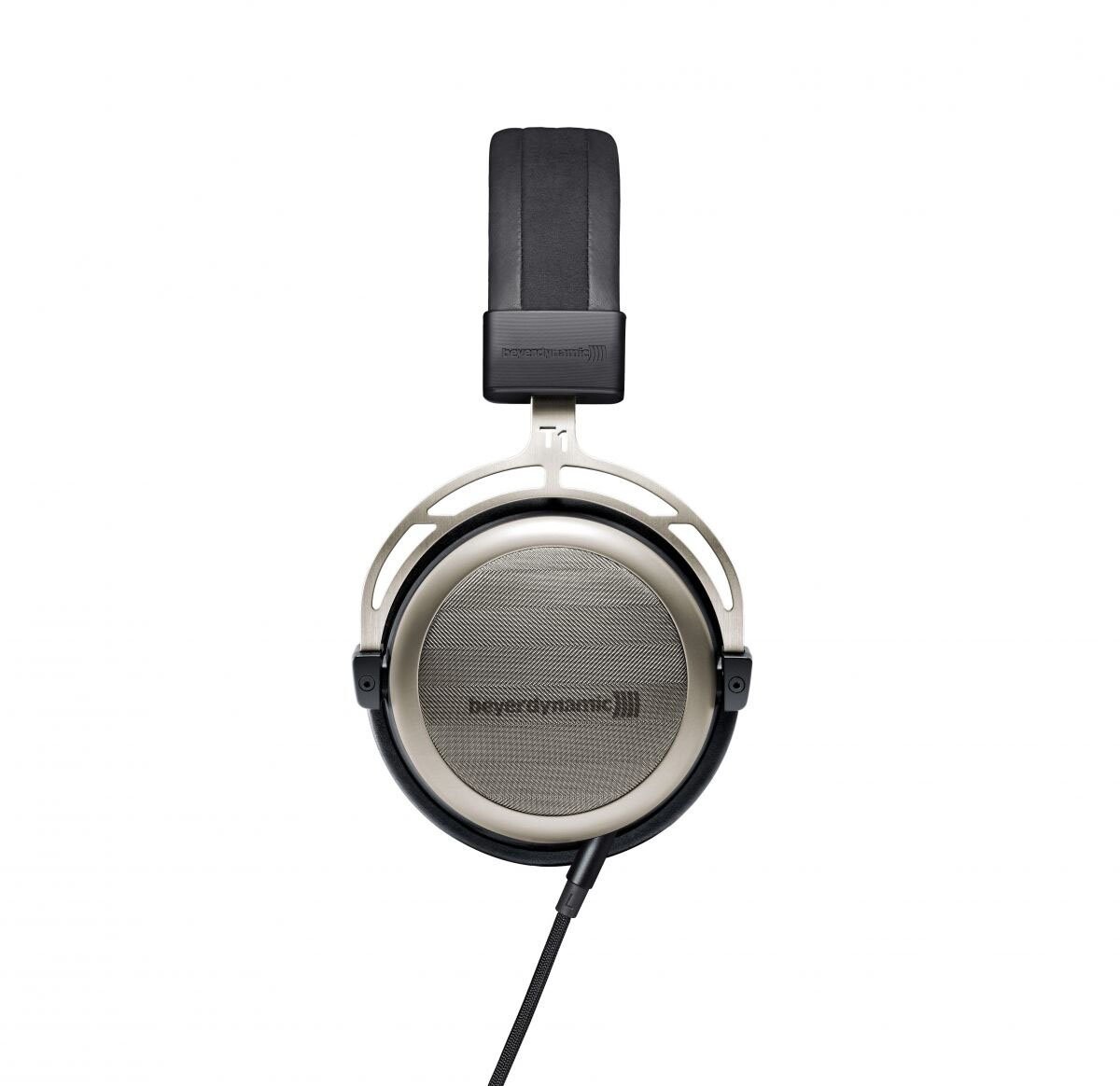 But the ZMF Ori on the left is mostly closed (according to them about 85% closed). The ZMF Blackwood on the right is fully closed for reference.
But the ZMF Ori on the left is mostly closed (according to them about 85% closed). The ZMF Blackwood on the right is fully closed for reference.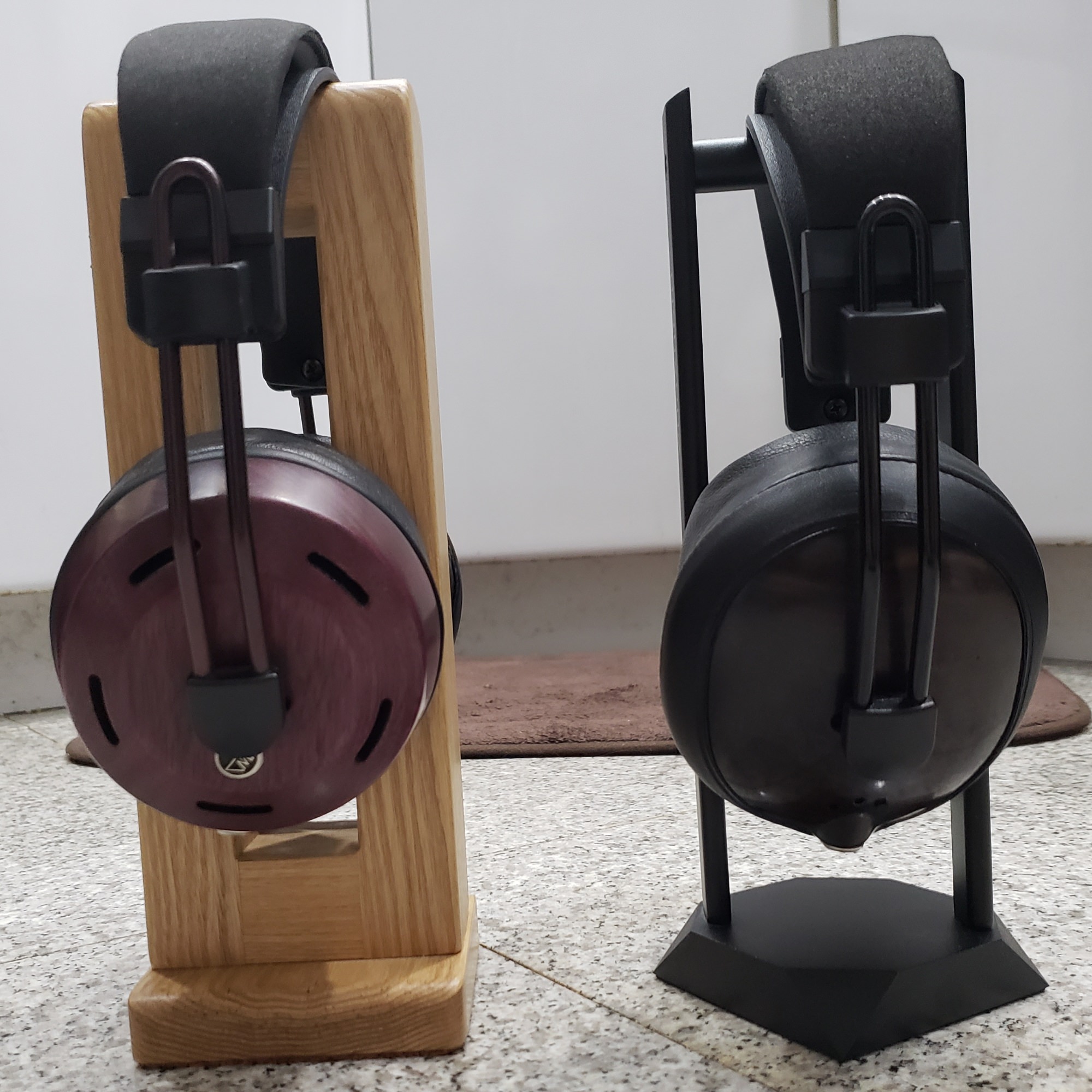
Closed back provides one key benefit: isolation. Since the ear cups are sealed, sound barely leaks out and outside noise barely leaks into the headphones. They isolate the wearer from the environment, and they isolate the environment from the wearer.
The downside to closed back headphones are purely physical: more reverberations inside the cup to deal with. This leads to a generally more “closed in” sound, though the best of the best have very clever damping and other tricks to mostly, but not entirely, overcome this.
So it boils down to your personal needs when it comes to open back vs closed back headphones. If you’re traveling, you need closed back headphones (or in-ear). At home, you can probably use open back but speakers are better than headphones (something the gaming industry fails to realize).
Important Headphone Specs
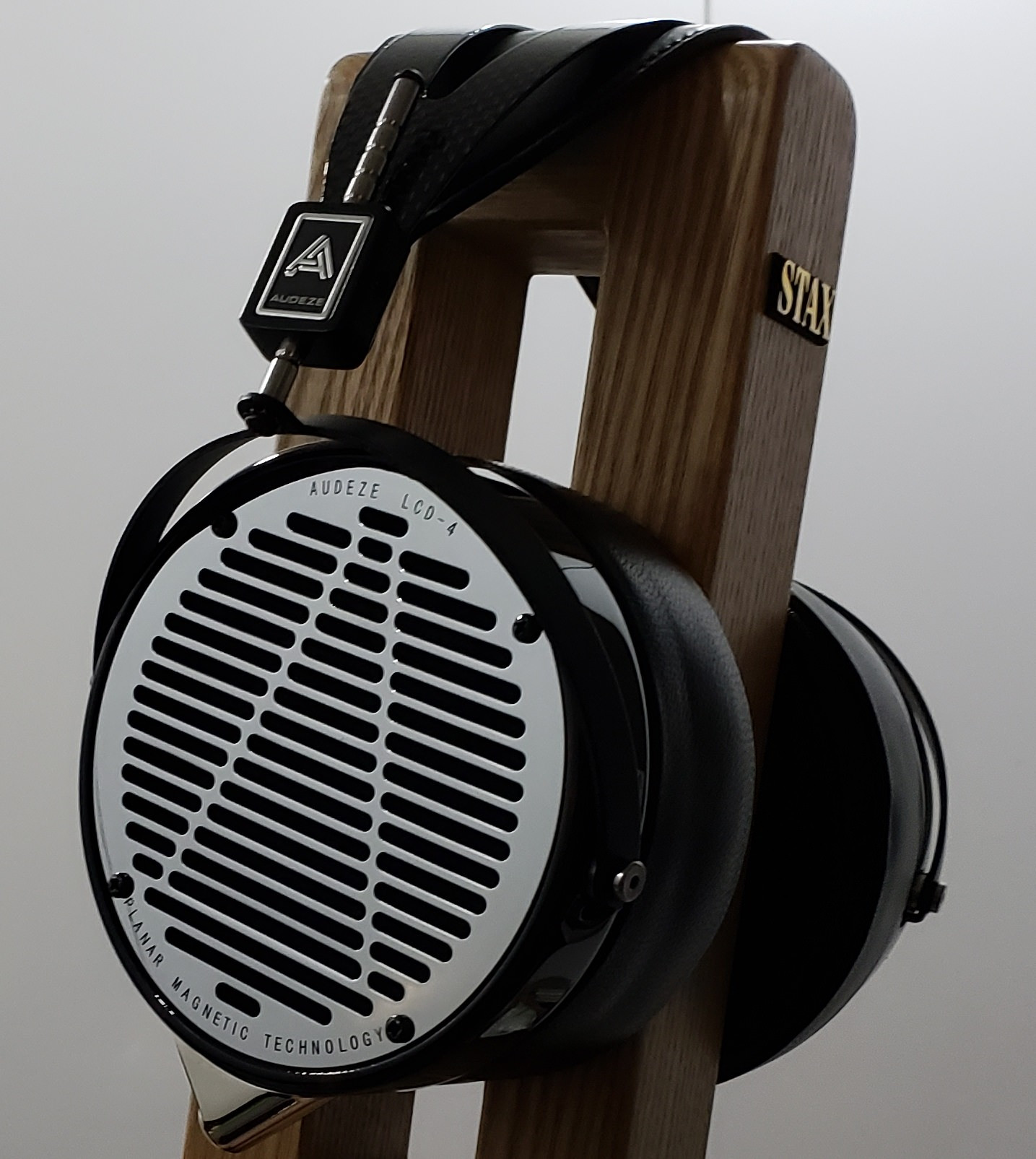
Another thing to pay attention to when it comes to headphone and speaker shopping is the impedance value for both the headphones in question, as well as the output impedance value for any amplifier you might be looking at (or whatever the headphone is being connected to, so this applies to standard line level audio outputs too). This is given in ohms. The rule of thumb is, headphone/speaker impedance should be at least 8x the output impedance of the amplifier. This is taken for granted for speaker amplifiers these days. Most over-ear headphones are 32-50 ohm, so you would want the amplifier’s output impedance to be no more than 4 – 6.25 ohm. But all amplifiers recommended in this article feature under 1 ohm output impedance.
Most headphone out devices are not designed for high impedance (100 ohm and above) headphones. So these headphones, such as those from Beyerdynamic and Sennheiser, usually require more expensive amplifiers, which still perform worse with these 300-600 ohm loads. So my recommendation is: just avoid really high impedance headphones. All the good ones (which are only some Sennheiser models) are outperformed by similarly or lower priced competition, all recommended below.
But when it comes to driving headphones and speakers, efficiency, also known as sensitivity is a major factor. This is often measured in dB/mW. The higher the efficiency, the easier it is for the headphone/speaker to get loud. This is why the 50 Ohm HiFiMan HE-6 is so hard to drive. 50 Ohm isn’t high, but they have a very low efficiency of 83.5 dB/mW, so they need more power (milliwatts/watts) to achieve a certain listening level (decibels/dB).
For calculating how much power gives what kind of headphone SPL, here’s a useful calculator.
Speaker and Headphone Objective Performance Data
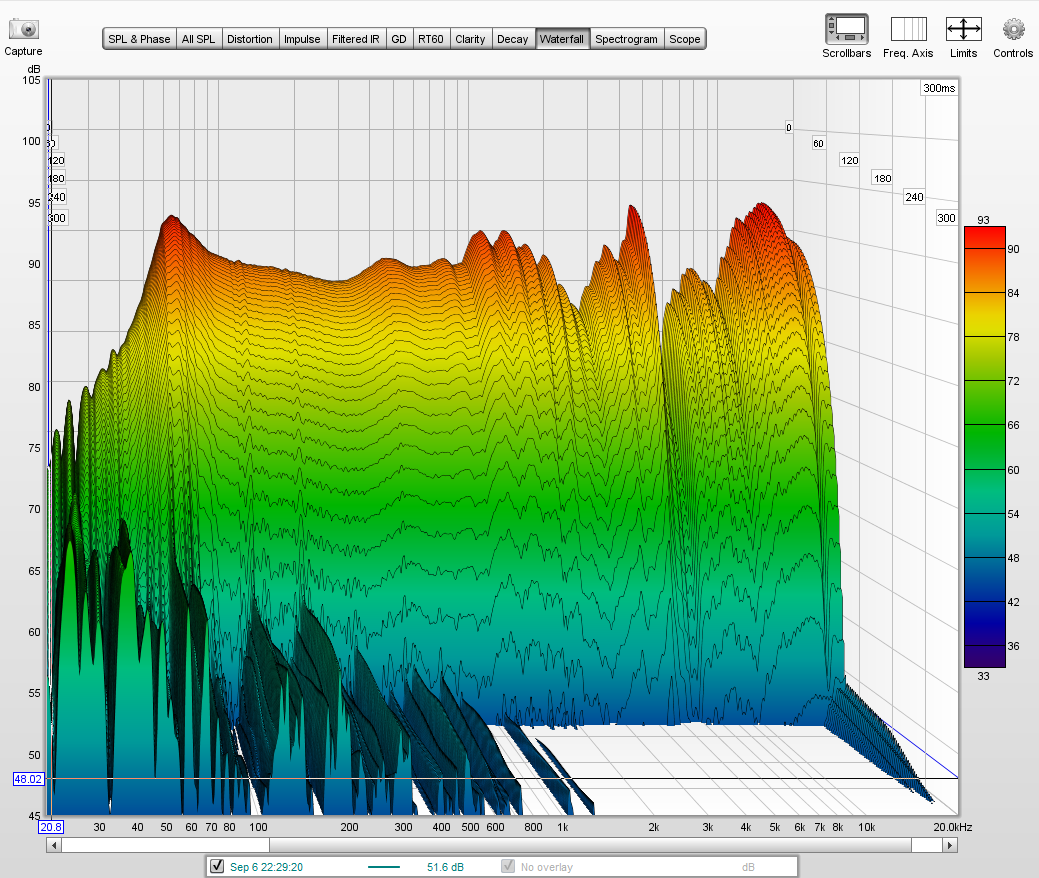
As for the objective performance of headphones, this is captured by 3-5 measurements above all: frequency response, total harmonic distortion (THD), group delay, impulse response, and waterfall/CSD. Frequency response was discussed above, it’s the most important but not the end all be all. It’s a direct measurement of the sound frequencies being output by the headphone.
THD is pretty obvious too – it is the accumulation of all harmonic distortion across the frequency spectrum. With harmonic distortion, incorrect sound frequencies are produced by the transducer. There are different harmonics, but consumers rarely need to look at the individual harmonic distortion levels.
Group delay, impulse response, and waterfall/CSD are related in that they show time domain performance in different ways. Group delay plots frequency vs time and is the easiest to read, impulse response plots amplitude vs time, and CSD plots SPL, frequency, and time so it is the single most informative measurement as it shows frequency and time domain performance in one 3D graph. These are all variations of measuring the delay between the sound signal being input vs being measured. Ultimately, these are measuring how much sound resonance/reflections/phase errors there are within the headphone cups, your head, and/or your ears depending on the type of headphone.
The ideal frequency response has no rolloff within the audible band, and otherwise it’s just what you prefer. Harman has researched this, as discussed above in the frequency response section so their preference curves are good starting points. The less THD the better. Phase errors are interesting since HiFiMan seems to induce them deliberately to get a certain character across much of their lineup which has proven to be somewhat popular, but it is ultimately a niche and unpredictable performance attribute.
If you have a lot of listening experience then the above data gives you a very good idea of how a headphone will sound (contrary to what audiophools claim), but there are two other significant variables: first is fit. If you can’t get a good fit, then you might hear a very different frequency response than someone who does! The other variable is the sound pressure level (SPL) or volume that you listen at, as THD rises with SPL. For example, my Dan Clark Audio E3 headphones have inaudible THD up to at least 94 dB SPL across the audible band, but at 104+ dB SPL (deafening) there’s audible bass distortion.
Only a small handful of headphones excel in all of these metrics: the Harman tuned 7Hz IEMs (one is recommended below), all of which are affordable, and also the Dan Clark Audio E3, Stealth, Expanse, and maybe the CORINA (we only have frequency response measurements of it so we can’t be sure). As with DACs and headphone amplifiers, headphones have minimal price to performance correlation! Unlike with speakers. IEMs if anything have a negative correlation, with these affordable 7Hz IEMs being the best and utterly unparalleled, but they’re more the exception to the rule. As a whole, over-ear headphones have a price/performance correlation up to around $150 I’d say, and then next to none after that.
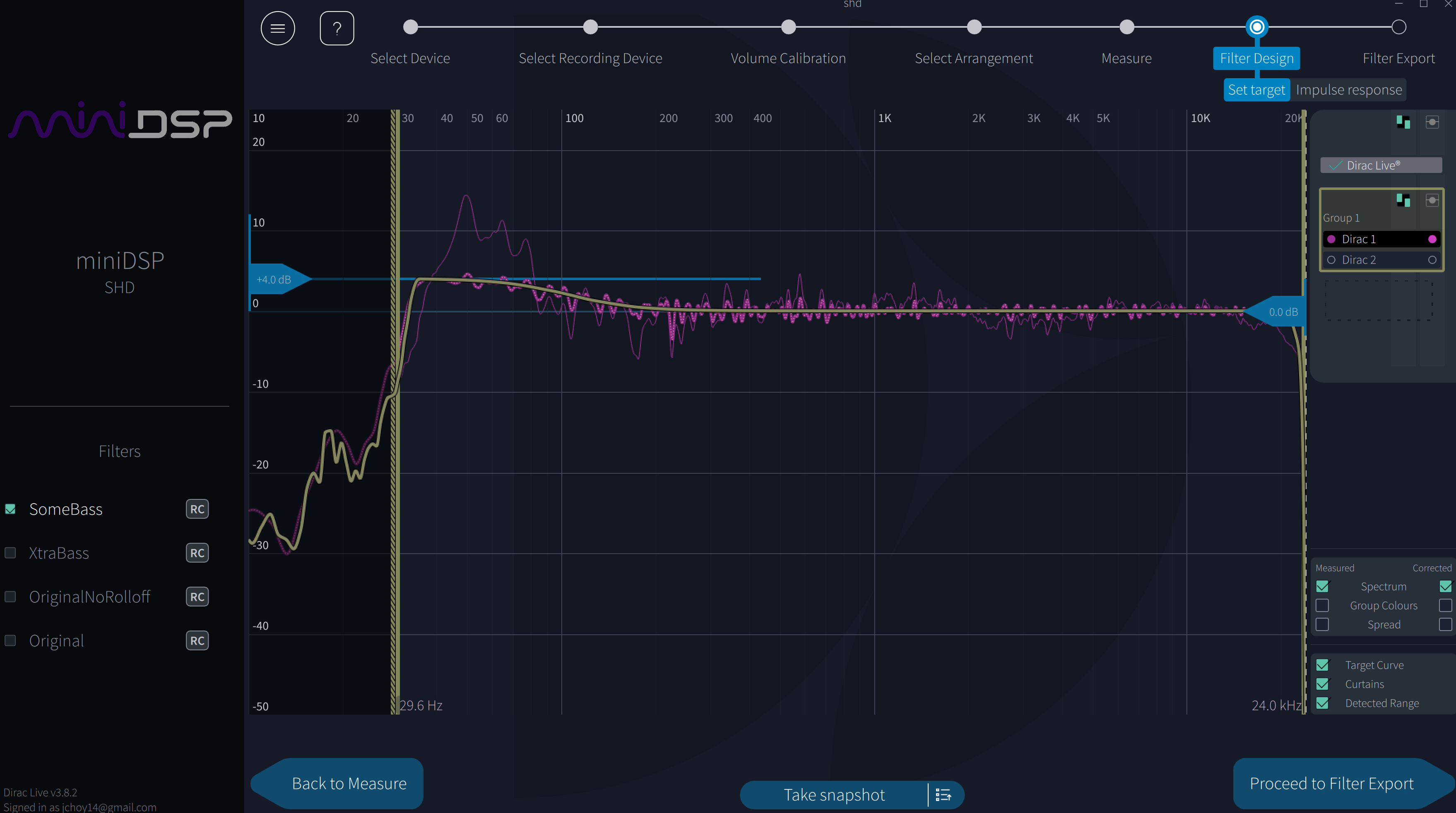
For speakers, those same measurements exist but things are different. Group delay/impulse response/CSD measurements are instead measurements of your room above all, so unless you’re in an anechoic chamber your performance there will always be poor. With speakers, you also have to worry about intermodulation distortion (IMD) which is a more significant, detrimental form of distortion but not a problem in any well designed speaker system. Technically this exists in headphones too, but is very rarely an issue. Similarly, crossover distortion can be an issue but again not in any modern, well designed speaker system with well designed amplifiers. The thing with speakers is, they are a slave to your room, even with digital room correction.
Another thing to worry about is how the electronics affect the performance. This is overblown by audiophools, but it can be a problem especially in the speaker realm. Ultra expensive, audiophool electronics are the biggest culprits here, such as NOS R2R filterless DACs, just about anything with tubes (especially in the output stage), anything with a transformer coupled output stage, and other badly designed power amplifiers. Many power amplifiers (that is, amplifiers for speakers) are load dependent within the audible band (this is bad design), and since dynamic transducers (99% of speakers probably) do not have a flat impedance curve, said amplifier will exhibit a nonlinear frequency response based on the speaker’s impedance, which varies per frequency. Furthermore, really badly designed amplifiers (like tube amps) may have a nonlinear frequency response based on frequency.
So the summary here is, look at third party measurements for your speakers/headphones, amplifiers, and DACs. Things are simpler with headphones since you don’t have to worry about room correction. A complete set of measurements paints a very clear picture of how a system will sound, barring room differences and headphone fit variance. Everything recommended in this article measures well in every metric (exceptionally well in most).
Headphones vs Speakers

I didn’t think anything like this would have to be addressed, but surprisingly there are debates about headphones vs speakers for home entertainment (mostly gaming). This doesn’t make any sense: these are two different types of devices for entirely different use cases, so what’s there to debate about?
This mostly comes from younger gamers who believe that headphones (probably all they can attain) somehow provide better, more accurate spatialization effects. There’s a belief that headphones can make them better sense enemy positions around them in video games.
This isn’t just younger gamers though, it extends to people who can afford the Smyth Realiser A16, a $5k virtual headphone surround sound device with 24 virtual speakers.
Use common sense. With headphones all the sound is coming from right over your left ear, right ear, or both. In reality, we hear sounds in the environment all around us. So how would a headphone better tell you that, for example, an enemy in a video game is behind you, compared to actually having speakers behind you?
Granted, these gamers aren’t usually comparing headphones to surround sound speakers, only to a 2-channel speaker setup (usually stereo or 2.1). It’s the people who spend a lot of money on headphones for gaming, especially the Smyth Realiser users, who are strongly out of touch with reality. For that kind of money, get a surround sound system and actually hear physical sounds from multiple directions. I’m sure the Realiser is amazing (I haven’t tried it), but you can’t better simulate having sound come from multiple directions than actually having sounds come from multiple directions with surround sound.

Instead of buying a Smyth Realiser, maybe buy a good speaker system (following recommendations below) and a Theoretica BACCH series unit. It’s like a Realiser but for speakers.
As far as entertainment goes, headphones are for portable listening and/or isolated listening. That’s all. Speakers are for unrestricted home entertainment. The best possible audio system for gaming and movies/TV is a surround sound speaker system.
Anyway, I think that’s enough talk. Let’s dig a bit deeper into the technology, and then product/brand recommendations are listed below.
Transducer Types
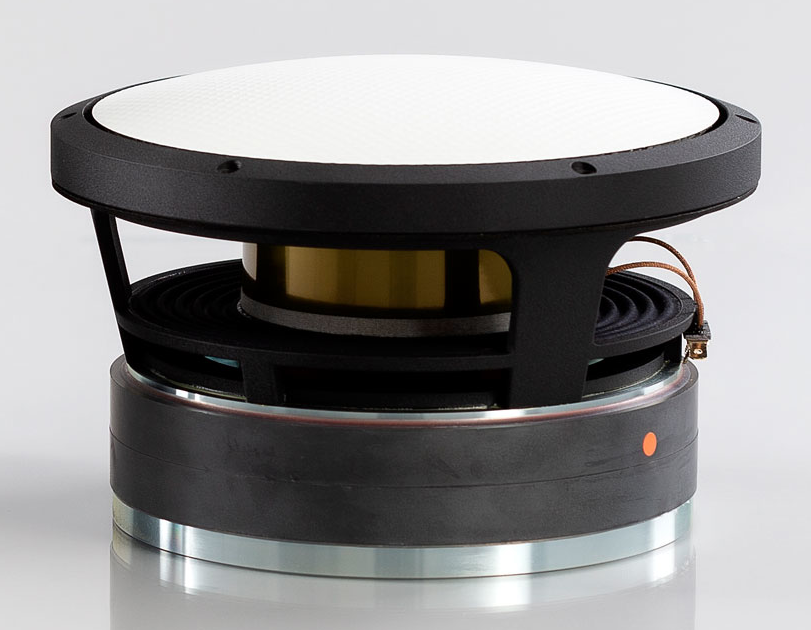
There are a few commonly discussed types of driver/transducer technology in the audiophile world: dynamic, planar magnetic (aka orthodynamic, or the trademarked Magneplanar name from Magnepan), ribbon, AMT, and electrostatic. Dynamic is by far the most common but this comes in many forms. Here’s a brief summary, but remember: transducer type is a means to an end. The end goal is the flattest and most extended frequency response possible, with the least amount of distortion possible, and the best directivity possible. It doesn’t matter what transducer type or DAC/amplifier topology gets you there, though the advantages/disadvantages of different transducer types are significant.
Dynamic (the most common) – Typical cone, dome, or horn driver tech. The audio cable is connected to a voice coil, which is installed inside a diaphragm (preferably towards the center). The voice coil is driven by a magnet which causes it to vibrate within the diaphragm. The magnet is typically neodymium which is best, though amusingly there are audiophool transducers that market the use of AlNiCo magnets which are weaker and therefore worse. These vibrations create the sound waves that we hear, and they are channeled through a cone (concave, most common), a dome (convex), or a horn. Because of how the voice coil is simply installed (glued) into the diaphragm, sound resonates outward from the driver. So we have relatively uneven distribution of vibrations across the diaphragm.
This is the baseline driver technology for speakers and headphones, generally one of the less expensive ones to produce (especially cones), and in my opinion the worst for headphones due to bass distortion problems especially if you try to achieve at least a linear bass response (preferably more as per Harman research) down to 20 Hz.
But some of these dynamic driver shortcomings are made up for with advanced diaphragm materials, voice coil designs, motor implementations, and simply having several of them. The reason I find this technology to be worse for headphones is, this driver tech is inferior when only using a single driver in a full range application, which is what a headphone is. For example, look at how planar magnetic and electrostatic speakers are either full range, or preferably 2-way with a dynamic woofer only handling bass.
For loudspeakers, dynamic driver tech remains the most favorite even in the high end. It is undeniably the best for bass reproduction despite the distortion, because it’s the only one that can remain linear in bass frequencies. It’s also the best for directivity, or the dispersion of sound.
Cones and domes can be made out of hard or soft material. This is of course a means to an end, the end being a linear frequency response with as little distortion as possible, the highest peak SPL possible, and the best directivity. One thing I will note is, soft dome tweeters are incapable of achieving a linear treble frequency response up to 20 KHz. This isn’t too big of a deal though, since music rarely has much going on up there and more importantly, once you’re past your mid 20s you’re probably not hearing 20 KHz, or 19 KHz, or even 18 KHz.
All the best performing transducers for mid range frequencies use softer materials like various fabrics, and almost all are domes except for Genelec’s “The Ones” studio monitors. All the best woofers are cones, except perhaps for one family of domes from Accuton pictured above (not fully validated). The absolute best measuring subwoofers I’ve seen come from Perlisten and Neumann – the former using state of the art carbon fiber cones and the latter using a composite sandwich cone.
Horn transducers don’t seem to perform well in linearity, and if any do it’s only mini-horn tweeters. For this reason, you should avoid horn speakers. They all measure poorly.
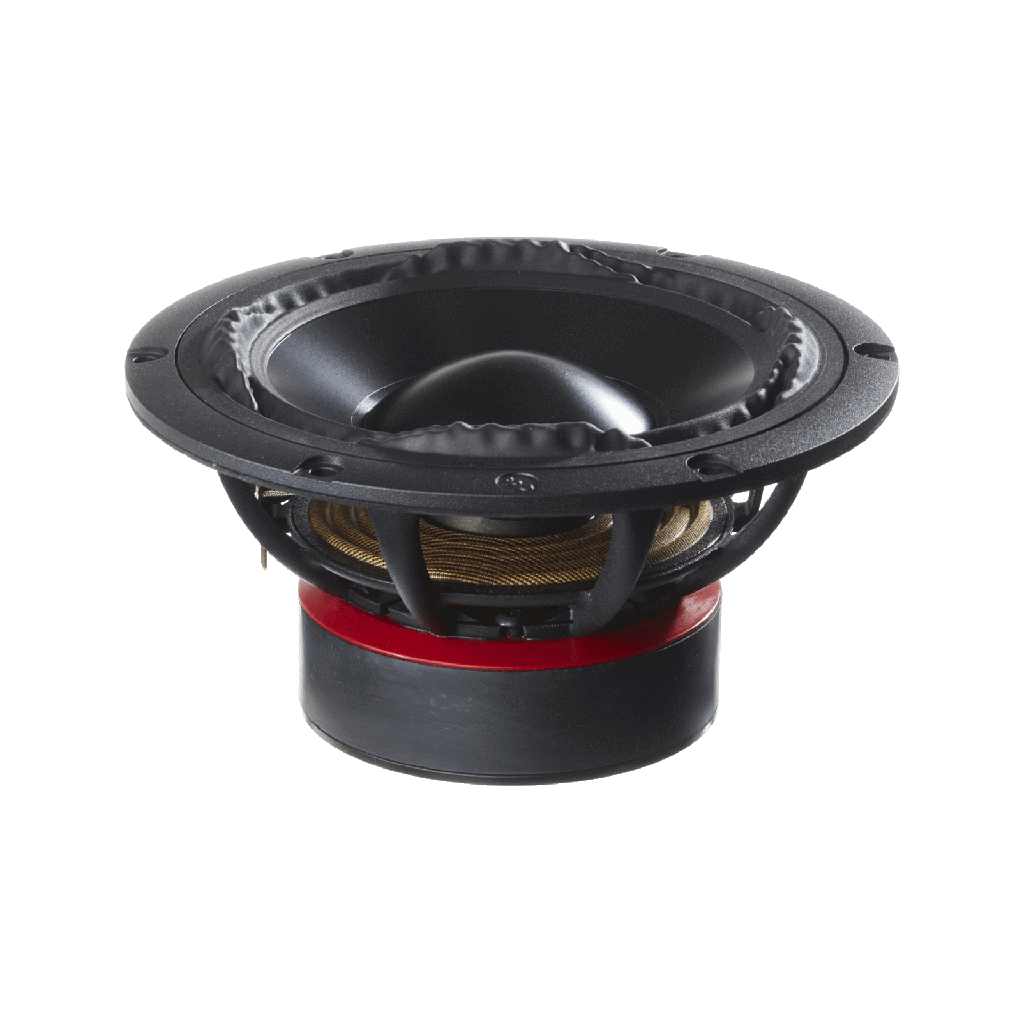
Summing up the general pros and cons of dynamic transducers:
- (+) Very well rounded when using multiple transducers. Many of the all time greatest loudspeakers use dynamic transducers exclusively; dome tweeters, dome mids, and cone woofers for bass.
- (+) Undoubtedly the best transducer type for bass frequencies in speakers/subwoofers, as it’s the only type that can remain linear in these frequencies.
- (+) The easiest type of transducer to drive, potentially. Namely the most sensitive.
- (+) Potentially the best dispersion characteristics, epitomized by coaxial
- (+) Cheap to produce
- (–) Generally much higher levels of distortion than the other types save for ribbon
- (–) Impedance varies per frequency, making them more dependent on amplifier design (amps should not be load dependent)
- (–) More difficult to get a linear treble response up to 20 KHz. Even the best 1″ soft domes can’t do this, and I haven’t even seen a hard dome tweeter (e.g. beryllium) achieve this but perhaps they’re out there and they get closer than soft dome at least.
- (–) Not ideal for a full range application, such as headphones, since other driver types produce far less distortion in the bass frequencies and actually more commonly achieve better bass extension
The best mid range transducers measured are all soft domes, along with 1-2 cones used in coaxial speakers (Genelec, maybe Geithain). For tweeters, the imperfect treble linearity isn’t a problem for most adults especially in their 30s, as your ability to hear high frequencies is lost. But there is a tradeoff here: linearity in favor of AMT/ribbon/electrostatic versus better dispersion of dynamic, also lower possible distortion in dynamic vs ribbon specifically.
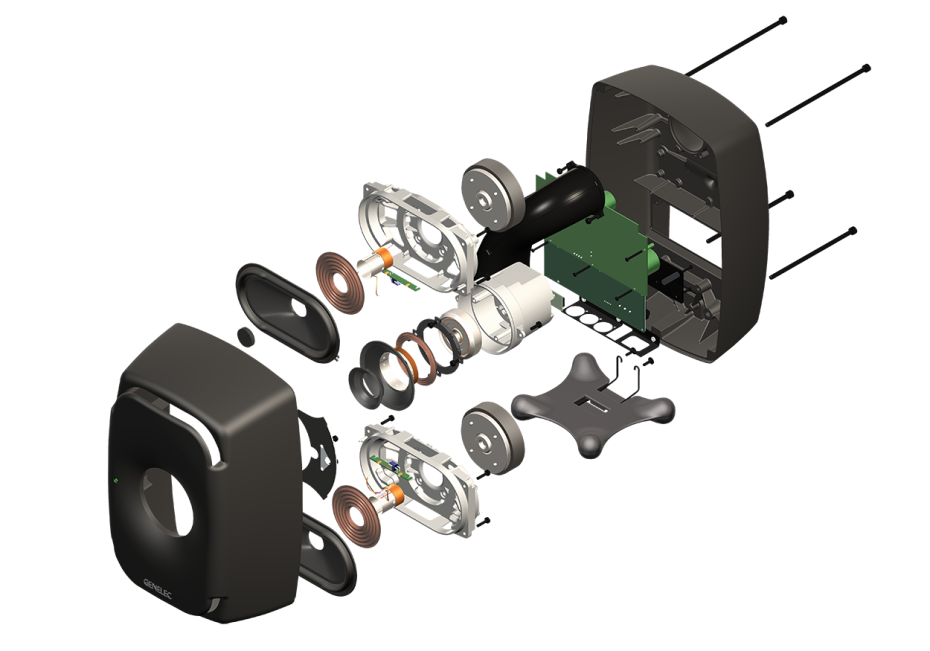
There are also coaxial speakers. This is a type of speaker that uses multiple dynamic transducers radiating from a single point, e.g. behind a single waveguide. These are common but the best engineered example of this is the Genelec “The Ones” smart 3-way studio monitor series, illustrated in the image above, and Geithain was great historically. There are two main benefits to coaxial speakers: compactness, as you have only a single waveguide with multiple drivers, and potentially better dispersion characteristics. The dispersion characteristics make them an ideal point source monitor for sound engineers, but for home use, it means they adapt more easily to rooms – it’s easier to tune out problematic frequency response peaks and dips. For this reason, these Genelec studio monitors are highly recommended.
If you follow car audio, you might know that coaxial speakers have a bad reputation there – this is because that market is flooded with poor performing coaxial speakers.
Planar Magnetic – Although the voice coil is attached to the diaphragm as with dynamic transducers, here the voice coil takes on the form of super flat wires stripped across the diaphragm so to speak, in such a way that thinner, less resonant diaphragm materials can be used (e.g., the nanometer-thick diaphragms in the HiFiMan HE1000 and Audeze LCD-4 and newer models from these companies). In addition, magnets are installed on either side of the diaphragm which the voice coil’s magnetic field reacts to.
Most planar loudspeakers have a magnet only on one side of the diaphragm, while headphones are very mixed between one magnet or two (one on each side). The diaphragm is thus suspended between a magnetic field. This means vibrations across the diaphragm are more even and uniform, resulting in potentially less distortion and thus more transparent sound than dynamic drivers.
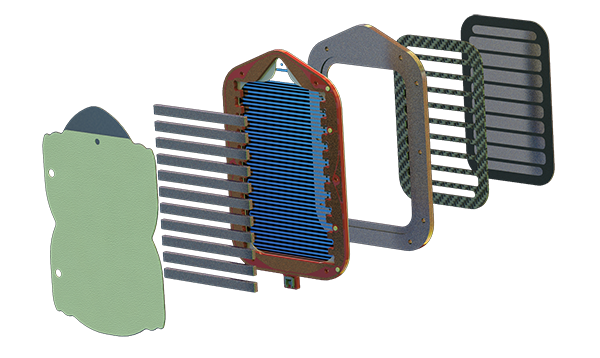
So to sum up the pros and cons of planar magnetic technology:
- (+) Potentially lower distortion than dynamic and ribbon
- (–) Needs well designed damping materials to clean up frequency response, especially in the upper frequencies. This is more of a problem with headphones. The planar magnetic assembly involves materials that alter the frequency response, such as the magnets themselves. Some recent innovations here include Dan Clark Audio’s game changing AMTS (metamaterial damping device that eliminates high frequency standing waves, and as a result their headphones with this have the cleanest treble response ever measured), acoustically transparent magnets, thinner diaphragms, etc.
- (–) Not fit for loudspeaker bass driver use
- (–) Harder to drive, less sensitive on average than dynamic transducers
- (–) Costs more to produce than dynamic, electrostatic, AMT, and ribbon drivers
- (–) Planar magnetic loudspeakers (i.e. Magnepan) don’t have the best dispersion characteristics
This technology is similar to ribbon and AMT but not the same. Planar magnetic tech is rare in the loudspeaker world, with Magnepan being the pioneer.
For headphones, I think they’re the sweet spot in the current market, though AMT seems like it can beat it by sharing its advantages, without its disadvantages, while costing less.
Ribbon – This driver type uses very little material. It’s similar to planar magnetic, but with ribbons the voice coil is the diaphragm, making this simpler in a good way. The surface area is also far larger. One issue is the transformer that’s used to create the magnetic field, which introduces distortion. Ribbons are almost exclusively used for tweeters and nowhere else.

- (+) Potentially more linear treble response than the above
- (+) Cheaper to produce than planar and electrostatic
- (–) Relies on a transformer to create a magnetic field which introduces distortion – more than dynamic and planar potentially. But it can be made to produce inaudible levels of distortion.
- (–) Not fit for loudspeaker bass driver use
- (–) Generally harder to drive than dynamic transducers
Air Motion Transformer (AMT) – This is like a cross between a ribbon and a planar. Despite its name, unlike ribbon, there’s no actual transformer creating a magnetic field here. The magnetic field is created by magnets, like on dynamic and planar drivers, so you don’t get the added transformer distortion unlike ribbon. I’m unclear as to what the consequences are compared to ribbons.
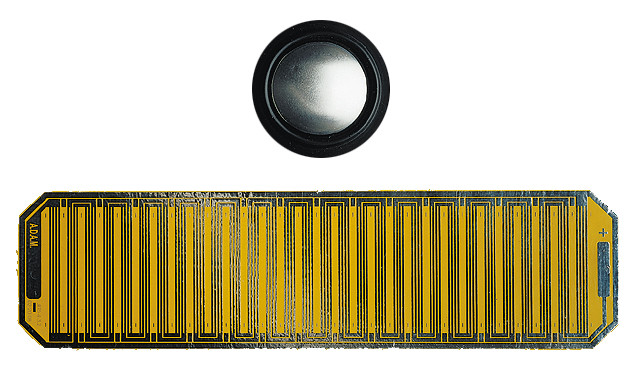
- (+) Lower distortion than all of the above at least for high frequencies
- (+) Potentially more linear treble response than the above except probably ribbon (should be very similar?)
- (+) Potentially the cheapest to produce, except maybe for cones
- (+) Unlike ribbons, there’s no transformer adding distortion
- (–) Not fit for loudspeaker bass driver use
- (–) Generally harder to drive than dynamic transducers

AMT needs to be explored more for headphones, I think it’d be the best choice especially considering the poor state of the electrostatic headphone amplifier industry. The only AMT headphones are made by GoldPlanar (unimpressive) and HEDD who now has two models. Sadly there’s no proper review for the HEDDphone Two.
Electrostatic – Electrostatic drivers consist of the thinnest diaphragms (an inherent benefit, which is why planar manufacturers pursue thinner diaphragms) which are also electrically charged. This diaphragm is suspended between two metal plates (electrodes). The analog sound signal received from the cable is applied to these electrodes creating an electrical field. The diaphragm is drawn to one of the plates depending on the polarity of this electrical field.
No voice coils, no uneven vibrations across the diaphragm. Because of the lack of moving parts, the even distribution of vibrations from the diaphragm, and because vibrations are created and stopped much faster, electrostatic drivers can produce better sound in numerous ways detailed below. Unlike planar magnetic drivers, it accomplishes this with no materials that interfere with sound!
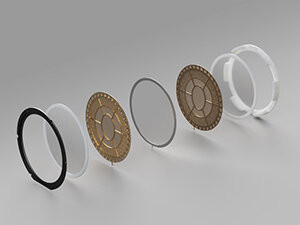
The industry really needs to explore electrostatic tweeters, and combining them in speakers with dome mid range transducers and cone bass woofers.
- (+) Lower potential distortion than all of the above
- (+) Potentially the most linear treble response
- (–) Not fit for loudspeaker bass driver use
- (–) More costly to make than dynamic drivers, but less than planars and I believe more than ribbons.
- (–) The electrodes distort the frequency response slightly
- (–) Generally harder to drive than dynamic transducers
- (–) Long term reliability concerns caused by arcing from the stators (unconfirmed)
- (–) Electrostatic headphones require special electrostatic amplifiers (or power amplifier + transformer box aka energizer, but this isn’t as good), although electrostatic loudspeakers do not require specialized amplifiers. The electrostatic headphone amp market is very limited: everything is expensive or insanely expensive and uses very outdated designs, delivering worse performance than the $100 Objective2 amp even. Even the Topping EHA5 isn’t good enough.
Electrostatic technology is much closer to what professional grade microphones use. They don’t use moving voice coils. Actually, said microphones are much closer to electret technology, which is essentially the little brother to electrostatic. Stax even made electret headphones in the past, but not anymore.
But of course, things aren’t so clear cut. Every electrostatic speaker or headphone won’t be better than every planar magnetic or dynamic or vice versa. Plus, the absolute best speakers in the world are at least mostly dynamic, because they use separate drivers for treble (tweeter), mids (woofer), and bass (woofer again).
I mentioned plasma transducers earlier – these have the least amount of material, since all they are is high frequency arcs. This transducer type is undoubtedly capable of the best treble performance, but the problem is… they’re hazardous. They produce toxic gases, most notably ozone, making this driver type one to avoid.
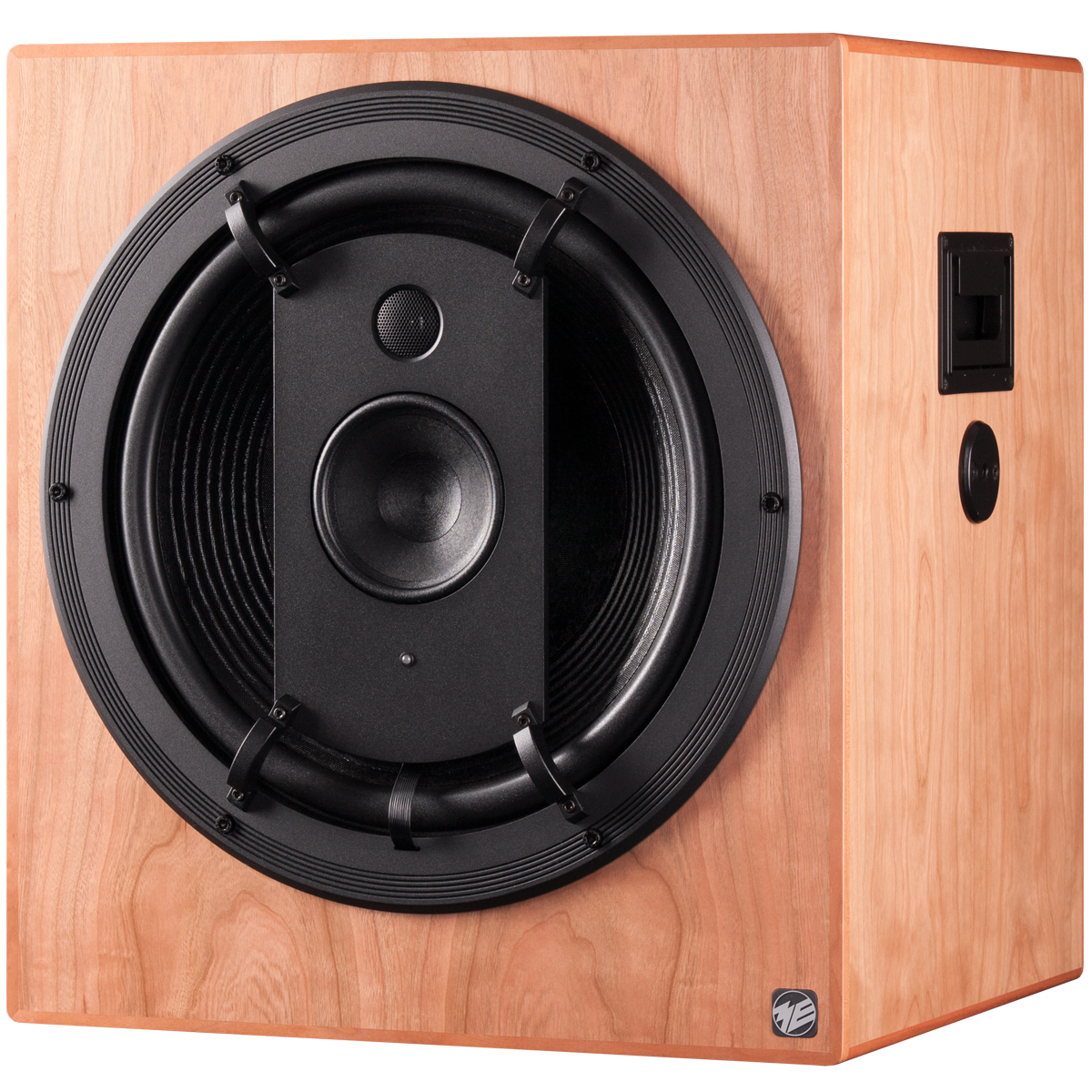
Shown above is the Geithain RL 901K, another coaxial speaker design (a more typical type than the aforementioned Genelec)
Different speaker/driver manufacturers have different philosophies about the materials for dynamic transducer material and what is ideal. Some prefer metal drivers, with Beryllium being one of the highest end examples of metal drivers, due to low distortion ratings as their stiffness makes them respond to sound very linearly. Though there are harder, more rigid drivers than metal of course, like carbon fiber and possibly ceramic. Others prefer softer, fabric materials due to resonance from metal drivers. But the material and the transducer technology in itself are just means to an end, that end being your desired frequency response (start with linear as it’s uncolored thus the must accurate) with no audible distortion.
But I have to point out the fact that the vast majority of “audiophile” dynamic loudspeakers use cone transducers for the mid range. Often times fairly large too, in the 6″ range. This is just not ideal in a non-coaxial (component) speaker; a dome is better suited for mids as most measurements show. Domes are the only accepted dynamic transducer technology for high end studio monitors, not cones, because cones don’t provide the accuracy required for this use, again with the exception being coaxials like Genelec The Ones. Expensive “audiophile” loudspeakers using cone mid range drivers is a snake oil scam to me, like so many other things in the industry. This is why I stick to active studio monitors.
Recommended Speakers
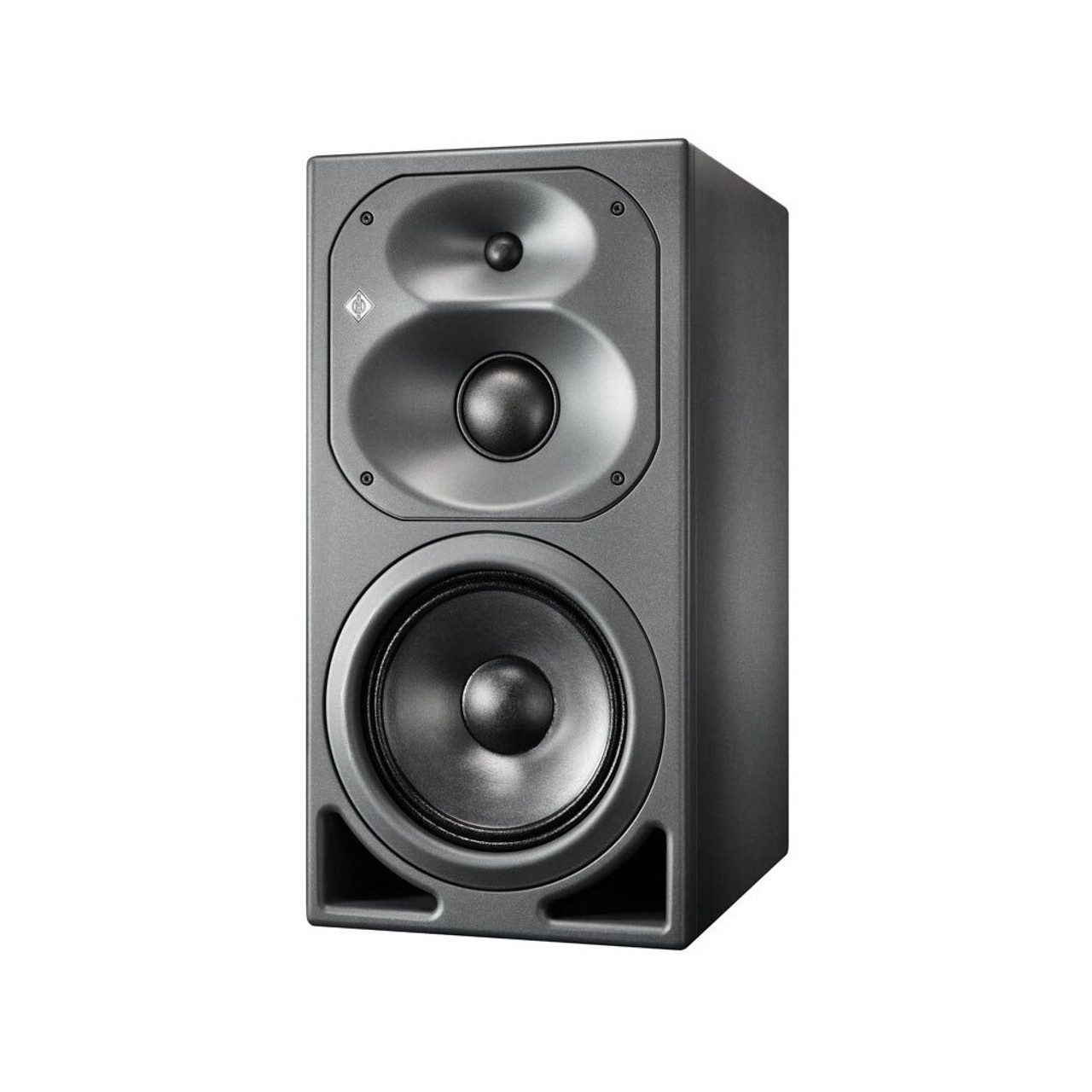
For hi-fi big spenders, I absolutely recommend active studio monitors above all. The people who design the transducers know best how to drive it, thus they are best fit for designing the amplifiers for them. And each transducer has its own amplifier, operating in unison via an active crossover. The best possible design.
For budget speaker recommendations, the best thing to do is to look at reviews with measurements. The easiest way to get a list of recommendations is to sort on Audio Science Review (under speaker reviews) with the following search filters:
- Speaker Type contains “Bookshelf”
- Price Each USD between “your price range”
- Recommended contains “Yes”
Additionally, browse Erin’s Audio Corner – this site doesn’t have a proper search function, but it also doesn’t have that many reviews.
Recommended High End Speaker Brands:
- ADAM Audio
- Genelec – the best and most proven in third party reviews with measurements, along with Neumann, but their high end “The Ones” three way “smart” monitors are the best speakers by far in any room short of an anechoic chamber
- HEDD Audio
- Geithain – their coaxial active speaker range. They provide basic measurements which look great, but there are hardly any third party measurements. More old fashioned than Genelec and Neumann, but a number of their 3-way speakers show a very flat frequency response from 30 Hz to 20 KHz.
- Neumann – the best and most proven in third party reviews with measurements, along with Genelec
Recommended Subwoofer Brands:
- Dayton
- HSU
- JBL
- JTR Speakers
- Klipsch
- Monoprice
- Neumann
- Perlisten
- Polk Audio
- Rythmik
- RSL
- SVS
To narrow down your subwoofer search, this is a good guide to get you started. Once you have all the basic information you need, I recommend looking at reviews on Erin’s Audio Corner, and then the “best subwoofers” articles on Home Theater Review and Audioholics, along with their reviews of subwoofers in your price range, and pick the one that works best for you.
For mid budget subwoofers, RSL, Rythmik, and Monoprice provide the most enticing offerings currently. Dayton is usually, but not always, the best on a minimum budget. Perlisten makes some of the absolute best subwoofers in the business, and Neumann’s KH 810 G measures exceptionally too, but definitely look at reviews for all contenders in your price range before buying.
Recommended Nearfield Speakers:
For higher end speakers that have the measurements to back them up, I recommend the following starting with 2-way (nearfield), which refers to the most common type of speaker with a tweeter and a woofer like all the recommendations above. You’d want a subwoofer with these, and that subwoofer should be integrated using a professional grade microphone to measure the frequency response of the room. All prices below are for a pair.
- Neumann KH 80 DSP A G ($1,100)
- Genelec 8320A ($1,450)
- Genelec 8330A ($1,900)
- Neumann KH 120 II ($2,000)
- Genelec 8340A ($3,390) – hasn’t been properly reviewed like its siblings
- Neumann KH 150 ($3,500)
Recommended Mid Field Speakers:
Now for 3-way speaker recommendations. These have a separate tweeter, mid range driver, and bass woofer, which is the ideal speaker design considering the limitations of all transducer technology. These are also referred to as mid field speakers, meaning they’re designed to be listened to about 1.5 – 3 meters away. All prices below are for a pair.
- Nubert nuVero 60 (€1,650 + a powerful amplifier) – a pair of 3-way speakers for well under $2k? Impressive. It even measures fairly well hence the recommendation. However, it needs an amplifier that can deliver lots of power into 4 ohm (and technically slightly less). Amplifier recommendations are below.
- Genelec 8331A ($4,900) – this and every other Genelec speaker recommended below are part of “The Ones” family – in any room short of fully treated studio rooms, they outperform everything else by far (details below)
- Neumann KH 310 A ($5,000) – measurements show this outperforms the similarly priced Genelec 8331A and HEDD Audio Type 20 MK2 in an anechoic chamber, but in a typical room it will lose to the 8331A
- Genelec 8341A ($6,200) – the ADAM Audio S3V is also in this price range which has overall great measurements (albeit unverified by third parties), but it doesn’t seem to do anything better than the $5,000 Neumann above which wins in bass extension, and the Genelecs beat them in typical rooms
- Genelec 8351B ($8,390)
- Genelec 8361A ($10,000) – this, the speaker below, and possibly the overpriced ADAM Audio S5V are the best midfield speakers in the world, but this one is unrivaled in any room that isn’t an anechoic chamber
- Neumann KH 420 ($10,500) – possibly the GOAT in an anechoic chamber, but outside of that the Genelec 8361A wins overall slightly
Recommended Far Field Speakers:
These are for huge rooms with listening distances of more than 3m. So this is only for huge studio rooms and people in mansions. I suspect the majority of people would prefer to listen to music on mid field systems instead (the ones listed above), unless trying to impress people. The speakers best designed for far field listening are referred to as “main monitors” – everything recommended below is a main monitor. All prices below are for a pair, and you’ll want subwoofers to go with them – usually the matching subwoofers from the same manufacturer.
- HEDD Tower Mains Standard ($28,500)
- Genelec 1234A (unknown but I think around $40,000)
- Genelec 1235A (unknown but I think around $50,000)
- Genelec 1236A (unknown but I think over $80,000)
- Genelec 8381A ($64,000) – probably the best
There’s a very clear pattern there: Genelec and Neumann have proven themselves more than anyone, though ADAM tried to catch up with the S lineup but flopped hard with the S5V’s pricing in particular ($17,000 for a pair!). As it so happens, Genelec and Neumann also beat their competitors in value, since they not only outperform the competition (and far higher priced speakers), but they do so while including their own built-in amplification. I hope Neumann makes a model above the KH 420 with a 12″ woofer, DSP, newer and better performing and higher power Class D amplification, so that it’s flat from 20 Hz – 20 KHz – the true dream loudspeaker and mid field monitor.
If you go with Genelec, also get their GLM calibration system. If you go with Neumann, get their MA 1 calibration system. Both of these are only around $300 each, a lot less costly than Dirac Live.
Geithain high end coaxial active monitors are fascinating and not generally poor choices, but a bit outdated compared to Genelec and Neumann plus not as much third party data on them. Alcons is another fascinating one, seemingly the industry leader in dynamic range or peak SPL, but there’s so little data on them with zero third party. What is clear is, their entire VR lineup needs to be paired with subwoofers, which presents poor value compared to all of the above recommended high end speakers.
Genelec is recommended above all for anyone not in a totally treated studio essentially. This is why: look at how the in-room response compares between Neumann and Genelec “The Ones”:
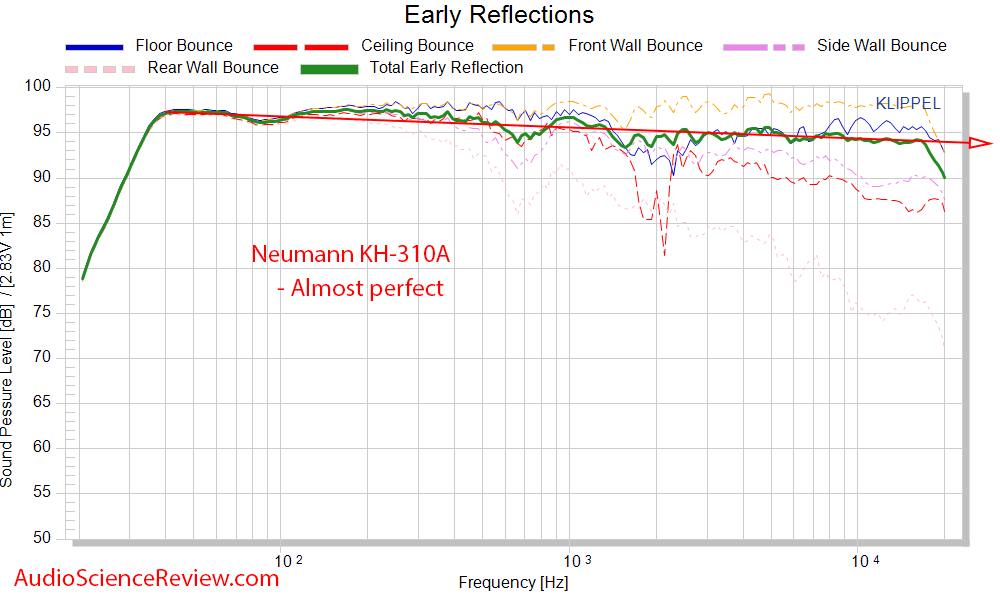

These images are from ASR. Look at the frequency response deviations caused by all the bounces. Neumann fares better than most, but still has a nasty ~2 KHz dip caused by the ceiling. This is not cancelled out by any other reflection. Genelec’s “The Ones” however hardly have any issues. This means that of all 3-way speakers, Genelec’s “The Ones” will sound far better than any other in typical rooms. Room correction can only go so far.
Some may notice that ATC and PMC aren’t listed; they have outrageously priced speakers and other gear and refuse to release measurements or send their high end models to reviewers to be measured, and what has been measured by reviewers isn’t very promising especially for the price. Therefore they haven’t earned a recommendation here despite their studio presence. ATCs are old, like Geithain. Ultimately, Genelec’s “The Ones” leave everyone else in the dust in a normal room, with only Neumann having something to say about it.
For example, this admittedly incomplete frequency response measurement of the >=$17k ATC SCM 50 is not the most promising. If we look at the axial frequency response, that “legendary” mid dome is pretty damn nonlinear between 1.5 KHz and its crossover point of 3.8 KHz. We’re very sensitive to these frequencies. That “S spec” tweeter doesn’t look very linear at all. And what’s up with the frequency response below 100 Hz? It’s removed, so this is not a great source.
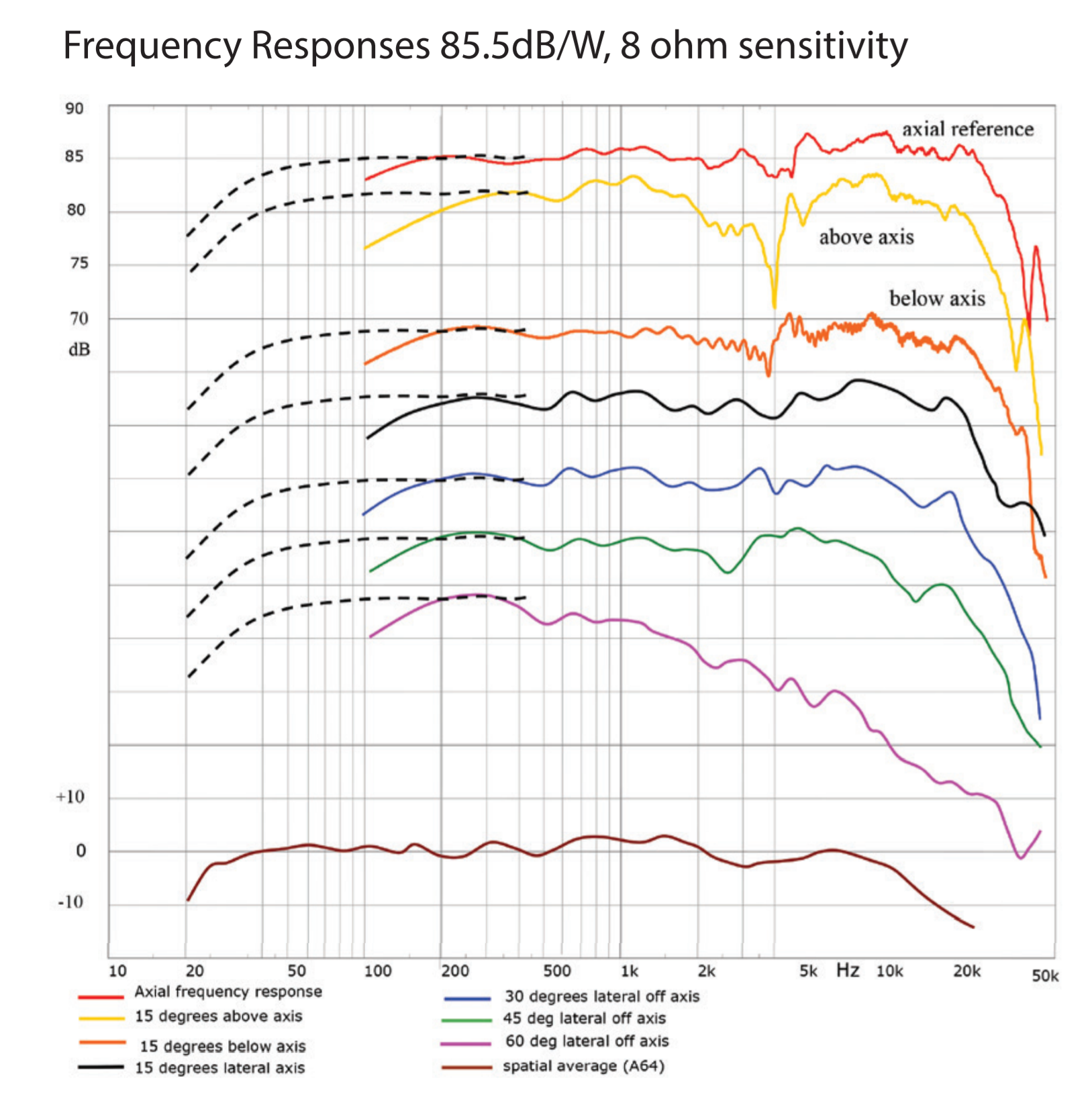
Zaph Audio has measured that famed ATC dome driver here, here, and here. It’s used between 380 Hz and 3.8 KHz in ATC speakers, and we can see it is far from the end all be all of linearity. CSD plot and harmonic distortion graph show that it’s not the cleanest. It may have been the best a long time ago, but technology improves pretty rapidly.
And if you’re into DIY speaker building, look at transducers from Accuton, SB Acoustics, Seas, Satori, Purifi. Volt is overpriced and underwhelming based on measurements. To go with these, stick with Purifi, Hypex, or 3e Audio for amplification with Hypex power supplies (and possibly Hypex DSP modules).
Avoid Soundbars
Soundbars are extremely popular in this day and age, but like the Apple AirPods Max, they’re overpriced and underperform. All of the above recommended speakers in 2 channel format annihilate all soundbars, not just in sound stage and spatial effects but also general tonality and frequency range extension. Avoid soundbars at all costs, they have NO use. A soundbar is like a shrunken down, crappy center channel speaker.
Ported or Sealed Subwoofer?

When shopping for higher end subwoofers, you’ll likely come across sealed subwoofers, although most subwoofers in general have bass ports somewhere on them. Sometimes they’re in the front, sometimes they’re in the back, sometimes they’re on the bottom. The same applies to speakers as some of those will have ports in very much the same way.
The general rule of thumb is, (sub)woofer ports mostly do three things:
- Increase bass output level
- Reduce bass distortion
- Potentially create more resonances in your room
So the reason ported (sub)woofers are most popular is more bass. People love their bass. But bass distortion is a common problem, which is another reason why ports are popular. I believe every 3-way studio monitor and main monitor in the world uses ports primarily to reduce distortion. This of course doesn’t mean ported subwoofers don’t have any audible distortion whatsoever, as most or all still do. Unfortunately, there’s a real lack of subwoofer measurements in the industry.
Recommended Headphones

Recommended Headphones by Price Range:
Sub $100 – you cannot get a very good over ear headphone for under $100, all are severely flawed. For this reason, my only recommendation currently is an IEM with virtually perfect measurements.
- 7Hz x Crinacle Zero: 2 – $25 IEM which measures so well that only the absolute best over-ear headphones, the Dan Clark Audio E3 ($2k), Stealth (4k), and Expanse ($4k) approach this level of technical performance! Its frequency response is near perfect – it’s within the range of what Harman research has uncovered to be the most preferred headphone frequency response Furthermore, it has basically zero measured distortion. IEMs also inherently have better group delay/CSD than over-ear and on-ear headphones since you’re not really hearing any reflections, just sound being injected down your ear canals.
All recommendations below are over-ear. If you need to attach a microphone to one, use an Antlion ModMic Wireless.
$100-140 – this is where over-ear headphones start to get good, although equalization is highly encouraged. For gaming, I also don’t recommend spending more than this (not counting microphone cost).
- AKG K361 (closed, foldable) – amazing value, doesn’t need as much EQ as any other headphone in this price range
- HiFiMan HE400se Stealth (open) – only has slightly deficient bass and a 2 KHz dip, but has low distortion so this can be equalized to achieve perfect tuning. Also has much more phase distortion than the AKG K371 and presumably K361.
- Drop + EPOS Sennheiser PC38X (open) – get this only if you need a gaming headset, otherwise the other recommendations in this price range are better and you can add an Antlion ModMic to them
$141-200
- AKG K371 (closed, foldable) – the best value in the over-ear headphone industry by far, doesn’t need as much EQ as most other headphones at any price point. Full range frequency response, no bass deficiency, inaudible levels of distortion even at very high volume levels, practically perfect phase performance aside from 95 Hz. I prefer this to the vast majority of >$1k headphones, and the research and objective performance data suggests most people would.
- HyperX Cloud Orbit S (closed) – I know, a gaming headset from a gaming brand. But this is a rebranded Audeze headphone, and while most Audeze headphones have a very poor frequency response, this one doesn’t. Amazing value.
$201-400
- Aune AR5000 (open) – requires EQ. Extremely sensitive headphone that’ll run on anything. PEQ preset can be found on Audio Science Review.
- Sennheiser HD 490 PRO (open) – this gets you tonality and imaging in the same realm as the HD 560S, HD 400 Pro, HD 6XX, but apparently slightly improved distortion. This, combined with the tonality makes this Sennheiser’s best ever non-electrostatic headphone, even better than their flagship HD 800S and HD 820. This is also very sensitive but has a nominal impedance of 120 ohm, though that’s far better than 300 ohm.
$401-600
- Dan Clark Audio AEON RT (closed) – $500, great build quality and comfort, needs EQ but once EQ’d it’s a top notch performer. Far less distortion and cleaner group delay/CSD (that is, significantly better time domain performance thanks to fewer internal resonances and reflections) than everything recommended earlier. Every over-ear headphone above has substantial phase distortion; this is where they start to perform well in this regard.
$601-1,000
- Dan Clark Audio AEON 2 (open, collapsible) – $900, needs EQ though less than everything recommended earlier. Stellar performer in every regard, outperforming every other open back by far for under $1k and only bested by the $4k DCA Expanse and probably the even more expensive DCA CORINA.
- Dan Clark Audio AEON 2 Noire (closed, collapsible) – $900, even better than the AEON RT. Again great comfort, light weight, and portability. Needs much less EQ than everything in the lower price brackets.
$1,000+ – At this point you should really be considering loudspeakers instead for home listening: the headphones below are better for getting technically perfect sound, but a nice 2.1 speaker setup is going to be more enjoyable to listen to. Or for gaming/movies/shows, you should only be considering a surround sound system at these prices.
Also, at this price point I most strongly recommend Dan Clark Audio because they are innovating more than anyone else technologically and the data shows this. They really invest in and experiment with new technology to improve headphone performance as well as construction/comfort (i.e. self-adjusting headband), and these headphones below have some of the most generally agreeable out of the box sound signatures (Harman preference curve) + low enough distortion to take EQ well, so you can make them sound however you want. For example, I own one of the headphones recommended below (DCA E3) and have made a Harman linear in-room EQ profile for it, which is vastly different than the stock tuning.
This part is important: if you want to change something about the sound signature, you’re actually better off using parametric equalization on the below headphones rather than seeking out another headphone, because other 4 figure headphones are just too far off in performance such as distortion, group delay/CSD (big one – DCA is utterly without equal here), and often times comfort as well (Stax, Sennheiser, and Focal are at least good for comfort).
- Dan Clark Audio Expanse (open, collapsible) – I don’t generally recommend this due to its crazy $4k price tag, since for this price you can get speakers that obliterate all headphones, unless you’re mixing/mastering of course. Also, there might soon be an open alternative to the Dan Clark Audio E3 which will perform the same but cost half.
- Dan Clark Audio E3 (closed, collapsible) – if you want the best closed back headphone, get this for $2k. Don’t bother with the Stealth, this is almost the same (arguably a tiny bit better or worse subjectively) for half the price, see the reviews for each on ASR. This is my go-to headphone. I can say with confidence that Dan Clark’s AMTS technology (metamaterial damping) is revolutionary and a must-have (which has been discovered in loudspeakers too like the KEF Meta speakers). No headphone without it approaches its treble linearity.
The Sennheiser HD 800S, like its predecessor, just has too much bass distortion to be worth a recommendation, not to mention its upper frequency response is less linear than the HD560S, HD 600 series, and HD 490 PRO, thus making the HD 490 PRO their best headphone.
Focals are usually good, but overpriced and whooped by the Dan Clark Audio headphones recommended above. Audezes have horrible upper frequency recession, and while their higher end models have supremely low THD and can be EQ’d to perform well, the fact of the matter is they have only an average group delay/CSD response (blown away by cheaper Dan Clark models) and they’re very heavy and thus uncomfortable after wearing them for 30-60 minutes depending on the individual.
The higher priced HiFiMan models aren’t worth it over the ones recommended above – price does not correspond with quality for HiFiMan. Their best headphones are all the HE-6 models, and there’s just no performance benefit going with their other expensive models over the Sundara with EQ, let alone the DCA headphones above which again whoop them. Again, if you like the HiFiMan tuning, you’d be better off getting one of the recommended DCAs above and EQing it, as this will perform better than the HiFiMan HE1000s and SUSVARA and any other. I once had the open box HE6se/HE6se v2 on the recommendation list since it’s $609-629, but I decided to remove it since the DCA AEON 2 delivers far cleaner group delay/CSD (so you don’t hear nearly as much reflected sound), it’s way more efficient, far better built, much more comfortable, and portable. The HE-6 models all require one of the more expensive headphone amplifiers below. It’s good overall but just hard to justify, especially since it’s open box. Brand new it’s $1,800 which is a joke.
JPS Labs headphones are awful thanks to enormous frequency response peaks and valleys, and usually awful group delay/CSD (even if not SUSVARA levels of bad). Audio Technicas aren’t competitive – they’re another brand for which the more you spend, the worse the headphone gets once you’re past the R70X (which isn’t competitive).
Stax headphones sound good, but are severely overpriced and have fallen behind technologically compared to Focal and DCA. Distortion is nonexistent in the high end Stax models, but group delay/CSD is only average or worse, and their stock tuning is rather bass deficient but you can fix their tonality with EQ at least for the SR-009s and X9000. But why pay all this money, along with the extreme costs for a 20 years out of date electrostatic headphone amplifier, for worse performance than less costly and better built DCA headphones?
Dan Clark Audio is really far ahead of everyone else with their current models. The group delay/CSD, or simply the phase coherence, of these recent Dan Clark flagships helps illustrate why they’re in a league of their own. See this measurement taken from ASR’s review of the DCA E3.
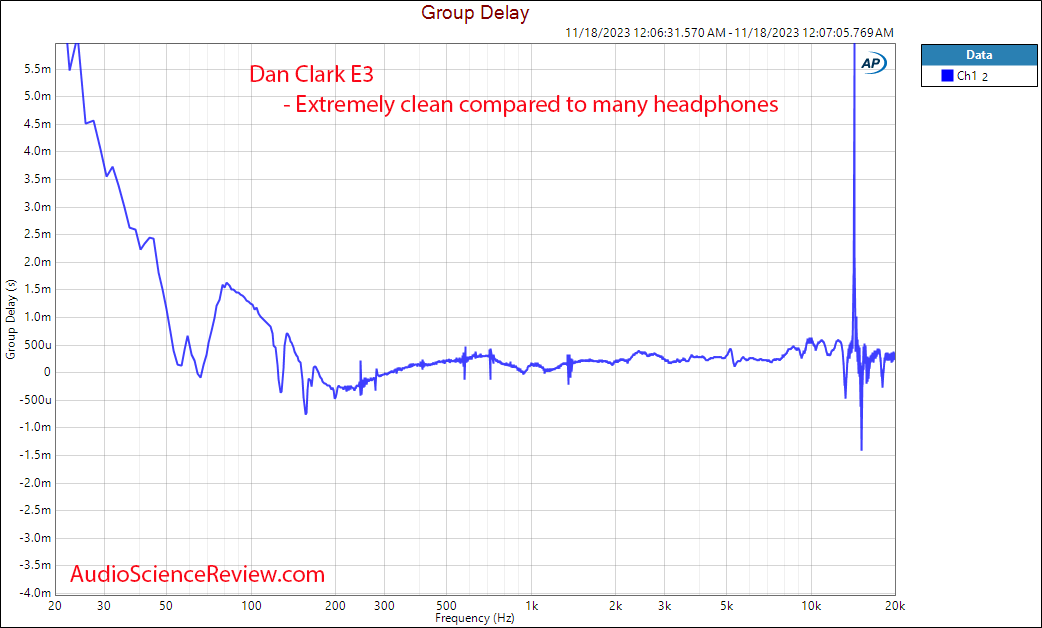
Compare that to the Focal Stellia which is better than most but a bit hyperactive in sub-bass reflections, Focal Utopia which is average here, Audeze LCD-X which is also about average except with a bit more sub-bass phase issues than usual, and the HiFiMan SUSVARA which is full of phase errors and internal reflections. What does this mean? This means the Dan Clark Audio E3 (and also Expanse and Stealth) performs very accurately in the time domain, and it better suppresses internal reflections than any headphone made by anyone else. With the other headphones, you hear more of the reflected sound. In the speaker realm, this is equivalent to room treatment, so the Dan Clarks are closer to an anechoic chamber while the others are closer to a normal room. We’re not affiliated with any brand, the data shows DCA is just on another level right now in engineering prowess. This was not always the case, and it will change again at some point.
Some audiophiles falsely claim that this reduction of phase errors in headphones like Dan Clark Audio models results in reduced “dynamics” but this is objectively false. It does result in a noticeably different sound, which they’ve just decided to call less dynamic (as in dynamic range – SPL difference between quietest and loudest sound). Phase distortion does not increase dynamic range, it’s just an inaccurate and misleading way some people (not many) describe a sound free of significant phase distortion. To most people, this just sounds “cleaner” like it has a “blacker background”. See the dictionary section above if you skipped it.
But remember, don’t just buy one of the above headphones and happily skip your merry way home. Do research. There are some other good headphones that I can’t recommend due to price combined with stronger and better priced competition above.
Also don’t be surprised if you get something like a Stax headphone and see it has no way of connecting to your computer. Electrostatic headphones need electrostatic amplifiers. Don’t be surprised if you get a $500 set of headphones, plug it into your onboard audio or phone, and be disappointed in sound quality. Some will sound okay like the Aune AR5000, but all of these will benefit from an external DAC and headphone amplifier, both of which are recommended below.
Amplifiers
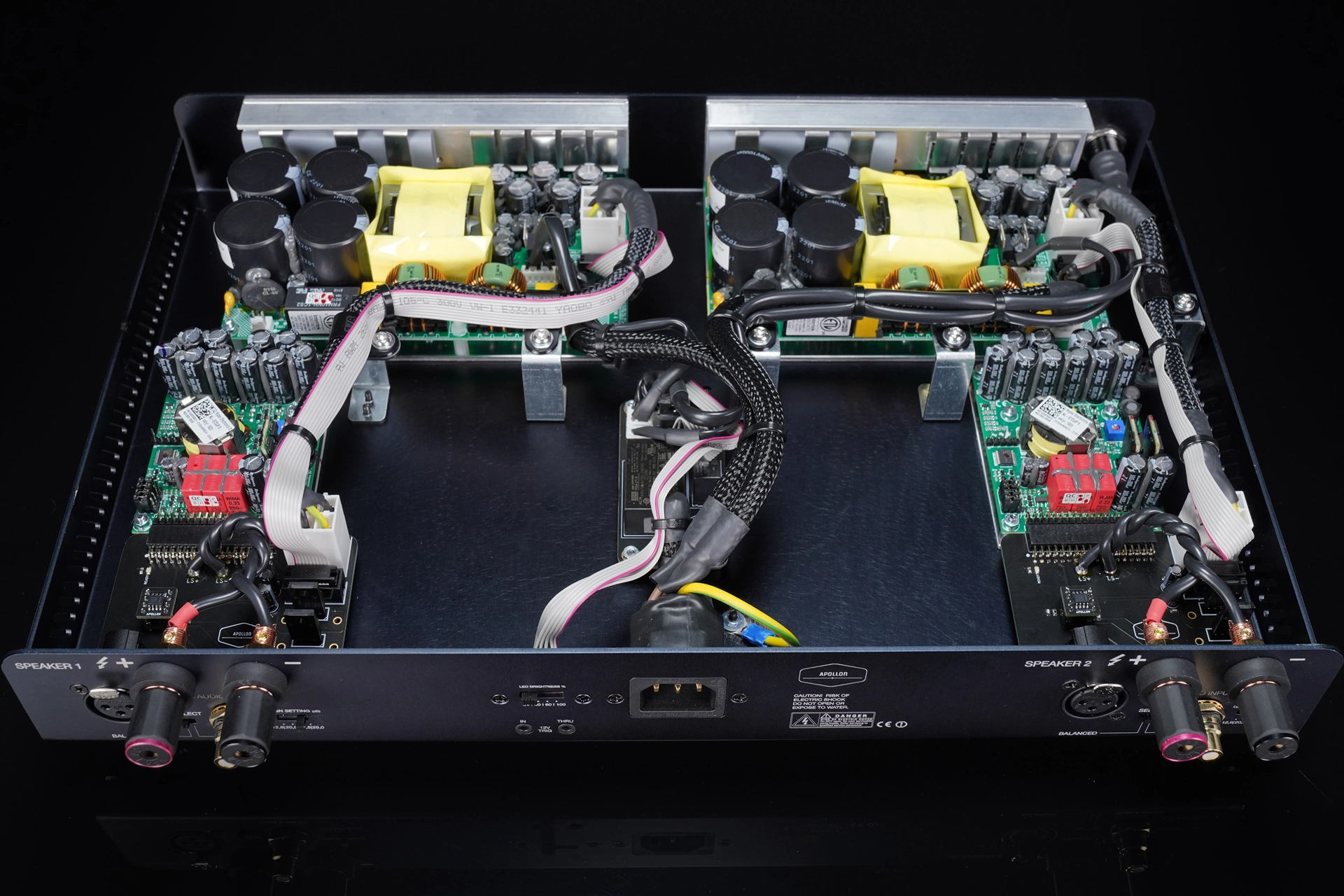
An audio amplifier has a simple job: amplify an incoming signal to the listener’s desired SPL (this is measured by the amplifier’s continuous stable output power, voltage, and current vs frequency), without adding audible noise and distortion across the audible band (20 Hz – 20 KHz – this is measured by THD+N vs frequency, IMD vs frequency, crossover distortion vs frequency, and all of these vs power graphs), to not have any crosstalk issues, while providing a completely flat frequency response at least within the audible band, and all of this criteria needs to be met regardless of the speaker’s current impedance. Ideally with as much efficiency as possible, to minimize your energy consumption (good for both the planet and your wallet) and to maximize service life.
That’s it. How an amplifier gets there is irrelevant, as long as it’s stable, safe, has a good service life, and has the features that you need. So things like Class A vs Class AB vs Class D vs Class whatever are irrelevant in that they’re not end goals. Same for whether the amplifiers are monoblocks or a single stereo amp, same for whether the amp uses global negative feedback or not, etc. Those are all means to an end.
This is all you really need to know at a high level, but if you want to dig deeper, here’s some more information on different components of amplifiers.
Amplifier Classes

First and foremost, an overview of amplifier classes which refers to the biasing of the output stage. Experienced audiophiles often swear by Class A or at least Class AB, and they look down upon Class D. Hardly any other amplifier class is relevant besides these: you’ll also see some Class G stuff from time to time but that’s pretty rare.
Class A’s benefit is supposed to be less distortion at the expense of efficiency, while Class D is the reverse: most efficient by far but supposedly more distortion. Then why do many audiophiles swear by Class A tube gear? The tubes add insane amounts of distortion, way more than pretty much any Class D solid state.
Now keep in mind these things:
- Distortion only has to be inaudible 100% of the time
- But you have to keep in mind the distortion you hear (if any) is the result of the distortion from every component in your system added together: the speakers/headphones produce the most distortion in the best systems, while the electronics (amplifier, DAC) produce the least. So you should prioritize buying electronics with the least amount of distortion, because your speakers/headphones will produce some.
- The most cutting edge amplifier design R&D has gone into Class D designs, due to the massive efficiency advantages they have
- As a result of #3, the power amplifiers with the lowest noise, distortion, and best overall measured performance are mostly Class D plus two Class AB amps. These Class D amps are manufactured by Hypex, Purifi, and 3e Audio. The aforementioned Class AB amps are produced by Topping (LA90 and LA90 Discrete) and Benchmark, and these are the absolute best performers in the world but only at lower power ratings (max 150Wpc RMS into 8 ohm for the Benchmark).
So if Class A’s benefit is supposed to be lower distortion at the expense of efficiency, why do all but one brand of Class A amplifiers (Boulder) have far more distortion (THD and IMD) than many Class AB and Class D amps? The answer: audiophoolery. You were not supposed to discover this.
Load dependent performance and nonlinear high frequency response are other historical issues with Class D amps, but engineering companies such as Hypex and Purifi have defeated these obstacles. Switching noise may have been a problem in the past with Class D amps, but for a while this hasn’t been an issue as switching noise hasn’t been close to the audible band for good Class D amps in a long time. How have all Class D obstacles been overcome? Hypex left some clues here, and Bruno Putzeys (legendary designer at Purifi) left some clues here.
Some will cite bandwidth. Of course, there are plenty of Class D amplifiers with a flat, load independent frequency response from 10 Hz to 20 KHz. But what about beyond? Well, beyond isn’t very important, but let’s look at the sub $1k Purifi EIGENTAKT 1ET400A. This has a flat frequency response from 10 Hz to 30 KHz, followed by a gradual dropoff that’s 0.5 dB down at 40 KHz, 1 dB down at 50 KHz, and then it drops off sharply from there. Here’s a graph. This is not your typical hi-fi wideband solid state amplifier that’s flat from 10 to over 50 KHz, but this won’t make any audible difference – obviously no one can hear anything close to 30 KHz even, the impact on phase is minimal, and such phase shifts in speaker systems have proven to be inaudible in all controlled studies thus far. And if you do want that kind of ridiculous >50 KHz bandwidth, Purifi’s new Class D flagship achieves it.
Another nail in the coffin against Class D blind hate is: most of the best measuring loudspeakers (most linear frequency response + lowest THD and IMD) are active, DSP controlled studio monitors powered by Class D amps. Your audiophile speakers with your “lower distortion” Class A Pass Labs amps (debunked below) have far more distortion than Class D driven studio monitors. So where’s the benefit of Class A? Also, newer Class D amps in active monitors outperform the obsolete Class AB chip amps used by older studio monitors.
Important Amplifier Specs and Measurements
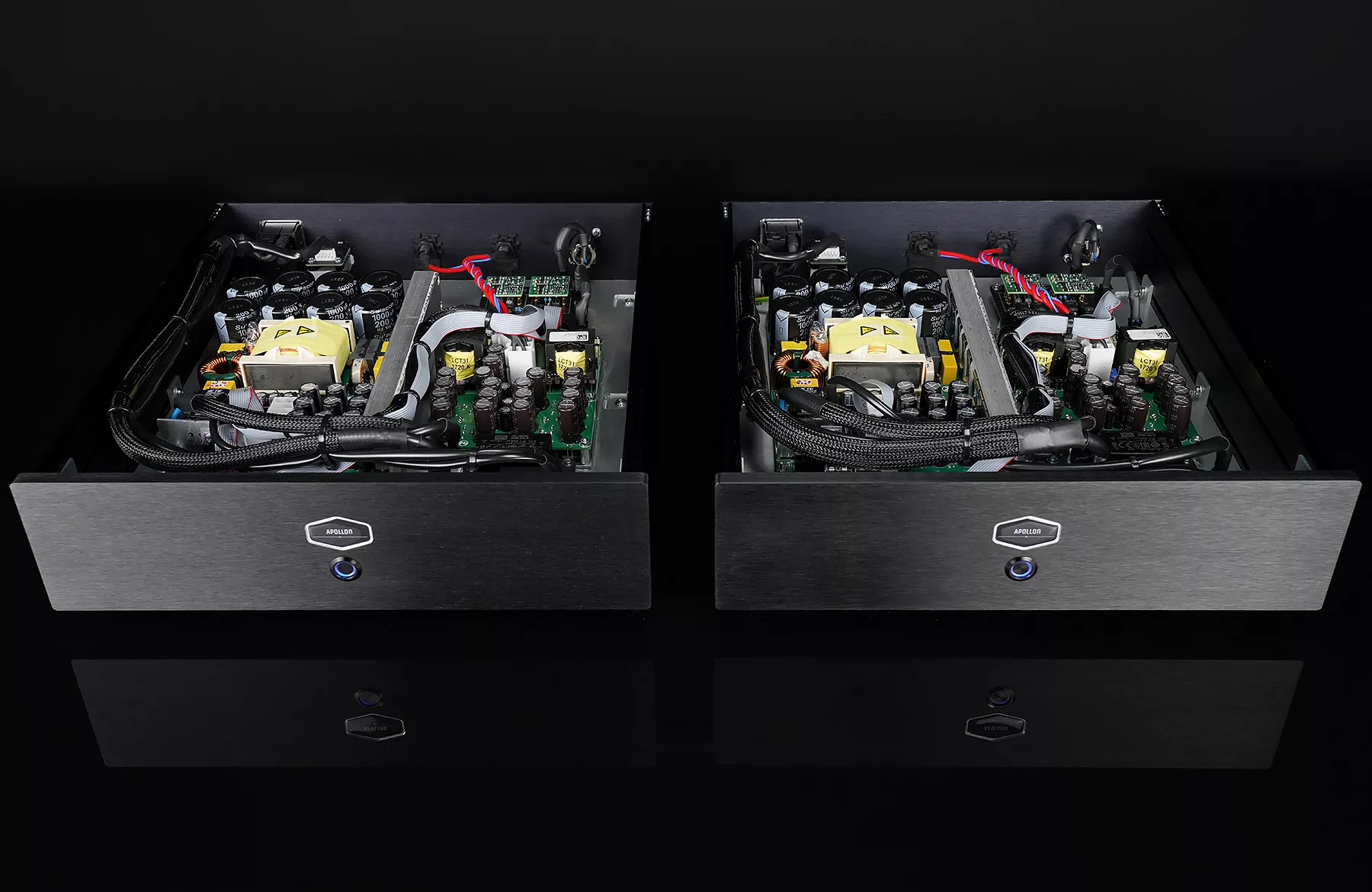
Let me first get something important out of the way: any two amplifiers that measure better than our audible thresholds while powering the same load, and have a flat frequency response in the audio band with said load, sound identical to us. Level matched, proper blind testing will confirm this if needed.
Manufacturer specs aren’t the most reliable, but some important specs to keep in mind besides power are THD+N (Total Harmonic Distortion + Noise) which is rated differently depending on the manufacturer. Best to look at reviews that measure this. Other important numbers are SNR (signal to noise ratio, higher is better), dynamic range – higher is better but our ears are limited to around 116 dB, while 16-bit audio (which is the minimum for music) has up to 96 dB and 24-bit audio has up to 144 dB (no electronics can produce this currently and it’s beyond what we can hear). Manufacturer specs are typically best case scenario, except for the brands recommended in this article who are confident enough to provide full measurements.
A useful measurement taken by some reviewers and the few manufacturers confident enough to measure their equipment is SINAD. This combines the data from THD+N and SNR into a readable number in decibels, higher being better.
Then there’s damping factor (ratio of speaker impedance to amp impedance, varies with frequency, higher is better), slew rate (essentially how fast it can change voltages, higher is better and the less output devices means the higher the potential slew rate at the cost of power), but these two don’t give any real indication of an amplifier’s performance so they’re not really worth noting. Better to look at the measurements. There’s also crosstalk which refers to one channel impacting the other so lower is better but this is a nonissue in any amplifier. Output impedance was discussed earlier (the lower the better, anything decent and solid state should be under 0.5 ohms), noise (lower is better), bandwidth (wider range is better but it only needs to be within the audible band of 20 Hz – 20 KHz), but specs aren’t always reliable and numbers aren’t everything. Measurements prove or disprove specs.
And yes, measurements matter significantly. Standard measuring equipment is far more sensitive than our ears. It is important for your electronics (amplifier, preamplifier, DAC) to perform as best as possible – minimal distortion, greatest dynamic range, highest SINAD – because you don’t want your electronics being your bottleneck. Of all your audio hardware, in a perfect system the speakers/headphones should be the bottlenecks because all other components can be perfected, but not those. The electronics should be fully transparent, and these measurements reveal whether they are or not.
Ultimately, the most important amplifier measurements are THD+N vs power (to show when it clips) and frequency response (should be self-explanatory at this point) above all. After this it’s multitone (which shows IMD an THD+N across multiple tones, usually 32 tones in most measurements) and SINAD but these are considerably less important than the first two.
It is also worth noting that standalone amplifiers are not a necessity as you can always go for active speakers, which is what the professional industry uses, from brands such as Neumann, Genelec, ADAM Audio, HEDD, and others. All of which are preferred over passive speakers, because the people who know best how to drive a speaker’s transducers are the best ones to build the amplifiers, and they end up having one amplifier per transducer plus an active crossover which is ideal.
Note that tube amps generally have far lower output power than solid state. Most tube amps are geared towards sensitive speakers, while power hungry speakers will be paired with solid state. The exceptions include EL84, KT88, KT90, KT120, KT150, tubes, which can deliver enough power for any speakers in the right amp. This brings us to our next topic…
Vacuum Tube vs Solid State
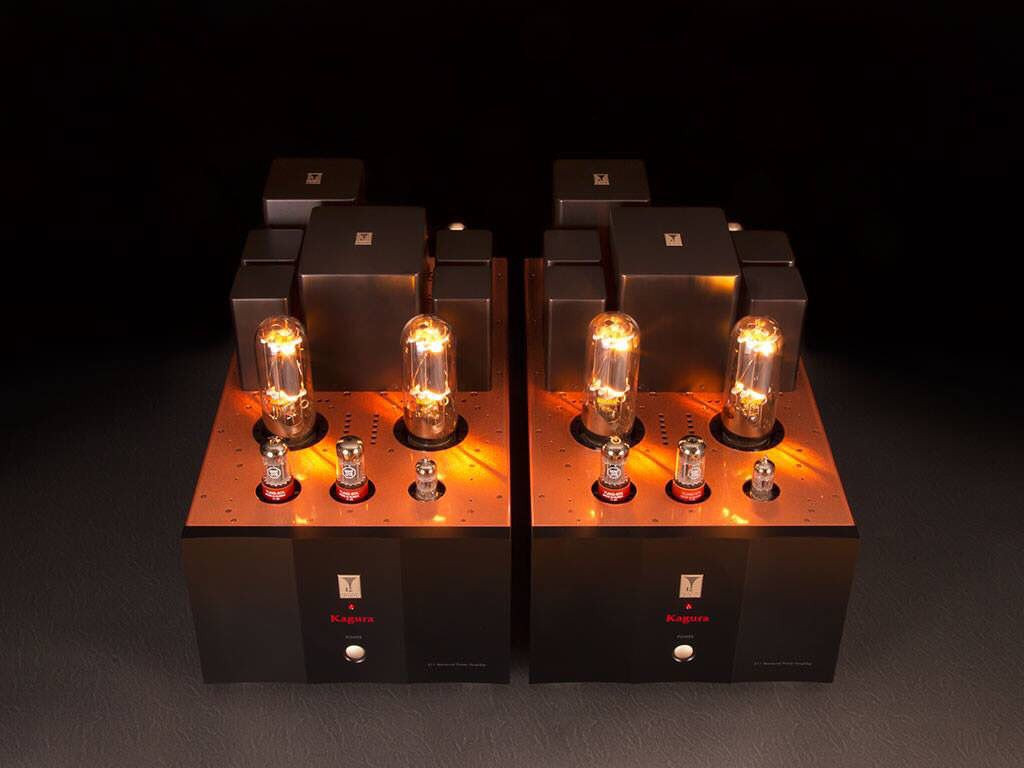
Tube amps and other tube gear still exists in the high end audiophile world. But the truth of the matter is, tube gear is only popular for the looks. They can look amazing, some are even like art pieces in your room which is their only appeal. Tube amps will generally sound different, and that’s because all you’re hearing is distortion, noise, and reduced dynamic range. Their dynamic range is usually between 50 dB and less than 70 dB! For 16-bit (up to 96 dB) music! Most people listen at close to 80 dB or more yet tube gear struggles to just reach 70 dB SINAD and dynamic range? Pathetic.
The reason some people like the sound of them is psychoacoustics: tube gear is expensive, looks cool, and audibly changes (degrades) sound. But the combination of cool looks + audibly different sound has a positive impression on some people purely due to human psychology. The fact is, they perform like crap.
Why? This is an easy one: technology improves over time. Vacuum tubes are inferior – more expensive, way less efficient, and greater distortion. Tube amplifiers only remain because they look really cool, but I cannot recommend paying more for less.
Tube vs solid state discussion usually arises in the context of amplifiers, which will either use vacuum tubes or, more commonly, transistors in the output (and input/voltage gain) stage.
There are several main types of tube amps: OTL or Output Transformerless, which only exists on the headphone market due to their really high output impedance and the only high impedance playback devices are some headphones (a very small amount). OTC stands for output transformer coupled which, as the name implies, means transformers control the output stage. All loudspeaker tube amplifiers are OTC.
Then there are tube hybrid amps, which combine tubes with some solid state components. Some of these use tubes for voltage gain and a solid state output stage, others only use tubes for the output, others use tubes as much as possible from the power supply rectifiers to the input stage, gain stage, and output stage.
For headphone amps, over 90% of tube hybrid amps likely do not run tubes within their recommended settings, so be weary of them. They will not sound optimal.
Different tubes have different sound characteristics and power, and you can’t just mix and match. Most tubes are very low power devices; even the most iconic 300B tube can only produce at most around 8Wpc RMS in a single ended amp, and 20Wpc RMS in a balanced amp.
Whereas 211 and 845 tubes are substantially more powerful and expensive, but still not potent enough for low efficiency speakers. Some of the only vacuum tubes that deliver enough power for low efficiency speakers (under 90 dB/mW) are KT88, KT90, and most of all KT120 and KT150 tubes, but these lack the refinement (linearity mostly) of 211 and 845 tubes.
In any case, avoid all tube gear, since you’re paying more for technically horrible performance.
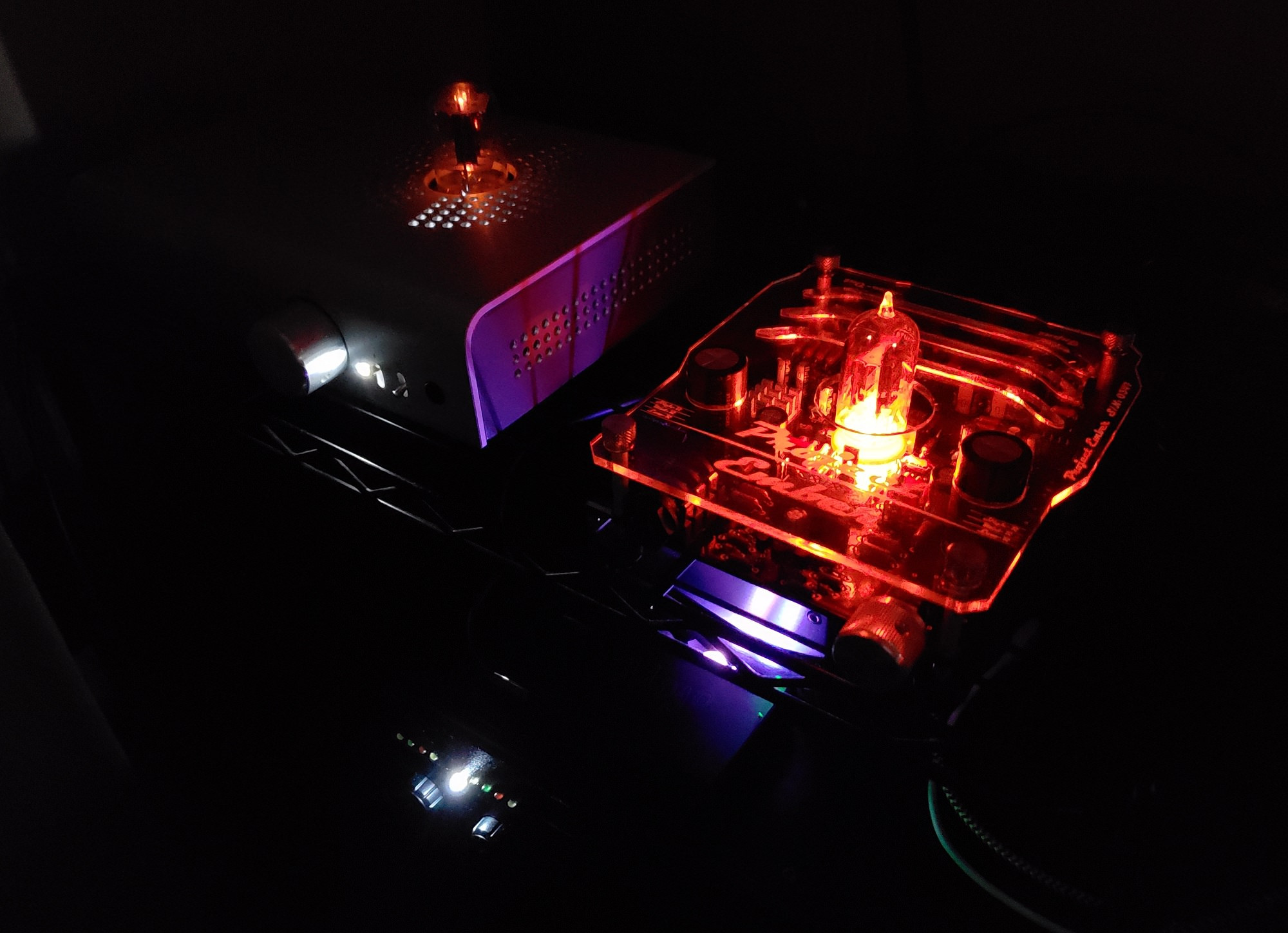
Look at how expensive tube amps compare to far more affordable Class D solid state amps: Luxman SQ-N150 ($3,295 tube amp, 10Wpc RMS) and PrimaLuna Dialogue Seven ($2,747 tube amp, 40-70Wpc RMS) versus the Topping LA90 Discrete ($800, 66Wpc RMS, best power amp ever measured), or even the ultra powerful Hypex NCOREx NCx500 (you can get a built one for around $1k, 380Wpc RMS). These aren’t even close, the affordable Topping and Class D Hypex annihilate them in every metric.
The SLuxman is full of power supply noise and channel imbalance: one channel achieves a horrible 0.3% THD+N at 5W, while the other achieves 0.43%. This leads to a SINAD of just 47-50 dB, versus the maximum 96 dB dynamic range of 16-bit music and 116 dB human hearing range (average), though most people listen to music in the 75-90 dB range, these tube amps can’t even come close to that dynamic range. The PrimaLuna achieves 0.12% THD+N and thus 58 dB SINAD, also full of power supply noise. Compared to the humble Topping’s THD+N of around 0.0001% leading to a SINAD of around 120 dB with no channel imbalance issues. Wow! Even the ultra powerful Class D Hypex amp achieves 0.0002% THD+N and a SINAD of 113 dB!
On the multitone test, the PrimaLuna achieves a pathetic 6.7-10 bits of distortion free range. The Luxman isn’t much better at 7-11 bits. Remember, we listen to 16-bit music and above. The unparalleled Topping has 21-bits of distortion free range and the Hypex also scored over 20-bits. The PrimaLuna additionally has a load-dependent frequency response unlike the others – this is a historical flaw of Class D amps, yet the Class D Hypex has no such issues. The Luxman also has crosstalk issues.
Every tube amp (that is, tube output stage) measures poorly with audible noise and distortion and far less dynamic range than 16-bit music. With only a tube gain stage, performance can actually be fine if using the best tubes for the job and running them within their rated parameters.

Things vary greatly within the solid state amplification world too. You can have a push/pull design or single ended design here too, topologies vary wildly. You can get an amp that uses a lot of negative feedback, a little, or none. The most common types of transistors used in the output stage are MOSFETs (for which there are different kinds, such as vertical vs lateral – vertical being most popular today but lateral being better suited for at least class B and above amps), followed by Bipolar Junction Transistors (BJTs). There are of course other kinds of field effect transistors such as Junction FETs (JFETs), but JFETs are not usually seen in output stages. But there’s really no need to think about amplifiers this low level, as it’s irrelevant unless you’re designing an amplifier. These are all just means to an end as well – one can design a perfectly transparent amplifier with all sorts of different transistor configurations.
Discrete vs Chip Amps
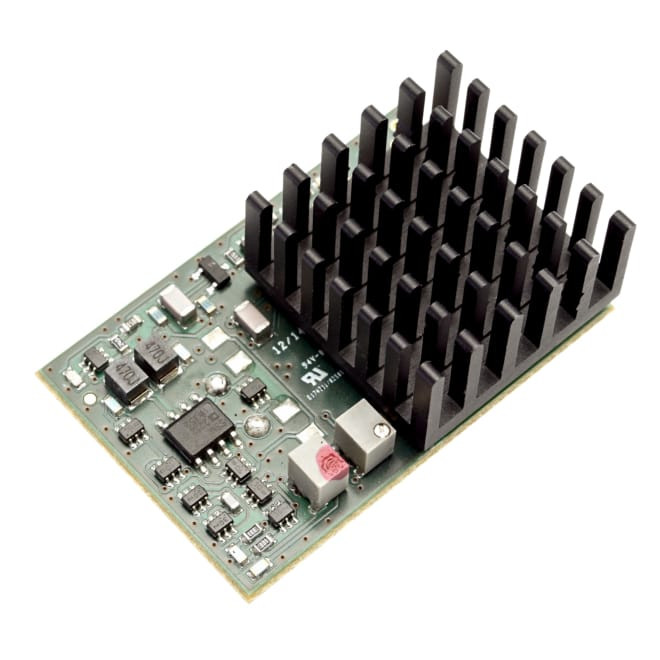
There’s also an endless debate about this. Chip amps refer to the use of opamps, or operational amplifiers – an amplifier in a black box, an amplifier IC (integrated circuit). Discrete instead has all discrete amplifier components in plain view, components such as the transistors, resistors, diodes, etc. Pictured above is a very distinct opamp – the Weiss OP2-BP.
Technically, you can have the exact same amplifier in both form factors, so really this is just a difference of packaging. Opamps can be easily replaced which is a benefit, and they’re far more cost effective and efficient. However, a designer has more control over a fully discrete design. Again, all of this is just a means to an end, the end being the simple measured performance of an amp that describes all sound characteristics.
But it generally makes much more sense to make a chip amp than a discrete amp, as a chip amp costs much less, is far smaller, has fewer parts, and there are so many good opamps and amplifier designs out there that it’s easy and cost efficient to design a fully transparent chip amplifier that performs far beyond audible thresholds. The reduced complexity and thus fewer chances for failure, as well as the lower cost, just make chip amps far more appealing.
Feedback Circuits – Good or Bad? (And a Brief Phase Discussion)
There’s a group of audiophiles, mostly the tube amp loyalists, that are absolutely against feedback loops in audio electronics – that is, using values produced at the output to feed back into the input, to produce more accurate output. Feedback loops make all the sense in the world from an engineering perspective – good luck finding an audio engineer with an EET degree against feedback loops.
All the best measuring and thus objectively best performing amplifiers use nested feedback (a mix of global and local negative feedback, typically both voltage and current feedback). Amps with no feedback loops (very rare) always produce audible distortion levels, thus poor SNR and inferior dynamic range. No, these measurement kingpins are not only the best in SINAD as anti-science audiophiles claim. The Class AB nested feedback (aka composite) amps are the best measuring in every metric. The Class D ones are the best in every metric except for bandwidth, where they are still fine. They feature an imperceptible high treble rolloff (maximum of under 0.3 dB in frequencies most adults cannot hear), they’re down 1 dB at 40 KHz, 2 dB at 60 KHz, and the dropoff is sharper from there. This has minimal, if any, impact on phase, and in all controlled listening tests, significant phase shifting (not a problem here) is inaudible in speaker systems due to just how bad room acoustics are and how chaotic/imprecise music is.
And for those who wish to know the absolute best measuring amplifiers in existence in every metric, not just SINAD:
Headphone Amplifiers – all are Class AB nested feedback chip amplifiers:
- Topping L30 II – single ended, moderate power, is not exceptional in volume channel matching though since it only uses a potentiometer
- Topping A70 Pro – balanced, high power, perfect channel matching (relay switched R2R volume control with 200+ steps)
Preamplifiers – all are Class AB nested feedback chip amplifiers:
- Benchmark LA4 – flat out the best
- Topping Pre90 – very close runner up, imperceptibly worse in a few metrics like crosstalk
- Topping A70 Pro – very close 3rd place
- Topping L70 – very close 4th place
Power Amplifiers – all are nested feedback chip amplifiers except for the first and last ones:
- Topping LA90 / LA90 Discrete – Class AB, the discrete one is discrete as the name implies. It has replaced the chip amp version. This is the absolute best measuring power amp ever, but that’s partially due to its limited power output (70Wpc/41Wpc RMS into 4/8 ohm respectively in ASR measurements).
- Purifi EIGENTAKT 1ET9040BA – Class D chip amp, rated at 350Wpc RMS into 8 ohm, 750Wpc RMS into 4 ohm, and at least 900Wpc RMS into 2 ohm. Not yet measured by third parties, but Purifi measurements of their own amplifiers have been accurate, and what they’ve shown puts this as the #1 high power amplifier in the world.
- Benchmark AHB2 – Class AB chip amp, 179Wpc/94Wpc RMS into 4/8 ohm respectively according to ASR. Very slightly load dependent frequency response, but less than the Class D champions (irrelevant difference however).
- Hypex NCOREx NCx 500 – Class D chip amp, performs about the same as the Benchmark except for power where it delivers 423Wpc/245Wpc RMS into 4/8 ohm respectively according to ASR
- Boulder amplifiers – all are fully discrete Class A
These aren’t amplifier recommendations, those are listed just below and sorted by price. There are other amplifiers that produce excellent technical performance and thus won’t sound any different to human ears (not too many more for power amplifiers though), but these are the champions in every metric. Purifi claims their upcoming 1ET9040BA is above their current amplifiers, so that may become the new high power champion.
The only outlier for the best measuring amplifiers are Boulder. These have 5-6 figure price tags and are only in the same league as Hypex and Purifi in measured sonic performance, except far less efficient because they’re Class A, and their parts count is so astronomical that I really wonder about failure rates.
Then there are less extreme audiophiles who think that too much feedback, especially global negative feedback, has some kind of mystical performance penalties that apparently can’t be measured? A few have dared cite what measurements this shows up in – bandwidth, which is just a frequency response graph that extends beyond the audible band. These daring audiophiles claim that amplifiers relying heavily on global negative feedback are not “wideband amplifiers” and thus suffer phase shifting or phase distortion. This, however, is easily debunked.

The above shows the extended frequency response of the SMSL SH-9. This is a headphone amplifier that uses two THX-AAA 888 amplifiers – audiophiles like to attack THX amplifiers because those involved in the business of selling overpriced audiophool gear have been maintaining a campaign that attacks all cost-effective gear that measures exceptionally well and flaunts these exceptional measurements (as they should). In this baseless slander campaign, these audiophiles claim that amplifiers that rely heavily on (global negative) feedback (these are nested feedback amplifiers that combine local and global negative feedback) “probably” suffer from phase distortion. They have no data to back this up, but here’s data!
This is as wideband as wideband amplifiers get! Flat frequency response from 10 Hz to 100 KHz. Because of this, there won’t be phase shifting. See the video above for how this relates. But I hear some audiophiles right now claiming that this isn’t a phase measurement, and they’re right. Such measurements are typically omitted from reviews because the one research paper that conducted controlled listening tests on phase, mentioned in the above video, found such phase shifting to be absolutely inaudible in loudspeaker systems, and also inaudible with headphone systems with music. However, that research should of course continue, and I want to help drive this.
What, you don’t think a Class D nested feedback amplifier is capable of such wide bandwidth? Behold the Purifi EIGENTAKT 1ET9040BA, the best high power amplifier in existence.
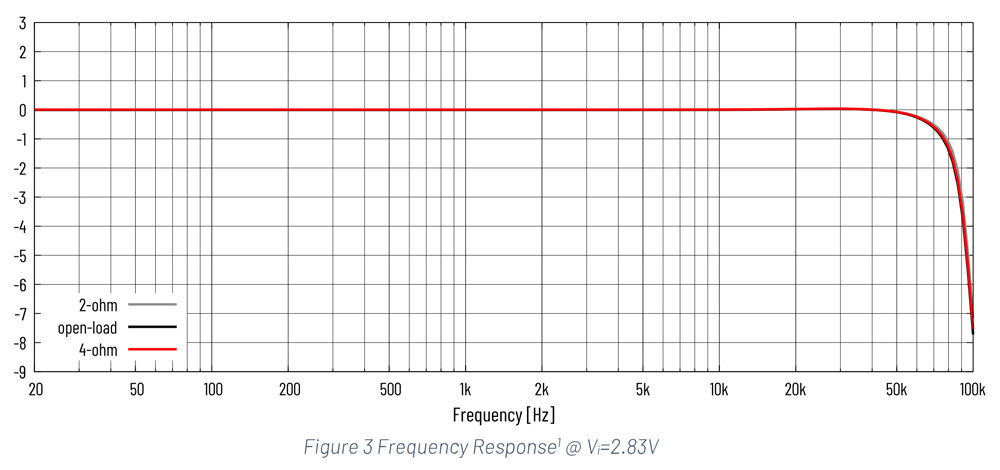
Again, that’s as wideband as bandwidth gets. You do have to pay at least €2,995 for that though. Let’s see what you can get from a high power Class D nested feedback amp for under $1k.
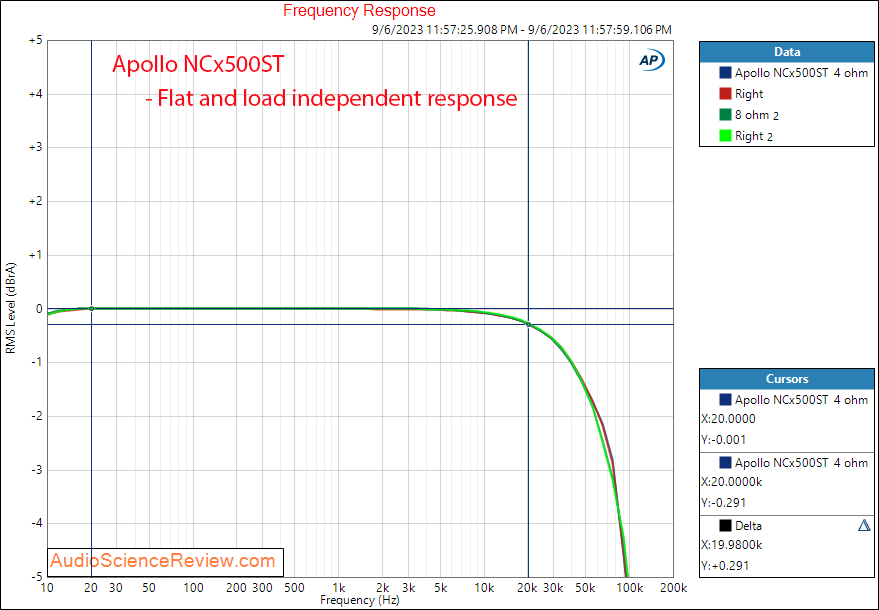
So this one isn’t technically flawless, but what we have is about a 0.2 dB dropoff in the upper treble, 1 dB dropoff at 40 KHz, 2 dB dropoff at 60 KHz. It’s audibly flawless.
One of my initiatives in the coming months is to try and get to the bottom of this, enlisting the help of those with Audio Precision analyzers. I am sending products to be measured, and one of my requests will be to compare the phase measurements of nested feedback amplifiers like those THX, SMSL, or Topping amplifiers, to “pure” Class A amplifiers like my HeadAmp GS-X Mini. Not only this, but then compare the group delay/CSD response of some headphones with both amplifiers. This will either prove or disprove this ultimately baseless theory, although level matched blind listening has so far been destroying its credibility (if it ever had any).
Balanced vs Single Ended
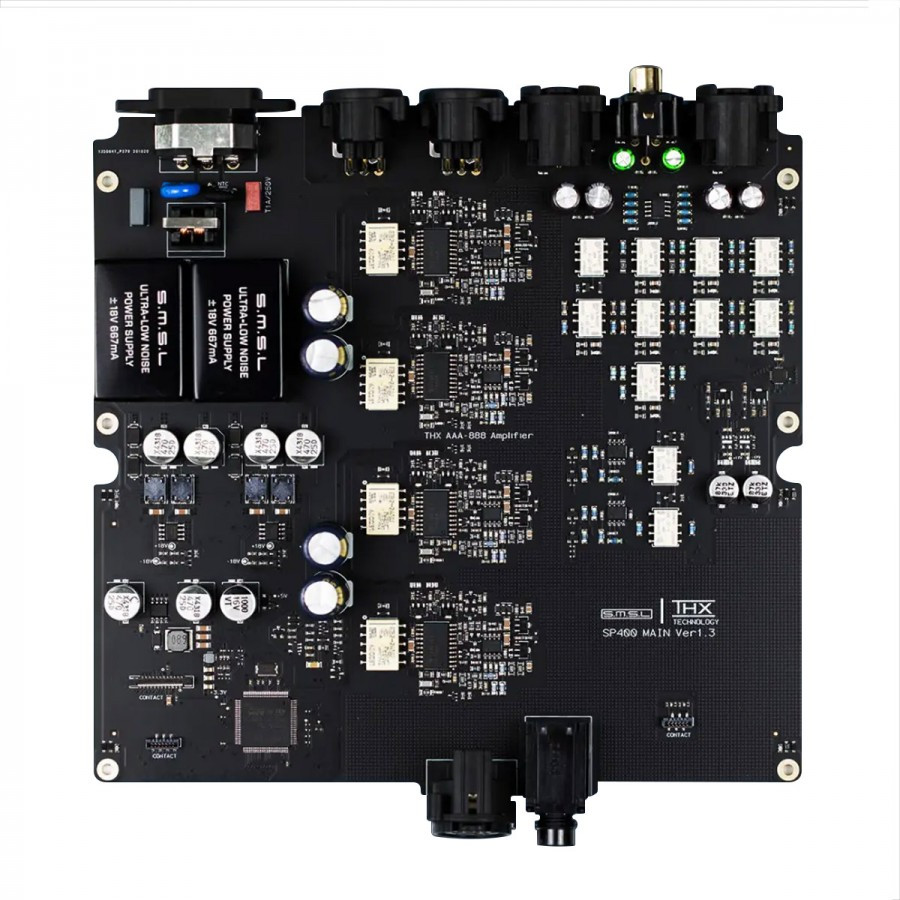
The insides of the SMSL SP400 (literally twice the $3,500 Benchmark HPA4 in terms of amplification, for almost 1/6 the price) make for a good illustration of balanced design. Four amplifiers are seen running down the middle vertically: one for the positive and negative signals of each channel (dual differential). Although not every balanced amplifier looks so obvious – there are individual opamps that are balanced amplifiers.
Amplifiers (headphone and speaker) and DACs are either single ended or balanced. Balanced is more rare and more expensive; in balanced amplifiers, the positive and negative signals for both the left and right channels each have their own separate amplifier with no shared ground, so that’s four amplifiers in total. So this is also referred to as: dual differential or quad mono, in 2-channel/stereo amplifiers. Balanced design creates more power, less distortion, less noise, thus greater dynamic range too.
Balanced equipment uses different connectors since they have to be wired differently due to the differential signaling. Most commonly they use XLR connectors for the balanced analog signals. Balanced 4.4mm headphone connectors also exist, and so do balanced 2.5mm headphone connectors.
If you’re spending hundreds or more on an amplifier, likewise if you’re spending many hundreds or more on a DAC, then they should really be truly balanced, otherwise you’re paying extra for snake oil. There’s no way around it. The industry professional standard at these price points are balanced because they use what’s best and don’t care for snake oil. More power, less distortion and noise.
Most balanced amps need to be fed a balanced signal in order to operate in fully balanced mode, but some have circuitry that converts single ended signals into balanced, and there are various ways of doing this, some better than others. You can use an opamp, a transformer (not recommended due to added distortion), or a fully discrete gain stage that converts single ended to balanced like Nelson Pass’s super symmetry. Or even vice versa: these days there are some amplifiers that not only convert SE to balanced, but also balanced to SE, just to provide maximum connectivity. Topping and SMSL has such designs, as does Schiit with their Nexus gain stage.
Don’t forget: while balanced equipment uses XLR cables, but not everything with XLR is truly balanced!
To our ears, the biggest difference balanced configuration makes is power output and noise reduction if you were having noise issues before. Also, balanced equipment uses XLR cables which are better than RCA cables; less degradation over distance, better noise rejection.
Monoblock Amplifiers
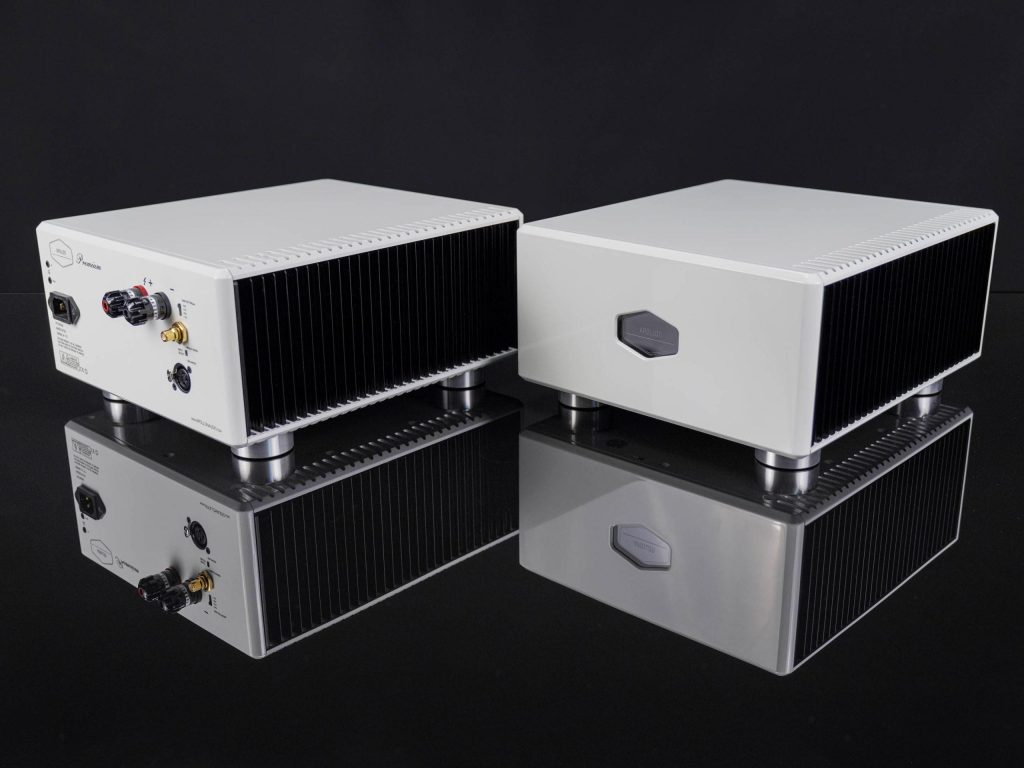
One other topic I’ll briefly cover is that of monoblock amplifiers, or simply mono amplifiers. As the name implies, this sort of amplifier only has a single channel, so you need two of them to drive a stereo system (two speakers). Though a fully dual mono amp generally achieves the same thing, which includes improved crosstalk.
For the vast majority of monoblock amplifiers, two of them are connected in a bridged configuration. In more rare cases, they are connected in parallel. Bridged is meant for 8 ohm and above speakers, and this doubles the output voltage but halves damping factor (not ideal). Parallel amplifiers double current, are suitable for lower impedance speakers like 4 ohm, and it halves output impedance (a good thing). Parallel amplifiers also don’t have to work as hard so thermals become less of an issue, which can have other effects such as keeping distortion down versus if the transistors were to heat up more. There’s a Wikipedia page on this.
Again, this is merely a means to an end and not an end goal in itself. But monoblock amplifiers are ultimately a waste of money. This is true whether you’re powering a two channel system, or anywhere from 3-6 channels, simply due to the current power amplifier market. You can get an end game amplifier with anywhere from two to six channels, that performs far beyond audible threshold (full transparency), can easily power any speaker in existence, and provides top notch objective performance, all for reasonable prices. Such recommendations are listed below. With monoblocks, you’re spending more for no benefit.
Power Supplies in Audio Electronics
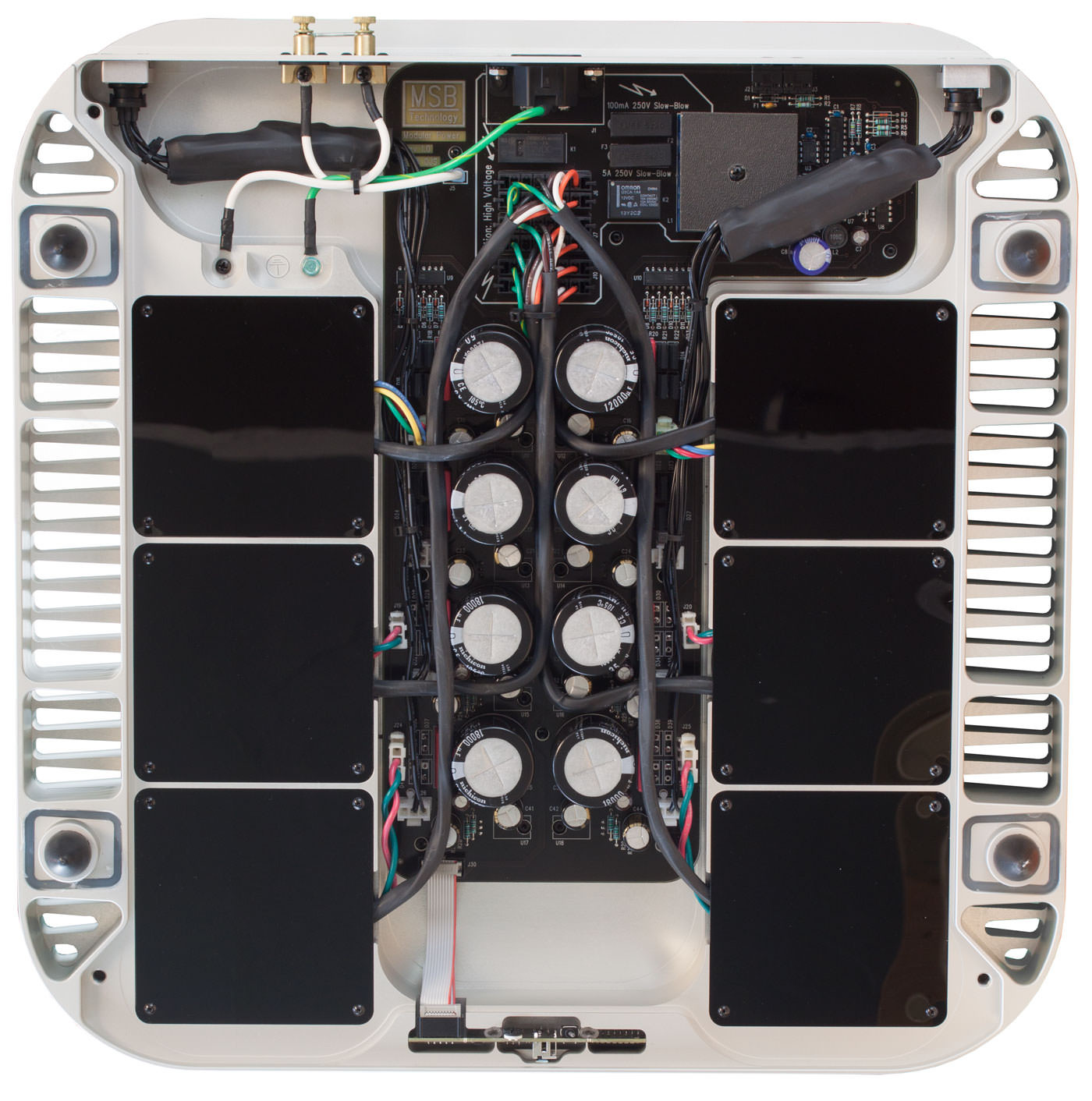
Read enough about audiophilia and you’ll see many manufacturers and communities state that only linear power supplies (LPS, one example pictured above) are acceptable in audio electronics. The alternative is switch mode power supplies (SMPS). You can find articles on this subject (don’t read any from audiophile websites/publications), but all you need to know is the following:
- Linear power supplies are much bigger and heavier due to the use of large power transformers, and they are significantly less efficient. This will noticeably impact your power bill with powerful amplifiers.
- SMPS is thus far more efficient on average (and when comparing the best of each)
- A bad power supply design fails to filter out noise, which then makes it into the audio signal. Thus the metrics they affect are THD+N and SNR (or more conveniently, SINAD) – the noise components of those.
- The audio electronics (DACs, preamps, headphone amps, power amps) with the best THD+N and SNR measurements all have SMPS. So much for your audiophilia LPS supremacy!
Additionally, the highest priced audiophile gear usually has multiple linear power supplies, and often in a separate chassis from the main electronics. Such as the extreme example shown above: that is the ~$150k MSB Technology SELECT DAC, which almost certainly performs significantly worse than the $80 SMSL SU-1 (again there’s no catch: the MSB is based on old failed design philosophy while the SU-1 uses the latest and greatest design), has one oversized toroidal power transformer underneath each of those black squares – 6 power transformers total for a DAC which doesn’t amplify anything. This entire chassis is only the power supply, by the way. This looks like a 20th century power supply design for a power amplifier, not a DAC which is a low power device!
While the image below shows the insides of the Topping D70 Pro Sabre DAC with the SMPS highlighted – all the power supply a DAC needs. I bet the Topping has lower noise than the MSB as well – the MSB hasn’t been measured (huge red flag as you should know by now), but all the lowest noise audio electronics use SMPS.

It always comes down to the pursuit of expensive, big, crazy looking gear. Linear power supplies have big power transformers, and to rich audiophiles that’s cool. But none of them perform better – all the audio electronics with the lowest measured noise use SMPS. All the audio electronics with the highest (worst) measured noise use linear power supplies along with vacuum tubes in multiple stages, and transformer coupling. Such noisy electronics are popular among audiophiles too, yet these same people complain about SMPS noise and Class D distortion – which as explained above, are usually multiple orders of magnitude superior. Note this is not because the SMPS itself has less noise; the noise is just easily filtered and switching noise is outside the audio band.
So once again, audiophiles are backwards. The THD+N and SNR king for power amps is the Topping LA90 Discrete which uses SMPS. For very powerful amps, the best come from Purifi and Hypex amplifiers using Hypex SMPS. For headphone amps, the best is the Topping L30 II though for very powerful ones, the leader is the Topping A70 Pro – both use SMPS. For preamps, the best is the Benchmark LA4 followed closely by Topping preamps, all of which use SMPS. For DACs, all the best use SMPS except for the SMSL SU-X which uses LPS to achieve the same THD+N and SNR as its Topping counterpart which uses SMPS.
One might ask, what are the actual benefits of audio electronics with LPS over SMPS? None. Only drawbacks: more weight, less efficiency, and no increase in performance. Here is the final nail in the coffin for linear power supplies.

Amplifier Performance Chart
Based on all of the above information, here’s a simple table outlining the main performance characteristics that define the quality of an amplifier. Not counting power of course, since power requirements vary per system and person. This applies to both headphone amps and power amps. Some things are taken for granted such as output impedance and crosstalk – I don’t think you can find a power amp or any in-production audio electronics with audible crosstalk issues or problematic output impedance at least for 4 ohm and above loads.
| Amplifier Rating | Frequency Response | SINAD and Dynamic Range (not A-weighted) | Distortion-free Range via Multitone |
|---|---|---|---|
| Failure | Nonlinear below 18 KHz and/or load dependent | <80 dB | <14 bits |
| Acceptable only at very low cost | Linear from 20 Hz – 18 KHz, load independent | 85 dB | 15 bits |
| Good | Linear from 20 Hz – 20 KHz, load independent | 96 dB | 16 bits |
| Great | Linear from 20 Hz – 20 KHz, load independent | 105 dB | 17 bits |
| State of the Art | Linear from <20 Hz – >20 KHz, load independent | 116 dB | 19 bits |
| Mythical | Linear from <20 Hz – >20 KHz, load independent | 144 dB | 24 bits |
Here’s a very useful list of how power amplifiers rank, along with the source of the measurements! You can see just how excellent the very powerful Class D Hypex NCOREx NCx500 is.
Note that my ratings above are based on value. There won’t be an audible difference between “Acceptable” and “State of the Art” amplifiers (if all other variables are the same) in any home listening, unless you can hear beyond 18 KHz in this example. Even if you can, such a difference is barely perceptible and probably won’t be in music. But since the amplifiers recommended below deliver better than “Acceptable” levels of performance starting at $150, holding such standards will help you get the best bang for your buck.
Now that we’ve talked a lot about technical parameters of amplifiers, let’s finally get to the recommendation lists.
Recommended Amplifiers
- None – No standalone amplifier is best. Get powered monitors if you can afford the good ones (big if)! The people who know best how to drive a transducer are the ones who designed it, and high end active monitors have one amplifier per driver plus an active crossover. Much better.
- Apollon Audio – a newer brand (2012) based in Slovenia, mostly known for producing Hypex and Purifi amplifier design (both European) which are two of the industry leaders in performance. Apollon offers nicer cases than other Hypex/Purifi builders, but this increases the cost. Ignore their premium amps unless you need the multichannel ones, as they are overpriced and some even outdated. Note: you can request Apollon Audio recap any amplifier for additional cost. Purifi and Hypex amplifiers come with Chinese made capacitors by default, which have questionable reliability compared to the best Japanese capacitors. Chances are, the brands below that also sell Hypex, Purifi, and/or 3e Audio amps offer the same services so be sure to ask about it.
- Buckeye – US based builder of Hypex and Purifi amps, including their latest and greatest. Be sure to upgrade to the speakON connectors which are more robust, easier to connect, and slightly improve performance (negligibly). So if you’re based in the US and need a very powerful power amp, get one from this brand with the speakON connector upgrade.
- Audiophonics – only their workshop amplifiers, which are French-built Purifi, 3e Audio, and Hypex amps. Apart from this they are also a store that sells some of the typical audiophile garbage, ignore that.
- boXem Audio – another European manufacturer (Luxembourg) of Purifi and Hypex designs, only the latest and greatest models too.
- Monolith by Monoprice – only their Hypex amplifiers, which are currently limited to an 8-channel NC252MP and an 8-channel NC502MP.
- Nord Acoustics – British manufacturer of Hypex and Purifi amps, including the budget ones. They even have the latest and greatest Hypex NCOREx NC500 amplifier (380Wpc RMS), with its mated power supply, for right around $1k.
- Topping – Some of the best measuring amps in the world, with their LA90 Discrete being THE best measured power amp in the world which of course means it isn’t excessively powerful (56Wpc RMS into 8 ohm)
- If you are an electrical engineer/very experienced electronics DIYer, and want a very good low budget power amp, check out 3e Audio’s kits. You need to get your own power supply, wiring, connectors, and chassis.
Recommended Power Amplifiers by Price: All of these amplifiers below outperform the ultra expensive audiophile stuff from brands like Pass Labs, Accuphase, Gryphon, darTZeel, Krell, Mcintosh, etc.
- Topping PA3s – $150 and over 30Wpc RMS into 8 ohm
- AIYIMA A70 w/ 48v 10A GaN supply – $220, no load dependency, 178Wpc RMS into 4 ohm, and 77Wpc RMS into 8 ohm
- Hypex NC252MP – starts at $575 from Buckeye, £350 from Nord Acoustics, and €550 from Audiophonics. Rated at 150Wpc RMS into 8 ohm, this is the point of diminishing returns for power amps. The Topping PA7/PA7 Plus outperforms this to an inaudible degree, but Topping power amps have a track record of reliability issues (mostly the PA5 series) therefore Hypex is recommended instead.
- Audiophonics AP300-S2503E – this is a 3e Audio PFFB amp for €500, rated at 150Wpc RMS into 8 ohm
- Hypex NC502MP – the Hypex NC502MP is a mid priced, powerful, load independent amp that measures very well and is rated for 350W into 8 ohm and 500W into 4 ohm. US customers can get one from Buckeye for $695 with free shipping, UK and European based customers can get one from Nord Acoustics‘ Value Line for £519 or from Audiophonics for €699. This is the point of diminishing returns for ultra low sensitivity speakers. There’s no tangible benefit in spending more.
- Topping LA90 Discrete – $800 and the best measuring power amp in existence, but somewhat questionable reliability and only moderate power which is part of the reason it measures so well compared to the others. 70Wpc RMS into 4 ohm, 41Wpc RMS into 8 ohm, 279Wpc RMS into 4 ohm with two of them bridged. Only get this if you want the best possible low-medium power amplifier.
- Hypex NCOREx NCx500 – of all very powerful amps, this is the one with the best third party measurements, but this is likely soon to be dethroned by the Purifi 1ET9040BA at a much higher price. Starts at $995 from Buckeye, £889 from Nord Acoustics Value Line, €1,090 from Apollon Audio and Audiophonics, and €1,110 from BoXem.
- Purifi EIGENTAKT 1ET9040BA – the unconfirmed high power kingpin, this power amplifier is for those with too much money to burn and want the best of the best, even though it’s at best inaudibly better than the above Hypex NCx500. Rated at 375Wpc RMS into 8 ohm and 750Wpc RMS into 4 ohm, this is only built by the above recommended manufacturers in “premium” dual mono/monoblock form, so the starting price is very high. Starts at €2,990 from Audiophonics.
I honestly can’t recommend anything else at this point. The Benchmark AHB2 is great but way overpriced and old. It was once king of the hill, but it has been dethroned overall. It doesn’t have meaningful wins over the roughly $1k Hypex NCOREx NCx500 which provides over twice the output power into 8 ohm! Indeed, no Purifi either, since while their EIGENTAKT are as good as it gets for high performance + high power, the NCx500 is technically a tiny bit better (and more powerful) and costs less. At least until their new 1ET9040BA comes out, but the cost of that will be hard to justify.
I also don’t recommend the Hypex Nilai500DIY because the NCx500 is better to a negligible degree, has a lower entry cost, and is far more widely available so why bother with the Nilai?
Unfortunately, the Topping PA5 II / PA5 II Plus had to be removed from this list due to overwhelming failure rates – a user poll on ASR with 342 votes currently (albeit unverified) show a 50-50 split for failures. Keep this in mind if you go for another Topping power amp. The PA3s is too good not to recommend, I left the LA90 Discrete on the list due to being the best measuring power amp by far, but for that price you can get something from Hypex or Purifi so I’d personally recommend the latter instead, even if you don’t need the power.
Similarly, Schiit is pretty good, confident enough to provide detailed measurements these days unlike high end audiophile brands, but their affordable power amps are outclassed by Topping and Hypex, while their high end ones are all of the old school mentality and thus outclassed by Hypex, Purifi, 3e Audio, and two bridged Topping LA90s, and that superior competition costs less. Though those old school Schiits are surprisingly not schiit – better than most of the big name, big buck stuff (probably better than all but Boulder), but nonetheless thoroughly outclassed for less money by the amps above. Additionally, Schiit’s customer service has a very poor reputation. See the horror stories on Reddit and Audio Science Review. Head-Fi and Superbestaudiofriends (SBAF) suppress this as they are Schiit partners.
Otherwise, the vast majority of the hi-fi amplifier market uses dated designs with poor SINAD and dynamic range (often under 100 or even 90 dB!) yet charge a fortune. SMSL has some good options but are currently bested by Topping for the same price or less.
The more you spend, the fancier components you get but the designs often don’t improve, or sometimes even get worse such as ultra expensive single ended triode tube amps with audible levels of distortion, or ultra expensive solid state amps with no feedback and again high/audible distortion levels. One of the best examples of this is the insanely priced darTZeel amps which have no feedback loops and thus tons of audible distortion (like many tube amps) for 5-6 figure price tags. Nonsensical design; you’re paying for the exotic ketchup/mustard looks.
We can see this in the measurements for darTZeel: here’s their flagship stereo amp which has a 5 figure price tag, and here’s their flagship monoblock amp which has a 6 figure price range. The stereo amp is only rated for 150W RMS into 8 ohms. So is the Topping PA7 Plus. The darTZeel stereo amp achieves 86.7 dB SNR in one channel and 81.4 dB in the other – 5 figure price tag for audible channel imbalance? What a joke! A-weighted, it achieves 99-102 dB SNR. The $330 Topping unfortunately wasn’t measured on the exact same settings, but at 5W output achieves 105 dB SNR and at max power 122 dB and none of this A-weighted, all with no channel imbalance. The Topping also has much lower distortion.
The 6 figure price tag darTZeel monoblocks achieve a whopping 72 dB SNR or 87 dB A-weighted, compared to the sub $1k far more powerful Hypex NCOREx NCx500 in stereo mode which, without A-weighting, achieves 116 dB SNR at 5W output and 138 dB at full power. The Hypex also outperforms the darTZeel in distortion by orders of magnitude. So if one was deciding between spending a fortune on darTZeel amps vs sanely priced Topping or Hypex amps, the choice comes down to whether you want to buy something to show off, or instead buy something that performs best.

Other top audiophile amplifier brands such as Pass Labs, Gryphon, Mcintosh, Krell, and even Accuphase don’t perform nearly as well as the far more affordable, more efficient, more sane designs from Hypex, Purifi, Topping, SMSL. These uber expensive boutique products are built to show off, not to perform.
For example, compare the Accuphase E-270 ($5,000, 90Wpc RMS) to the Hypex NCOREx NCx500 which you can get from Nord Acoustics for around $1k, and it delivers 380Wpc RMS. 105 SINAD for the $5k Accuphase or 97 dB with XLR input, vs 113 dB SINAD for the Hypex. Significant power supply noise spikes in the $5k Accuphase, despite its linear power supplies. The ultra powerful Hypex amps, even the older ones, have no such issues with their switch mode power supplies. The problematic XLR input of the Accuphase shows design flaws that don’t exist in affordable Hypex, Purifi, 3e Audio, and Topping amps. The $5k Accuphase is outclassed.
You think the Nelson Pass designed Amp Camp Amp kit is a good value? Guess again. It’s one of the worst power amps money can buy. First Watt designs are better, not bad in every metric, but have severe noise issues and as a result poor SINAD. Crap by modern standards.
Do you think Pass Labs can do better than Accuphase and darTZeel, and perhaps match affordable modern gear? Take a look at how the $18,735 Pass Labs XP-32 preamp measures up to the $600 Topping Pre90. The XP-32 gets one win in crosstalk due to the physically separated channels, but the crosstalk of both are well below the point of being audible, so this is irrelevant. The SNR for the XP-32 within the audio band is 95 dB, compared to 119 dB of the Topping. The Topping also produces significantly less THD, especially at higher voltages. IMD is also cleaner on the Topping. That’s $19k losing to $600.
Does the $63,000 Gryphon Commander preamp fare better? Well, the $600 Topping Pre90 still has far better THD+N, better IMD, but the crosstalk measurement of the Topping isn’t as good but still inaudible for both. The THD+N and IMD aren’t individually problematic in the $63k Gryphon and generally shouldn’t be a problem, but remember that noise and distortion adds throughout your chain, with all of the components. In any case, what are you paying $63k for? Worse measurements in every metric except one? No, you’re paying for the cool looking chassis and the “Made in Denmark” stamp.
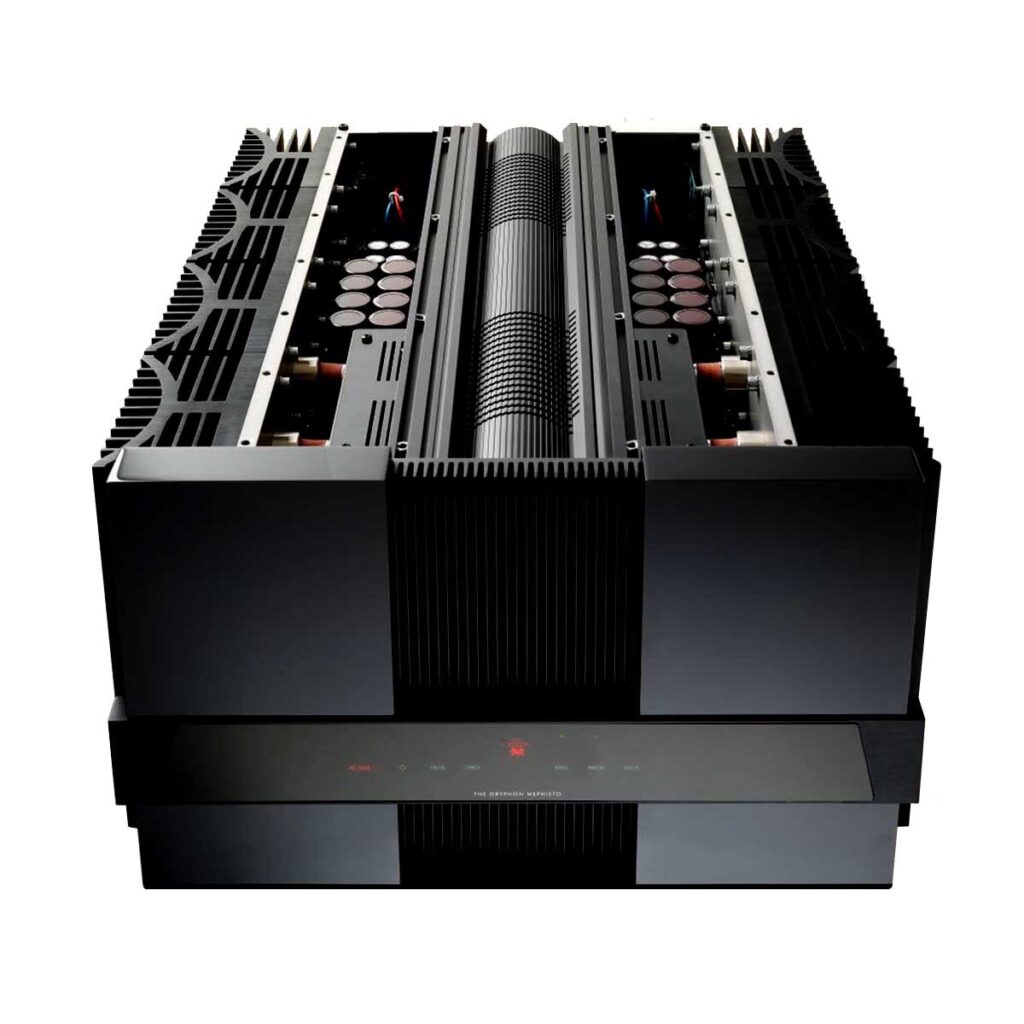
How does Gryphon’s $99k flagship stereo power amp measure up? Compared to the ~$1k Hypex NCOREx NCx500 mentioned above which is considerably more powerful into 8 ohm and about equal into 4 ohm, at high gain the Gryphon’s crosstalk at worst case scenario is a tiny bit worse than Hypex, but better at the opposite end of the spectrum – both differences insignificant as we’re talking just over -100 dB vs -93 dB on one end, and -80 dB vs -82 dB on the other. The Hypex also has a low gain mode that has better crosstalk than all of the above. Much better THD+N in the Hypex.
The Pass Labs XA25 ($5,150) is one of the most popular high end audiophile power amps. Let’s see how it measures: -76 to -90 dB crosstalk compared to -76 dB to -102 dB for the $250 Topping PA5 II which is rated for over twice the power. Note: these measurements come from different sources unlike the last comparison. 95 dB SNR for the XA25 in the audio band versus 107 dB from the Topping at 5W output or 121 dB from the Topping at full power! Not only does the Topping show less THD+N, but the Class A Pass Labs XA25’s THD+N rises sharply with frequency, going from a minimum of 0.001% up to 0.3% at 8 ohm! The $250 Class D Topping does have the same issue, unlike the $800 Topping LA90 Discrete. Again, what are you paying for? Chassis design? “Made in the USA” for Pass Labs, “Made in Denmark” for Gryphon, “Made in Switzerland” for darTZeel? Much better measuring Hypex and Purifi amps are made in Europe too by the way – Slovenia for Apollon Audio, Luxembourg for boXem, France for Audiophonics, UK for Nord Acoustics.

The one audiophile brand that seems to have consistently well performing amplifiers is Boulder, which are legitimately designed to the extreme but also cost 5-6 figures without clearly overall outperforming the likes of Hypex. Boulder amplifiers are massively overbuilt Class A – the above image shows their 3050 mono amplifier. Look at the amount of components and things like the custom wound giant transformers. Fully discrete of course. All of this for performance that’s still only in the same class as the Hypex NCORE 2k, which is a tiny fraction of the price, far smaller, and significantly more efficient. Boulder is still audiophilia, but unlike darTZeel, Pass Labs, Gryphon, and all the other audiophool brands, they do perform. But obviously don’t expect something with that many parts to be reliable.
It is sane brands like Hypex, Purifi, and 3e Audio recommended above that actually drive the technology forward with real research, backed by real data unlike most of the audiophile/hi-fi industry. We know how to measure everything about these audio electronics, and the data backs this.
As for A/V receivers and processors, here are the best brands. Very few though are elite performers, which is understandable given the tradeoffs with such a device. Someone really needs to make an A/V processor with 2x ESS Sabre ES9039PRO DACs, and an A/V receiver with those plus Hypex or 3e Audio amplifier modules with Hypex power supplies.
Recommended A/V Receiver/Processor Brands:
If you have the budget, get one that features Dirac Live Active Room Treatment (ART). Anthem won’t have this but the other brands below will.
Performance comparison as of December 2023 via ASR: link
The photo above is what audiophoolery looks like. Any audio electronics that look like this inside cost a ton of money and perform horribly. Nothing in the pro audio world has looked like this since the 1970s or earlier. This is an output transformer coupled tube preamp that costs tens of thousands or hundreds of thousands of dollars. Here’s what it does: it absolutely ruins the SINAD and dynamic range of any system! Unless said system is using a similarly bad DAC, which we’ll go over later. With a preamp like his, say goodbye to any hope of coming anywhere close to accurately resolving 16-bit audio!
But you might not need a preamplifier at all. Why do we need more gain in our home systems? Do you have insanely long analog cable runs (tens of meters)? I doubt it but if you do, then yes you might want a preamp with gain. Otherwise, the power amp already has its gain stages. Adding another gain stage (and buffers) before that only reduces performance of the system in SINAD typically.
There are passive preamps without gain, just providing analog volume control. However, passive potentiometer/attenuator preamps can create impedance mismatch and some other issues.
The real goals for preamps are: connectivity and analog volume control, while minimizing added distortion and noise, and ensuring that the analog signal going into your power amp isn’t too low or full of noise/distortion (cables come ino play here too). But you don’t need extra gain unless your cables are really long. A preamp can act as a sort of hub for a system. If you don’t need this (no headphone system does), skip past preamps.
For cheap passive preamps if you just require passive analog volume control, then get a Schiit Sys or something similar. But beware of impedance matching issues with any passive preamps. The Sys also has a potentiometer for volume control which is subject to potential channel imbalance (luck of the draw, more on this below). But this is all you should be looking at for passive.
Goldpoint has horribly overpriced passive preamps with their balanced stereo and balanced dual mono passive preamps that use their simple, obsolete stepped attenuators with only 24-47 steps. No remote control on most of these though. Not only that, but these Goldpoints are horrendously overpriced. Just a simple 24-47 step attenuator, no remote, nothing else really since it’s passive, for $600-900? Same crap from KHOZMO. Ignore them.
For $700 you can get a US made Schiit Kara which has a 128 step relay switched ladder attenuator with a remote (infinitely better volume control than Goldpoint’s 2000s designs), it can work in passive mode, or active mode with 2 gain options which will convert SE to balanced and vice versa, and I don’t even recommend this. For $600 you can get an even better performing active preamp than the Schiit Kara from Topping, the Pre90, and again I don’t even recommend this. For $500 you can get a Topping A70 Pro with virtually identical preamp performance to the Pre90, but it also includes the best high power headphone amp in the world. For $350 you can get a virtually identical preamplifier from Topping called the L70, which includes a headphone amplifier nearly as magnificent as the A70 Pro, though this is incompatible with Topping’s input extender. Either way, ignore Goldpoint.
People who just like to spend a lot of money and are really into passive preamps go for an autoformer, e.g. Emia Elamformer ($3,750 or $6,400 with silver windings which accomplishes nothing, doesn’t even come with a remote) and Emia Remote Autoformer ($4,875 or $7,525 with silver windings) or icOn ($5,855 or $7,855 with silver windings). These are scams, nothing more. It’s literally just an auto transformer (transformer without the secondary) – a cheap electrical component unless you use silver windings like an idiot – in a very nice looking box, for thousands of dollars. Transformers add significant noise and distortion to audio signals when in the signal path, they always ruin sound. That’s a pro tip: if you have a transformer in your signal path, your performance is ruined because your analog signal is tainted with audible noise and distortion.
So audiophools see that these autoformers are very expensive, look very nice, are made in Europe, and when they try them out, they hear a difference in their system – significantly increased noise and distortion. They don’t generally prefer this sound, but the fact that they hear a difference from these expensive, nice looking, made in Europe products, makes them like the product more. The same mindset that’s common among those who favor R2R DACs and tube gear.
So with an autoformer, you’re paying a ton of money for audibly awful performance yet again, like with expensive tube gear and boutique DACs (especially R2R). As a bonus, with an autoformer you also don’t get many steps of volume control. More money for worse performance in every way. Not recommended. The preamps recommended below cost far less, perform much better, and are far more convenient.
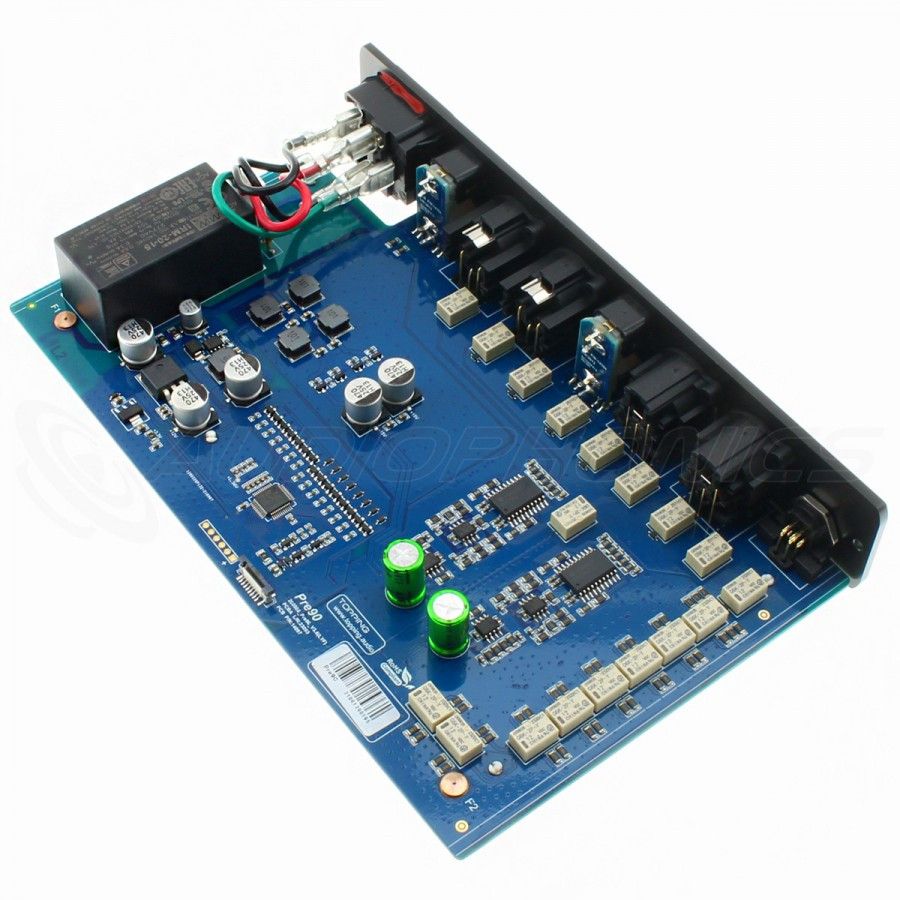
The above is what a well designed, well made preamplifier designed to actually perform well, looks like – the Topping Pre90 which is $600. Of course, not all electronics that look like this are good, but all the high performing electronics do look like this. We see a switch mode power supply (SMPS) instead of linear (much more efficient, smaller, lighter) like in all the top performers save for one DAC (SMSL SU-X); we don’t see multiple linear power supplies with enormous >1,000VA power transformers that accomplish nothing but waste money and material in audio electronics. We see integrated circuit (IC) amplifiers instead of fully discrete like in all the top performers save for one power amp (Topping LA90 Discrete); this saves on space and cost with no performance drawbacks. If you have the resources to make something into an IC or use an off the shelf one that outperforms everything else, you’d do it for products like this. We see no point to point wiring because it’s not the 1920s anymore; we now use PCBs and connectors instead. Much cleaner, not full of manually soldered wires, not designed to end up in a landfill but instead this is easy to service. We see no vacuum tubes because it’s not the 1950s anymore; we now use transistors which perform infinitely better in a smaller, cheaper package. And we see the best volume control – relay switched R2R, as described just below.
As for digital volume control, it is lossy even though the professional audio industry does use this. Its upside is there’s no possibility for channel matching issues (i.e. left and right speakers having different volume levels), but this is also possible with analog volume control. Analog volume control is ideal and there are several options for this.
Different Types of Analog Volume Control

Potentiometer = also known as pots, the most common and the cheapest. Gives you many volume steps/increments, and has fewer components in the signal path than stepped attenuators, however channel matching is significantly less precise and this can potentially present audible channel imbalance. If you have a low budget, then you’re stuck with gear that uses pots for volume control. I prefer to avoid such gear if I have the budget to. Alps and TKD are the most popular brands here, with the Alps RK50 being the most legendary.

Stepped Attenuator = ultimately this is now an obsolete form of volume control – its advantages are expanded upon in relay switched R2R volume control. These come in different forms like series type, ladder type, and shunt type, as explained here and here. All stepped attenuators provide perfect channel matching, but you should avoid shunt attenuators due to variable input impedance. All of these put more components in the signal path than a potentiometer, so you’ll want to make sure those many film resistors are of very high quality, especially in series type attenuators. It seems the best available resistor for this are metal foil resistors like Vishay Z-Foil, but thin film also does a good job and is most common. Stepped attenuators provide less gradual volume control than potentiometers; avoid 24 step attenuators, that’s just garbage. Even 47-48 are too little, this is 2000s technology. KHOZMO has 64-step but that’s not ideal either. This is one of the reasons why old school stepped attenuators are obsolete; the successor is described just below.
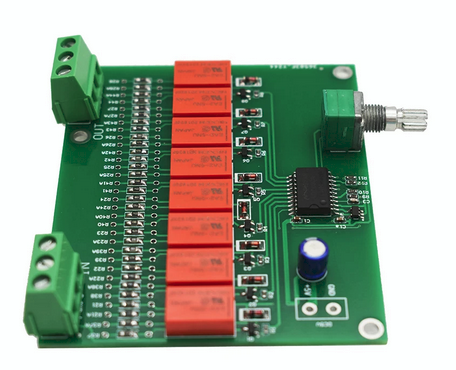
Relay Switched Resistor Networks (R2R) = the ultimate form of volume control, here’s a technical writing on them. There are various ways to implement this, but you get perfect channel matching as with stepped attenuators, but this is a much more scalable design. Most designs have anywhere from 128 to over 200 volume steps! As with stepped attenuators, the quality of resistors matters. These days, this is becoming a popular volume control solution, but only in newer consumer gear, not the pro audio industry which generally uses digital.
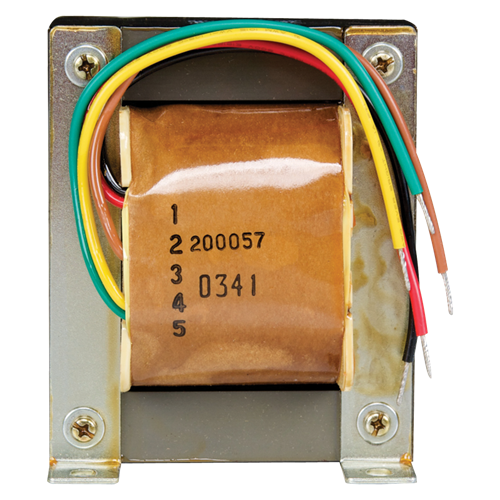
Transformer/Autoformer = debunked above. These offer a fair amount of steps, but never as many as relay switched R2R let alone a potentiometer, and they ruin performance by adding lots of noise, and distortion to the audio signal. They also add weight and huge costs, so my question is why? The answer is: audiophiles like to spend money on cool looking boutique stuff. Wait until more audiophiles discover Accuphase’s AAVA volume control… let’s just pretend that one doesn’t exist.
Recommended Preamplifiers: I only recommend preamps that fit into the “State of the Art” criteria on the above amplifier performance chart, because you don’t want your preamp being the bottleneck here as the power amp is already not going to fit into the “State of the Art” category unless it’s a Topping LA90/LA90 Discrete.
- JDS Labs El Amp II+ – if you just need a single ended preamp, get this for $250. Too bad balanced is against their ideology, because the industry desperately needs a balanced alternative to the options below, from a company like JDS Labs with excellent customer support.
- Topping L70 – $350 balanced preamp that can convert SE to balanced and vice versa, uses relay switched R2R volume control, two gain options, includes a top of the line balanced headphone amp, and comes with a remote. What a bargain! It also has a shockingly low output impedance of 20 ohm single ended and 40 ohm balanced – the lower the better. Schiit’s best preamp on the contrary has 75 ohm SE and 600 ohm balanced, while the most expensive solid state preamps I know of from Pass Labs, Gryphon and Accuphase of course don’t even give you this spec. This is an end game preamp and headphone amp; it’s not rational to spend more than this just for more performance since it is impossible to have a better (more transparent) sounding preamp than this to human ears. Not to mention, the only better performers on paper are the Topping A70 Pro, Topping Pre90, and Benchmark LA4.
- Topping A70 Pro + Ext90 – this is a two device combo for $750. Only get this if you need more inputs than what the L70 allows.
- Schiit Kara – $700 balanced preamp that can convert SE to balanced and vice versa, also uses relay switched R2R volume control but in the form of a log pot with 128 steps. Comes with a nice aluminium remote. Can be used a as a passive preamp (prone to impedance matching issues), low gain preamp (they cite 0 dB but it’s likely closer to 6 dB), and higher 12 dB gain. Note that this is worse than all of the above recommended preamps and it is susceptible to audible channel imbalance (luck of the draw). I am only listing this here as a recommendation for anyone who doesn’t want to deal with Topping and possibly returning a defective product to China, not that Schiit’s customer service reputation is any better. But this guarantee is a tough pill to swallow for literally twice the price of the superior, and relatively tiny, Topping L70.
Yup, those are the only preamplifiers I can honestly recommend. Spending more money than this is just getting you more color, not more accuracy (usually less accuracy in fact). Except for the Benchmark LA4 which is king, but the performance is truly negligible – far beyond the threshold of human hearing and just insignificant. Also, with the LA4/HPA4 you’re stuck with only 2 analog inputs (SE and balanced each), while the Topping A70 Pro + Ext90 combo for $750 gets you 4 pairs of balanced inputs and 2 pairs of SE.
But these Topping and even the Schiit and JDS Labs preamps objectively perform far better than all the uber expensive stuff from the Pass Labs, Gryphons, Accuphases, Audio Notes, Luxmans, Mcintoshes, Krells of the world. The same measurements and most of the same specs discussed above in the amplifier section also applies to preamplifiers. You want your preamp to measure as good as possible, because you want it to be transparent and not the bottleneck of your system.
And yes, even Schiit’s Freya+, while better than any all-tube preamp and almost certainly the best tube premap ever made (it only uses a tube gain stage), performs significantly worse than all of the above, worst of all in tube gain mode. Here’s its official performance report from Schiit. Skip the passive performance. Even in buffer mode, it performs worse than the Kara, which performs worse than the Topping L70 at half the price.
Recommended Headphone Amplifiers
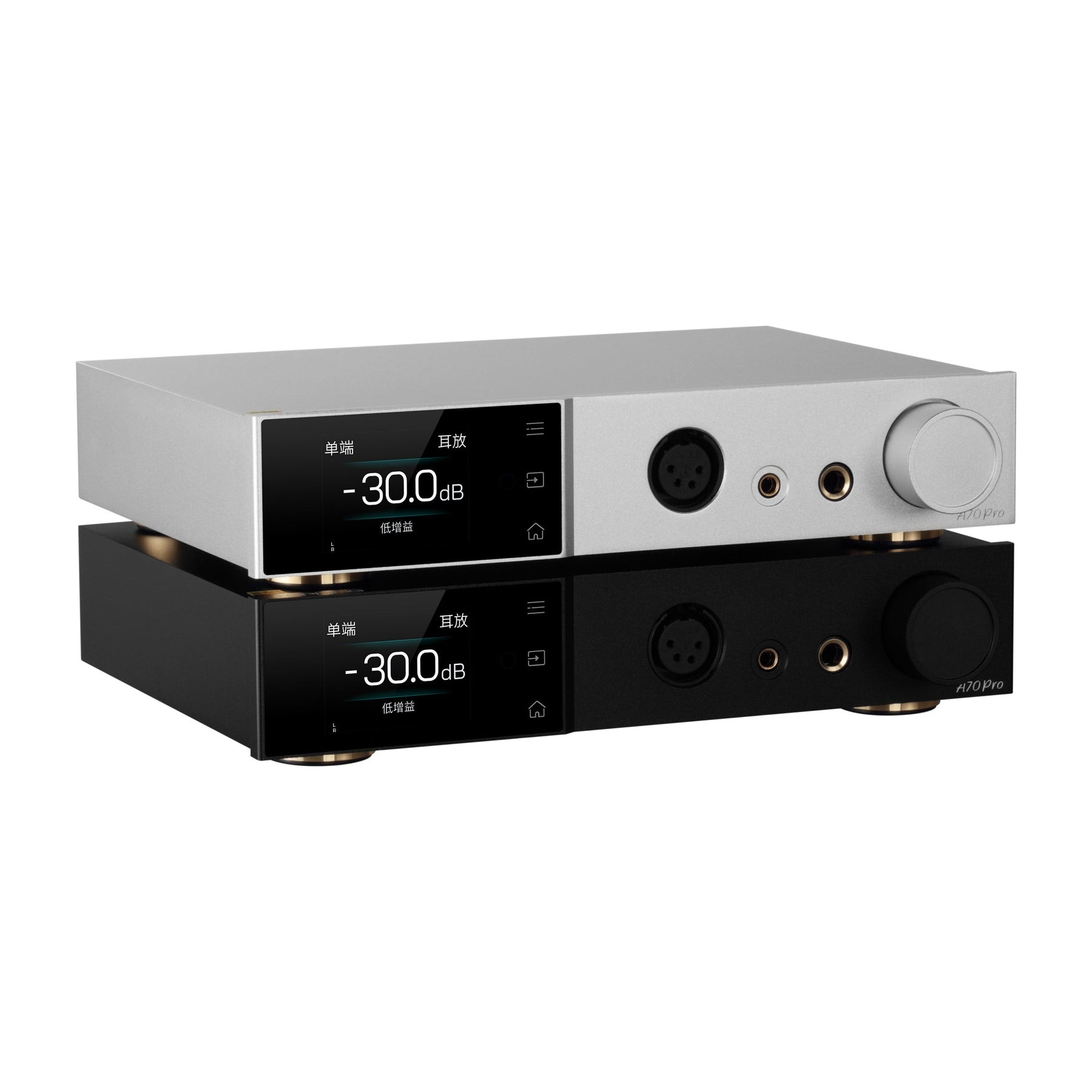
As with power amplifiers, preamplifiers, and every other category of hi-fi products, the vast majority of what’s out there is both badly designed and obsolete.
I used to also believe some of the audiophile stuff was good like Kevin Gilmore designed amps, Pass Labs, etc. I used my ears to judge, and never tested the actual good stuff, so I ended up favoring the sound of the less-bad audiophoolery like these. R2R DACs and tube gear always sounded immediately bad to me due to distortion and noise, and designers like Gilmore and Pass had credentials backing them. But their designs stopped evolving in the 2000s, which is why now in the 2020s they’ve been greatly surpassed in much lower cost stuff. This is how technology always progresses.
Recommended Headphone Amplifiers:
I can’t recommend any but these. Which one you need depends on your power needs and whether or not you need a DAC built in. Reminder that all of these headphone amplifiers will sound the same and indistinguishable in proper blind testing, for headphones they’re all capable of driving. Very power hungry headphones will sound best on the more powerful amplifiers.
- JDS Labs Atom Amp 2 – $130 and measures flawlessly. No amp will sound better than this, aside from the amps recommended below being more powerful and the final 3 recommendations provide guaranteed perfect channel matching with their R2R volume control. Get this if you’re on a tight budget and don’t want to deal with Chinese made Topping/SMSL products more prone to failure which then have to be returned to China. If you’re willing to take that risk, get the amplifier just below instead.
- Topping L30 II – the best measured amplifier ever and it’s only $150! Surpasses the JDS Labs Atom Amp 2 slightly and, most importantly, provides more power. Again, its downsides are: not the most powerful though powerful enough for almost all headphones, and it uses a potentiometer for volume control which, as with all of them except perhaps the Alps RK50 (unverified), has a low chance of audible channel imbalance (unit to unit variation).
- SMSL DL200 – $190 balanced DAC, top quality Sabre ES9039Q2M DAC (best 2-channel DAC chip in the world) and headphone amp all in one! The headphone amp isn’t nearly as powerful as any of the others here though.
- Topping A50 III – $200 SE/balanced amplifier rated for up to 3.5Wrms into 32 ohms and over 700mWrms into 300 ohms. Flawless performer, just the usual China product disclaimer.
- Schiit Midgard – $220 headphone amplifier, get this only if you don’t want to trust the Chinese made Topping/SMSL products and possibly deal with returning a defective item to China. Because otherwise, the Topping L30 II and A50 III especially are better values. The Midgard is a tiny bit more powerful than the L30 II (negligible), not as powerful as the A50 III, and much weaker than the ones below (will only matter with select few headphones in existence), and only uses a potentiometer for volume control so channel matching isn’t perfect but audible issues will be extremely rare. Also, their customer support reputation is no better than Topping’s (possibly worse), though if you are allowed a return, you can at least return it to the US rather than China. Note: this has XLR output but it is NOT balanced.
- Topping L70 – $350, fully balanced, relay switched attenuator volume control (perfect channel matching unlike anything else in this price range from any brand besides Topping and SMSL), and has all the performance you need. This is the best price/performance headphone amp and preamp in existence, and overall the 2nd best headphone amp in existence, bested only by the final recommendation in this list. Minimal gains spending beyond this, just even more power. Its measured performance annihilates almost all >$2k amps, and it edges out the $630 SMSL SP400, which is basically twice the $3,500 Benchmark HPA4 but for $630 (both are THX-888 amps with relay switched R2R volume control and the same measurements, but the SP400 is balanced with twice the power in balanced mode). Compared to the similarly priced SMSL SH-9 (which is basically half of the SMSL SP400 and a Chinese made $3,500 Benchmark HPA4 for $290) and Topping A30 Pro (they need to stop competing with themselves), the L70 has much more power largely because it’s balanced (hardly anyone will need this power though), preamp functionality, and most importantly perfect channel matching with its volume control since the A30 Pro only uses a potentiometer.
- SMSL DO400 – $500 for a top tier balanced DAC (using the latest and greatest ESS Sabre ES9039MSPRO chip) and headphone amp. The only thing it’s missing is relay switched R2R analog volume control, it uses digital volume control instead. It is not as good/powerful of a headphone amp as the Topping L70 or A70 Pro though, but still a world class amplifier with tons of power on tap (rated for 3Wpc RMS into 32 ohm). This is better than both the FiiO K9 and K9 Pro – more powerful amplifier that certainly performs in the same league otherwise, and a marginally better DAC.
- Topping A70 Pro – $500 and balanced. This one is also a top tier preamp. Despite the name, this is actually newer, better, and more powerful than the A90 and A90 Discrete. In fact, this is the best high power headphone amp in the world, bar none. It’s also one of the most powerful headphone amps, not just in output power RMS but also output voltage RMS and peak to peak output voltage.
Yup, the Topping A70 Pro is the end of the road. It’s objectively on a much higher technical performance level than every other headphone amplifier in existence, except for the Topping L70 which is the next best thing. Note: the A70 Pro does have a history of reliability issues. Topping claims the latest firmware fixes this, and user feedback seems to support this (no data to back this up though, purely anecdotal), but it’s up to you to trust this or not. The L70 doesn’t seem to have this reputation, but it also has a much smaller user base – I think most people considering the L70 probably just went for the A70 Pro instead.
Only the lower end JDS Labs amplifier (Atom Amp 2) and Schiit’s second “lowest end” solid state amplifier (Midgard, actually their best headphone amp) are recommended from those brands for good reason. The JDS Labs El Amp II+ isn’t really any better than the Atom Amp 2 – even the power output difference is minimal with the boost option. The Schiit Midgard offers way more power for less money, and the Topping L30 II is also more potent than the El Amp II+ (almost the same power as the Midgard for $70 less).
As for Schiit, thanks to them being transparent enough to provide their Audio Precision analyzer reports for most of their products, the data shows that the Midgard is clearly their best headphone amplifier. It handily outperforms the $600 Lyr+ and $1,200 Mjolnir 3 in all modes, in every metric except for crosstalk and power output where the $600 Lyr+ is their best followed closely by the Midgard, while their $1,200 balanced Mjolnir 3 loses!
The Midgard is Schiit’s headphone amp SINAD king (and thus SNR and dynamic range king), the Mjolnir 3 shockingly has a nonlinear frequency response with sub-bass rolloff below 50 Hz! Very minor though, peaking at under a quarter of a decibel (inaudible), but still. The Midgard has a considerably lower noise floor than both the Lyr+ and Mjolnir 3, as well as lower THD – the most expensive Mjolnir 3 is last place in both! The Lyr+ has shockingly high levels of intermodulation distortion (more significant than total harmonic distortion), and once again the Midgard is their best here. The Mjolnir 3 does have the best crosstalk at just under -90 dB, versus just under -70 dB for the other two but this is inaudible. The Lyr+ has shockingly bad performance when outputting low voltage (under 10 mV), but their $1,200 Mjolnir 3 is the weakest amp of the bunch! Note that the Lyr+ was measured on both solid state and tube mode, which makes little difference since the tube is just in the gain stage.
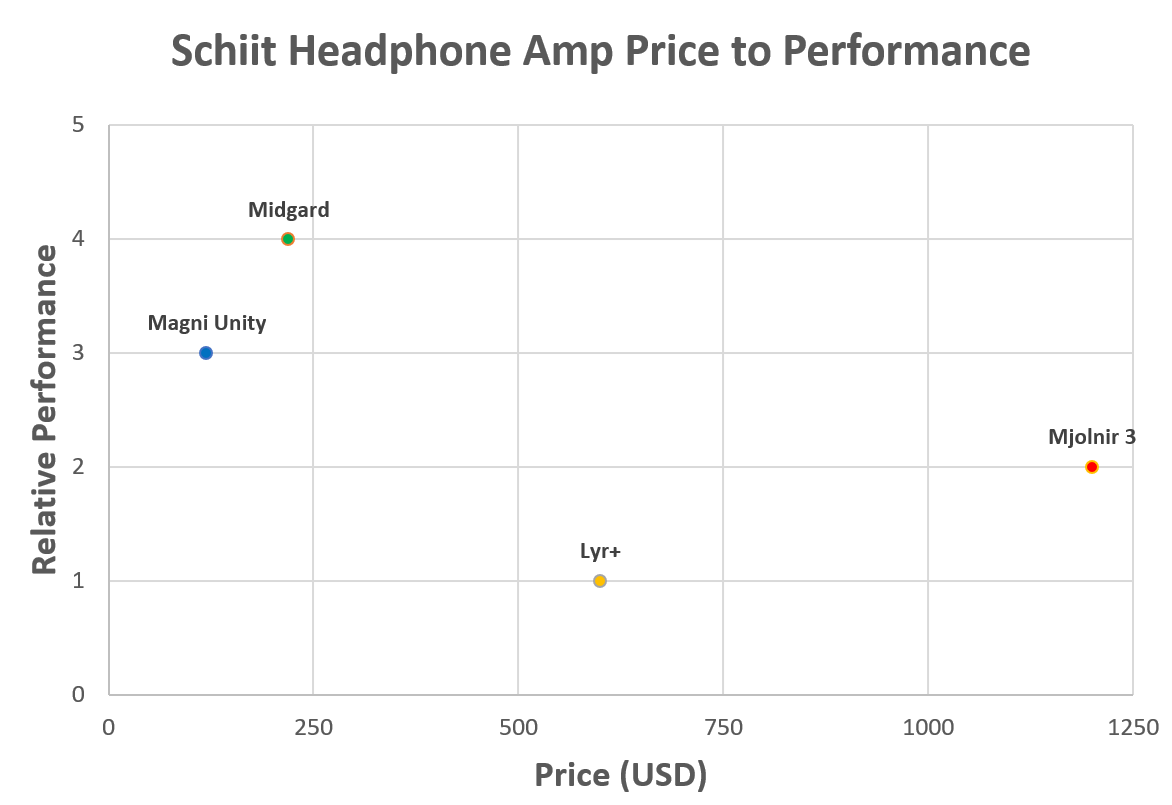
Note that I excluded the Schiit Vali above but I probably shouldn’t have. It was excluded for being completely useless. It is their worst amp by far and it’s an output transformerless (OTL) amp, which are really useless devices for driving transducers. Also, I forgot to manually set the Y axis to max out at 4 since there are only 4 products there, but you get the picture. This same pattern manifests for their DACs, as you’ll see later. With Schiit, their best researched, best designed products are the lower cost ones, while the higher cost ones are audiophile snake oil products.
Schiit is very wise: they cater to both the objective crowd who just want a no nonsense top performing product, and the audiophool crowd. JDS Labs only caters to the objective crowd. Topping and SMSL are actually starting to cater to both; Topping’s latest D90 III Sabre DAC isn’t really any better than their D70 Pro Sabre, despite the use of a second DAC chip and parallel circuit (this only nets a few dB of SINAD and nothing else, and the D70 Pro Sabre’s SINAD is already at least 40 dB above audibility), but at least they did try to push the envelope with it, at an audiophile approved $900 price tag.
SMSL is actually venturing into audiophool territory: not with the SU-X DAC and SH-X headphone amp, which are akin to the Topping D90 III Sabre DAC, but rather their “flagship” VMV series products which, just like the more expensive Schiit products, perform WORSE and cost more. Though unlike Schiit, these SMSL VMV units look completely different than everything else in their lineup – the looks are designed to appeal to audiophiles, whereas all of Schiit’s schiit looks the same.
But hey, if this is the future of consumer audio electronics, I’m fine with it: the best products for lower costs, worse products for higher costs.
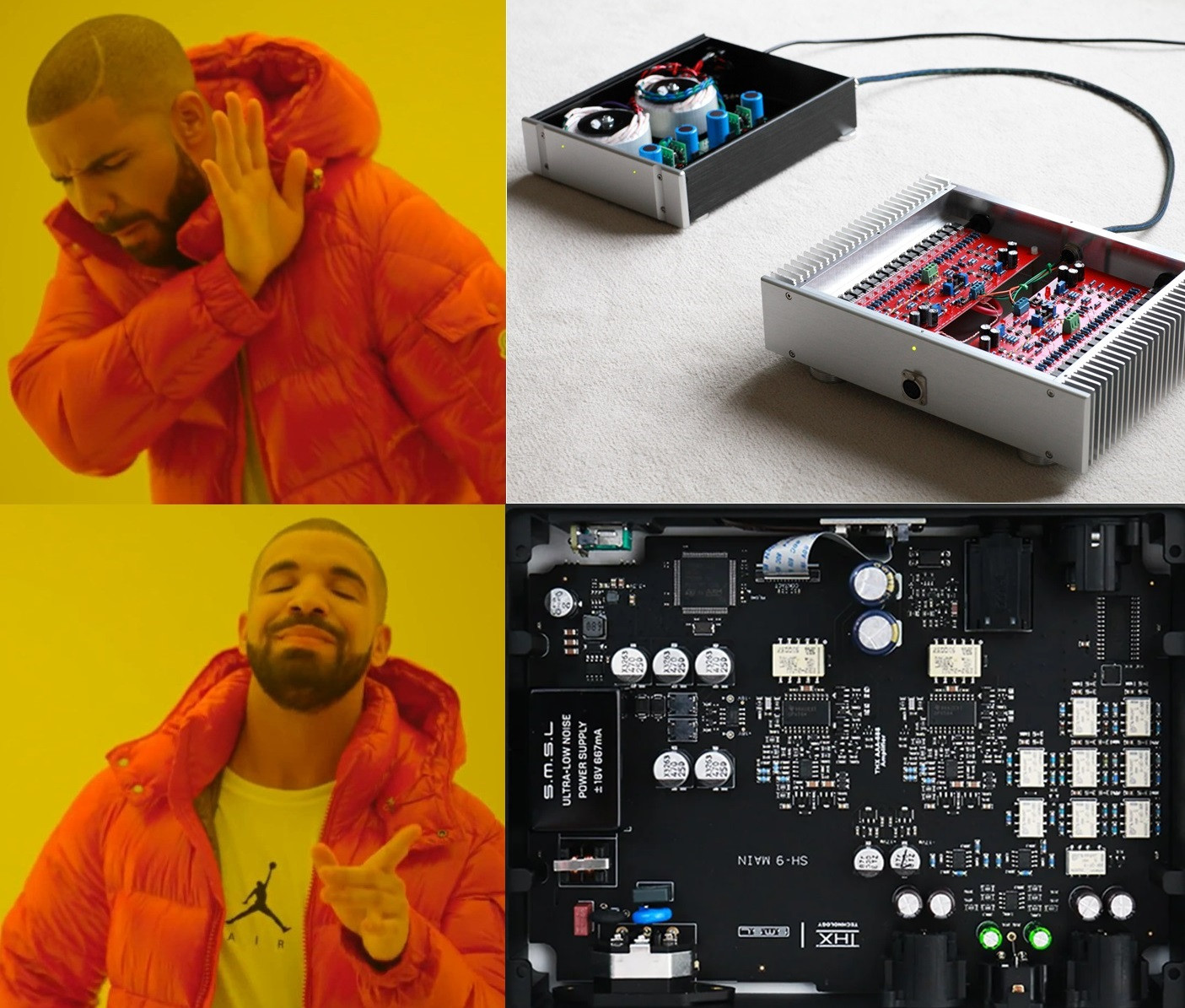
Again, the vast majority of this industry consists of outdated designs with audibly insufficient SNR and/or dynamic range. Topping, SMSL, JDS Labs, Geshelli Labs, and now the affordable Schiit products are among the most research, data driven designers, and cost effective as well. Sorry, no recommendations for fancy looking tube gear from brands like Jadis, VTL, Line Magnetic, Manley Labs. You’re paying more for looks and audibly worse performance.
The same goes for the big price tag solid state amp brands, whether you’re buying expensive Chifi like Audio-GD or Holo Audio (both of which are not just overpriced but also poor performing), or American like HeadAmp (I’ve had the GS-X Mini) or the expensive Schiits, or European like Lake People/Violectric. All of these are proven to be objectively worse than the above recommendations, for way more money.
And no, you’ll never need more power out of a headphone amp than what the Topping A70 Pro provides. It provides enough power to blow up most headphones (protection circuits prevent this thankfully). ASR measured over 8W into 33 ohm and 1W into 300 ohm. It’s way more than powerful enough for the HiFiMan HE-6 family and SUSvara (their power requirements are way overblown at 83 dB/mW with low constant impedance – not hard to drive). It’s even powerful enough for the ridiculous Modhouse Tungsten (150 ohm and 76-78 dB/mW just isn’t an ideal design), which has no credible reviews so I can’t recommend that headphone anyway.
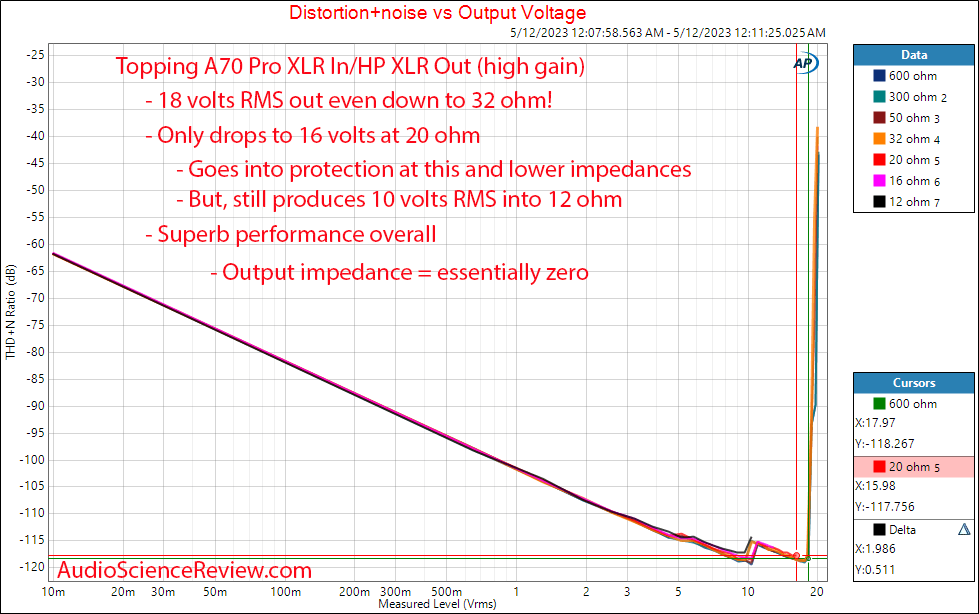
Moreover, the A70 Pro’s ability to maintain high output voltage from 600 ohm down to 16 ohm, as shown above in ASR’s review, is hard to find elsewhere. So not only do you not need more power than what the A70 Pro provides, but good luck finding a more powerful headphone amp for sale anywhere.
Recommended Electrostatic Headphone Amps: None. All of them use very outdated designs and can’t perform to modern standards, despite their immense cost. They are worse amplifiers than the $100 Objective2. The iFi iESL and Topping EHA5 are newer, but still have enough problems for me to not recommend them.
To illustrate how far headphone amplifiers have come, let’s compare the best from today (Topping A70 Pro) to the best from the 2000s (AMB Laboratories Balanced Beta22). If you want to compare to the best of the 2010s, that’ll be the aforementioned Benchmark HPA4 – compare their reviews here and here. As mentioned earlier, the A70 Pro is smaller, more than twice as powerful, measures a tiny bit better in every metric except crosstalk and channel balance (this one is tied), and is 1/7 the price.
But the 2000s is where just about all the most popular 4+ figure price tag headphone amplifier design is at. Or earlier, in the case of tube amps. The Beta22’s specs can be found here, and the A70 Pro’s here. The thing that immediately stands out is that the A70 Pro is considerably more powerful, despite being so much smaller. Let’s look at the AMB Beta22 in this configuration:

And now the Topping A70 Pro below:
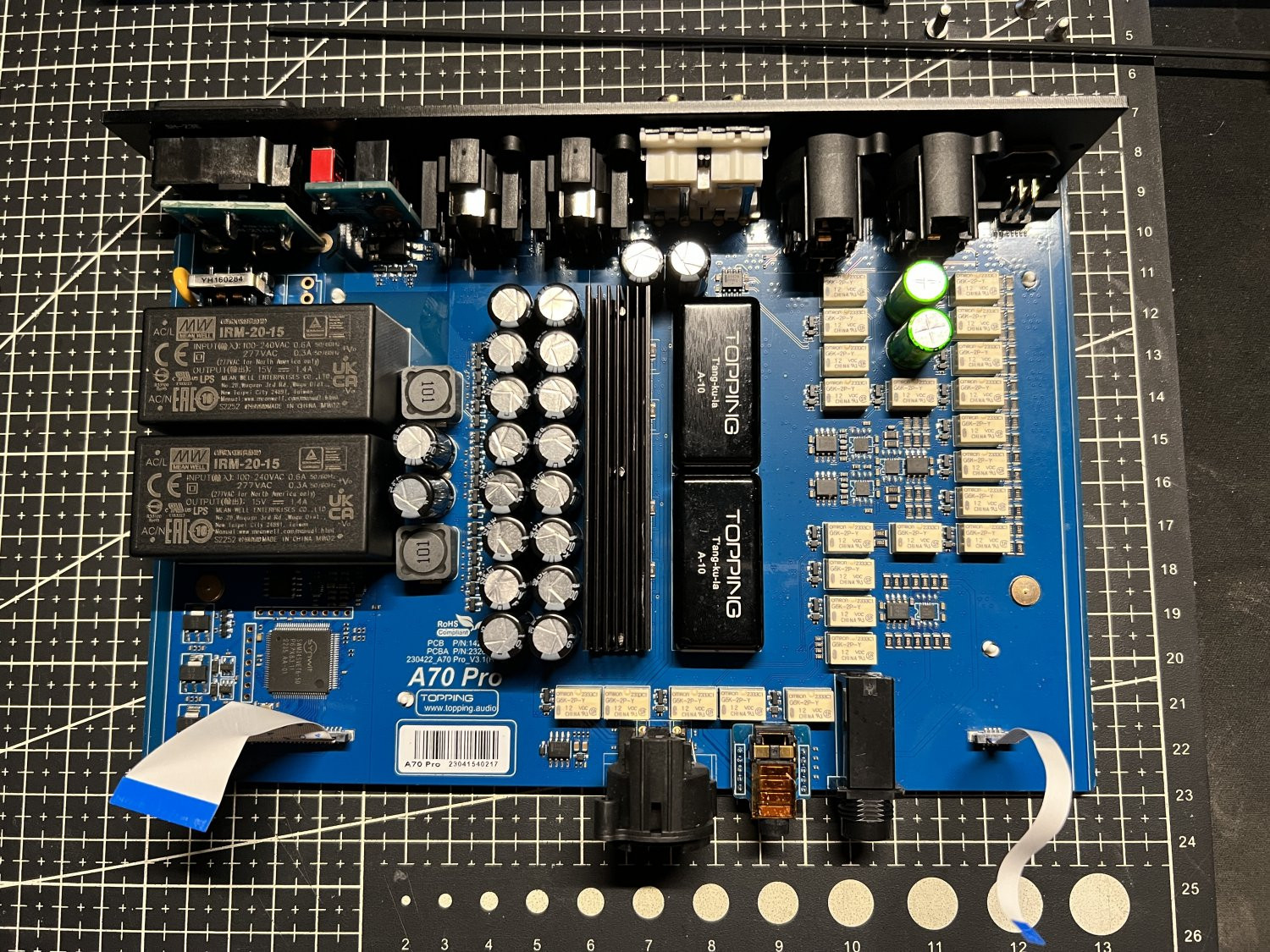
The images don’t maintain scale, but you can see the Beta22 is in two separate chassis: one for its linear power supply with its massive power transformer, and one for the huge discrete amplifiers and their big heatsinks. And that Beta22 is driving speakers, hence the speaker terminals and lack of volume control. You can fit the entire Topping A70 Pro unit, fully assembled, inside just the power supply chassis for the Beta22.
The A70 Pro on the other hand has everything on a single PCB, yet has significantly better crosstalk measurements. I believe its input and gain stages are on the right side, near all the relays which is also where the 200+ step relay switched R2R volume control is. Its output stages are under those black Topping branded boxes, labeled T’ang-ku-la. Its two power supplies are those encapsulated MEAN WELL units on the left. Those little switch mode power supplies are just over $10 a piece at the time of this writing. So this little amplifier with those two little $10 low power power supplies is much more powerful than that big Beta22.
To those of you who were never audiophiles, this might not surprise you since you’re aware that technology improves and shrinks over time. You know that your smartphone has more computing power than what originally took people to the moon. Audiophiles forget this.
AMB Laboratories was kind enough to provide measurements for the Beta22, because once upon a time this was the best headphone amplifier in the world and a damn good power amplifier for efficient speakers. Here are the 33 ohm measurements, and here are the 300 ohm. Conveniently, the Topping A70 Pro was also reviewed with the same impedance dummy loads, with its review being linked just above.
The Beta22 has a perfectly flat frequency response – that’s the most important thing along with power. The noise levels are significantly higher despite its linear power supply, compared to the Topping with its $20 worth of SMPS. The total harmonic distortion and intermodulation distortion are not on the same order of magnitude, in favor of the Topping. The Beta22 measured -84 to -85 dB crosstalk at 1 KHz, while the Topping was measured at -123 dB to -133 dB depending on whether you’re using it balanced or not – so the Topping wins by a wide margin there (this is inaudible though).
The Beta22 mostly competed with Kevin Gilmore designed amps – most of all the “Dynamite” which is like the HeadAmp GS-X MkII on steroids. The CFA3 is Gilmore’s latest amp; a 2010s amp but with 2000s design philosophy still. Those were the best of the 2000s, but the best of the 2020s is objectively lightyears ahead in every metric, at a small fraction of the price.
Recommended DACs

DACs are another flavor of the week subject in the audiophile community, like headphone amplifiers. But here we will recommend things that are tried and true. First of all, as with amplifiers, all DACs recommended in this article sound identical to us because they all perform beyond the point of audibility. The only exception might be if you blind tested two DACs with very different filter settings enabled.
The job of a DAC is simple – accurately convert a digital audio signal to analog by implementing a very accurate (sharp) reconstruction filter with proper attenuation, and having low enough noise and distortion to be fully transparent for at least 16-bit audio signals (96 dB) – considering the $80 SMSL SU-1 greatly exceeds 96 dB SINAD and dynamic range plus more than 16 bits of distortion free range, and has a good digital filter and excels in all other metrics, we should keep that in mind as a standard.
Here’s a video overview of measured DAC performance. This is a must-watch for anyone in this hobby, or better yet, read the research paper it’s presenting – it is one of the best resources for understanding what comprises a DAC’s performance. Also read this to get a better understanding. Ultimately the most important measurements for a DAC are reconstruction/digital filter accuracy and attenuation, linearity, and of course frequency response. Jitter is usually only an issue in filterless DACs these days which inherently perform terribly. These are the main things we hear with DACs. SINAD and multitone are still important, but no need to obsess over them.
For a deep discussion about audibility thresholds of these measurements, read this.
So once again, you want your DAC to perform/measure as best as possible, so that it’s transparent and not a bottleneck in your system. The same with amplifiers and preamplifiers: you don’t want any of these to be incapable of resolving standard 16-bit audio, or altering your frequency response. For speakers, your frequency response is already being butchered by your room, unless you’re in an anechoic chamber. In any case, it’s best to have your entire audio system produce a flat frequency response, and if you want to make adjustments from there, make them via parametric (or dynamic) equalization because then you’re in charge of your tonality. And for this to be effective and have no consequences, you need your entire audio chain to produce inaudible levels of distortion, and it needs to measure as flat as possible by default, so that your EQ adjustments aren’t so severe that they create audible distortion.
Amir’s ratings in the video above and on his website (Audio Science Review) cater a bit towards human hearing – for example, 80 dB SINAD isn’t really a big deal. But considering the prices of truly excellent DAC, I’m more strict with my recommendations throughout this article. Unless you’re spending under $100 on audio electronics, then I consider less than 96 dB SINAD and dynamic range (not A-weighted) and under 16-bits of distortion-free range to be unacceptable, since you can readily surpass this level of performance from an $80 DAC, $120 headphone amp, and in a $150 power amp!
There are a few different DAC design philosophies, and only one is valid. The invalid ones are: resistor ladder (R2R), non-oversampling, no digital filters. Any of these cannot come close to accurately reproducing 16-bit audio (they struggle with 10-bits), and cannot come close in any performance metric to the $80 SMSL SU-1. The above video, the research paper it’s presenting, and the reviews from that site (described early in this article) prove this.
This simple fact is why R2R will never be present in the pro-world, it’s simply not good enough. You can achieve technically better results from Delta Sigma conversion with oversampling and digital filters, the only valid DAC design philosophy, for far less money and circuit complexity.
Oversampling is objectively a must for the best quality audio. Most DACs are oversampling but use the DAC chips’ built in optimized oversampling. There are technically higher quality oversampling algorithms that require more computing power (beyond what a Ryzen 9 can handle even), but you can test this with HQPlayer or an offline equivalent, but this makes no measurable difference to equipment far more sensitive than our ears.
Digital filters are one of the most important features of a DAC as they can make or break performance. DACs also need to have accurate attenuation so as to not ruin the frequency response you end up hearing, or worse. If you want to see what a poor digital filter does to performance, look at the Mytek Brooklyn Bridge II review on ASR. This for me was the highlight.
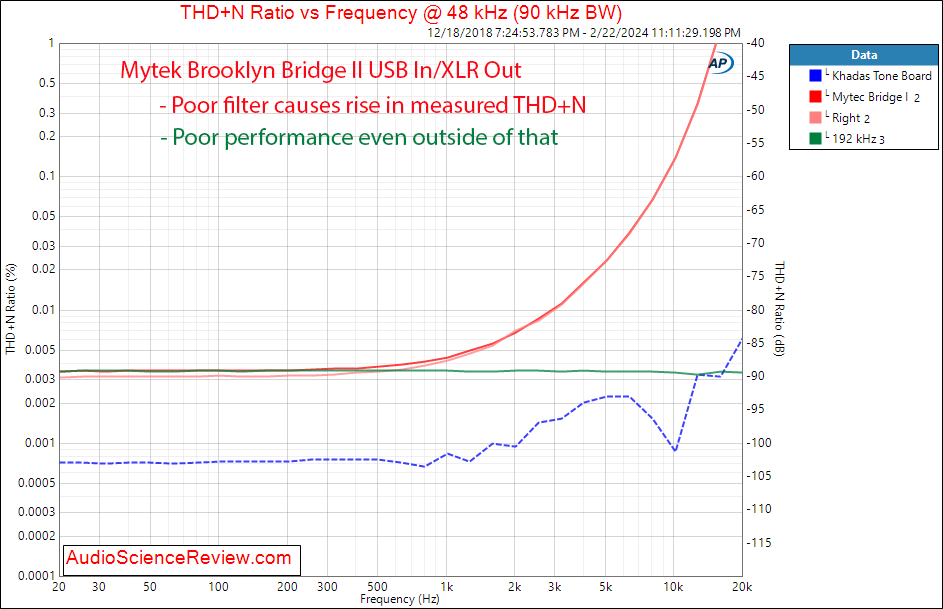
Recommended DACs by Price:
- SMSL SU-1 ($80) – at just $80, this DAC is already performing beyond the limitations of human hearing. If you properly blind test this DAC vs everything else recommended below, you won’t be able to identify any of them reliably. Paying more than this isn’t paying for more performance, it’s paying for more features or performance that’s only better on paper or to measurement devices, not to any human being. For some reason this doesn’t have a product page, but you can buy it from Apos or Shenzhenaudio.
- JDS Labs Atom DAC 2 ($130) – if you want end game performance from something not Chinese, and don’t need balanced outputs, then this is your answer
- SMSL DL200 ($190) – balanced DAC using the latest ESS Sabre ES9039Q2M, and it also includes a headphone amp so the value is incredible
- miniDSP 2×4 HD ($225) – as a DAC this performs considerably worse than everything here, but not to the point of these differences ever being audible. This gets a recommendation for its DSP and 4 analog outputs, allowing for subwoofer integration. So if you’re running speakers + subwoofer, get one of the miniDSP recommendations in this list.
- Schiit Modius E ($230) – balanced DAC that’s not as perfect measuring as those from SMSL, Topping, and JDS Labs, but the performance differences are inaudible. Only get this if not using subwoofers (if so, get the miniDSP 2×4 HD), you need AES input, and if you don’t want a Chinese product in the event it fails and has to be sent to China to be serviced, not that Schiit customer service is any better. If you don’t need AES input, get the Geshelli Labs DAC below. Being American (like JDS Labs) means it can be serviced in America plus it has a longer warranty (but a return period of half as long). So if you want a non-Chinese single ended DAC, get the JDS Labs Atom DAC 2. If you want a non-Chinese balanced DAC with AES input, get this. If you don’t care for AES input, get the DAC just below. If you want a DSP with subwoofer outputs, get the miniDSP 2×4 HD. If you’re okay with China made, then instead of the Modius E, get the SMSL DL200 above which is better and costs less.
- Geshelli Labs JNOG2 Socketed ($260+, starts at $310 with USB input) – Geshelli Labs is a fascinating brand: US based, customizable design, and this one is upgradable with opamp choices and even DAC chip! This is a balanced and single ended DAC, and like many other brands here, they provide objective performance data. You can order one to be wooden or aluminium. If you need a balanced DAC and have no plans to use a subwoofer and absolutely do not want a Chinese DAC, then your choices boil down to this versus the Schiit Modius E above. Schiit has a very poor reputation for customer service, but is more cost effective and has an AES/EBU input.
- SMSL SU-9n ($340) – end game balanced DAC. If you just need a top performing balanced DAC, there’s no actual benefit in spending more than this.
- miniDSP DDRC-24 ($400) – single ended DAC + DSP with Dirac Live digital room correction. It’s basically the above 2×4 HD + Dirac. So this is the best sub $500 DAC for use with a speaker system. Can add on their very nice UMIK-1 microphone for an extra $50.
- SMSL SU-9 Pro ($500) – balanced DAC using the ESS Sabre ES9039MPRO (the best measuring DAC chip in the world). Basically the same as the $800 SMSL D400ES and Topping D70 Pro Sabre except with fewer input options.
- SMSL DO400 ($500-620) – $500 for a top tier balanced DAC (using the latest and greatest ESS Sabre ES9039MSPRO chip) and headphone amp. The only thing it’s missing is relay switched R2R analog volume control, it uses digital volume control instead. It is not as good/powerful of a headphone amp as the Topping L70 or A70 Pro though, but still a world class amplifier with tons of power on tap (rated for 3Wpc RMS into 32 ohm). This is better than both the FiiO K9 and K9 Pro – more powerful amplifier that certainly performs in the same league otherwise, and a marginally better DAC.
- miniDSP FLEX ($495 SE, $570 balanced, plus $200 with Dirac Live, only recommended for speaker systems) – while this DAC technically performs worse than all of the above (besides the other miniDSP), this difference is inaudible. This gets a strong recommendation for its built-in DSP and Dirac Live functionality (for an extra $200) which is invaluable for speaker systems. This also gets you subwoofer integration.
- miniDSP SHD ($1,250, or either $1,300 or $1,445 with one of their mics, only recommended for speaker systems) – a good enough DAC even though worse than all of the above, but offers network streaming capability, DSP, Dirac Live digital room correction, and subwoofer integration.
Keep an eye out for deals on Topping stacks or SMSL stacks, like the Topping A70 Pro + D70 Pro Sabre. Not all of these are worthwhile – the SMSL DO400 has better value than most, at least at their normal prices.
I don’t recommend the $1,200 Topping DX9 DAC/headphone amp combo unit – while it’s a superb DAC and headphone amp, you can technically get better performance and way more power for a lower price out of a Topping A70 Pro + D70 Pro Sabre or SMSL D400ES stack.
Likewise, I don’t recommend the flagship Topping D90 III Sabre and SMSL SU-X DACs – the latter has reliability issues, and neither of these are really any better than the SU-9 Pro, DO400, and D70 Pro Sabre except for connectivity options. But if you want more connectivity, get the miniDSP SHD. SMSL’s “flagship” VMV products are actually worse than all their ESS Sabre chip DACs like those recommended above – they are arguably audiophool products, designed to look better and thus cost more but perform worse. The SU-X is their real flagship DAC.
Similarly, for home use I don’t recommend the RME DACs. They’re great both in performance and features, but their feature set is overall weaker than the miniDSP SHD which has equal DAC performance, also features PEQ, it’s a network streamer, and most of all has Dirac Live unlike RME. If you’re someone with Genelec smart monitors or Neumanns and don’t need Dirac, then you also don’t need the RME’s PEQ and can get a technically better performing Topping or SMSL DAC instead.
Gustard makes similarly great DACs to SMSL and Topping, but for way higher prices despite also being made in China. You’re paying more for nothing with Gustard, for the models without built-in streamers. Also they don’t seem to make any DACs using the Sabre ES9039PRO DAC yet, which is the best DAC chip in the world and takes priority in my recommendations above.
Higher end Schiit DACs aren’t recommended because they’re actually worse than the Modius E; they use far worse DAC ICs and they cater only to audiophools. Schiit even provides data that proves this. See: Yggdrasil report vs Modius E report. The $230 Modius E outperforms the far bigger and heavier Yggdrasil in every single metric, even in crosstalk and most of all the Modius E linearity is far better. The Yggdrasil is the world’s best R2R DAC by far, using four Texas Instruments DACs (again, this performs many times better than custom discrete R2R), yet it gets destroyed in every metric by the Modius E which is 1/10 the price, and gets destroyed by the $80 SMSL SU-1. Also, see the linearity of the $800 Bifrost 2/64, or rather the lack thereof! That is terrible performance.
Note that the Yggdrasil More is Better is excluded from the chart below because we don’t have a full Audio Precision Analyzer report, only a SINAD metric. It is Schiit’s SINAD king surprisingly (bested by most Topping and SMSL DACs and many Gustards), but I need to see the full report.
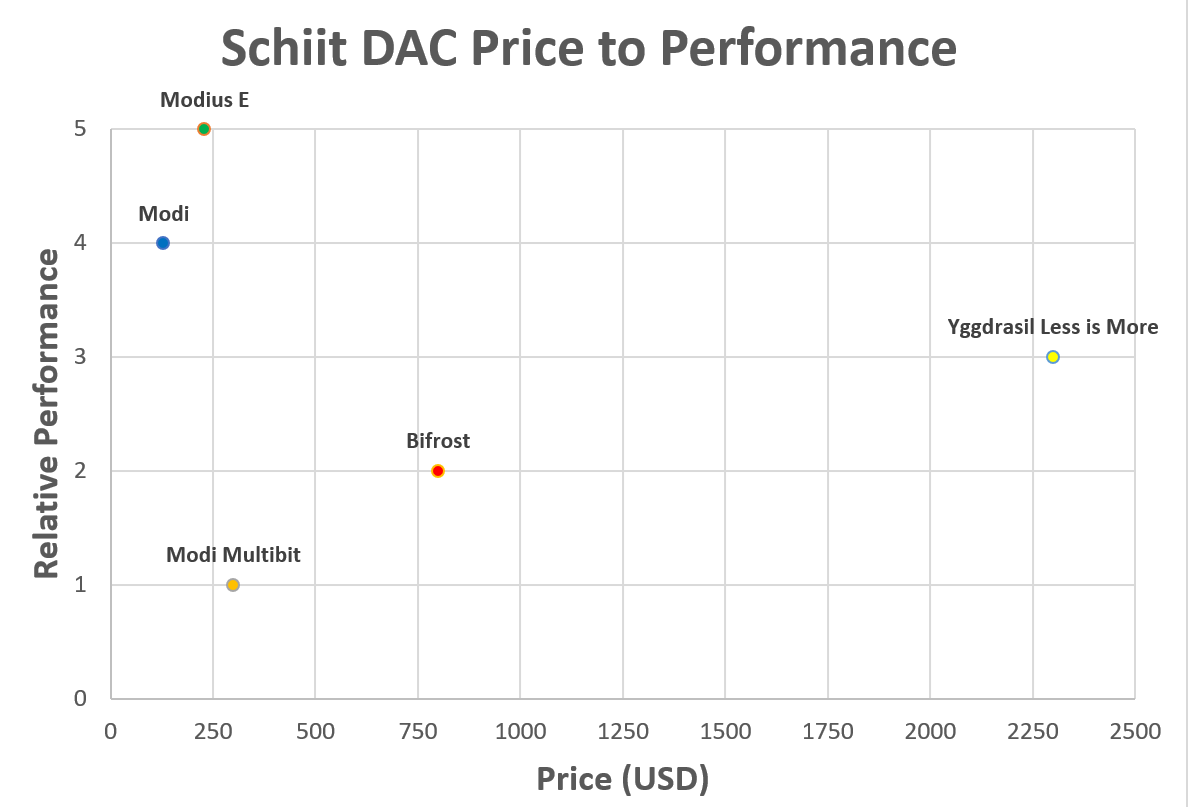
Notice how this is the same pattern as with Schiit’s headphone amps, except with one additional DAC. Their most inexpensive product is their second best, their second most inexpensive product is their best, their middle priced product is their worst.
The JDS Labs EL DAC II+ isn’t recommended only because of how much more expensive it is than the Modius E, combined with the inconvenience of no XLR outputs and no AES input.
“Audiophile” DACs and even pro audio DACs priced way above the SMSL SU-X and Topping D90 such as the Dangerous Convert-2 and Bricasti use outdated, worse (but still good) DAC chips – we’re talking 20 dB less dynamic range, or the difference in being able to resolve 18-bits vs 22-bits, both of which are at/above the threshold of human hearing anyway. So you’re paying more for worse overall performance. I’ve had both the Bricasti M1 SE and SMSL SU-X at the same time and my experience doesn’t disagree with those facts. Not only do the Topping and SMSL flagships outperform these audiophile/pro audio hybrid DACs, but so do lower end Topping, SMSL, Geshelli Labs, JDS Labs, and Schiit models under $200.
And the likes of Bricasti represent the better spectrum of the audiophile DACs – good but overpriced and dated. As mentioned earlier, R2R DACs are all the rage among audiophiles and none of those can even resolve 16-bits (many will struggle to resolve even 12-bits) – they are horribly inaccurate, low fidelity, distorted, and typically have blatant treble rolloff although their user base is generally too old to hear the worst of that.
Also note that R2R DACs aren’t the only bad high priced ones. Avoid anything that doesn’t use off the shelf DAC chips, except for portable use in which case the Chord Mojo 2 is justifiable. All the best performing and best value DACs though use off the shelf chips, typically from either ESS Tech’s Sabre lineup or from AKM, ROHM, Cirrus Logic, or Texas Instruments.

Network Streaming Player Recommendations
There are some very good DACs that double as network players. The purpose of such a device is to allow you to not have a computer in proximity to the audio system. A very niche use case, but one with its own market nonetheless.
- Allo Boss 2 (4GB + Nirvana SMPS for $231) – affordable and small, yet a top notch DAC with network streaming capability. If you actually want to use this as a streamer though, you’ll want a more potent wi-fi dongle.
- miniDSP SHD Studio ($900, or either $950 or $1,095 if you want one of their acoustic microphones and you definitely want such a mic) – this is a DAC and streamer with Dirac Live digital room correction. Dirac or an alternative is a must for any high fidelity speaker system.
- miniDSP SHD ($1,250, or either $1,300 or $1,445 with one of their mics) – weird that the plainly named SHD is the more expensive one, but that’s because this includes a very good built-in DAC. However, that DAC is no better overall than the $80 SMSL SU-1, and technically worse than the $130 JDS Labs Atom DAC 2 and $150 Topping E30 II. Are those differences audible? No, but the miniDSP SHD Studio plus one of those DACs costs less. Get the regular SHD if you want the convenience of having it all in one device, especially rack mounted.
That’s all for streamers, nothing else on the market makes sense to me as it’s mostly snake oil audiophoolery. Both of the miniDSP SHD options also have a small Linux based operating system called Volumio – they are dependent on a computer for setup, configuration, and Dirac Live, but for playing music they can be independent.
I didn’t know where else to stick this information, but if for whatever reason you need a pre-built power supply for something (e.g. some of the DACs above require 5v input), Allo has some proven good ones, namely the Nirvana SMPS. As discussed earlier in the article – there’s no benefit in spending more (triple) for a massive, inefficient LPS, especially since Allo provides the noise measurements for both and they’re about the same (absolutely zero audible difference).
Recommended Brands for Professional Audio Interfaces
This is for those working in sound production, but here are brands that consistently put out audio interfaces that have proven to measure well:
Portable Hi-Fi
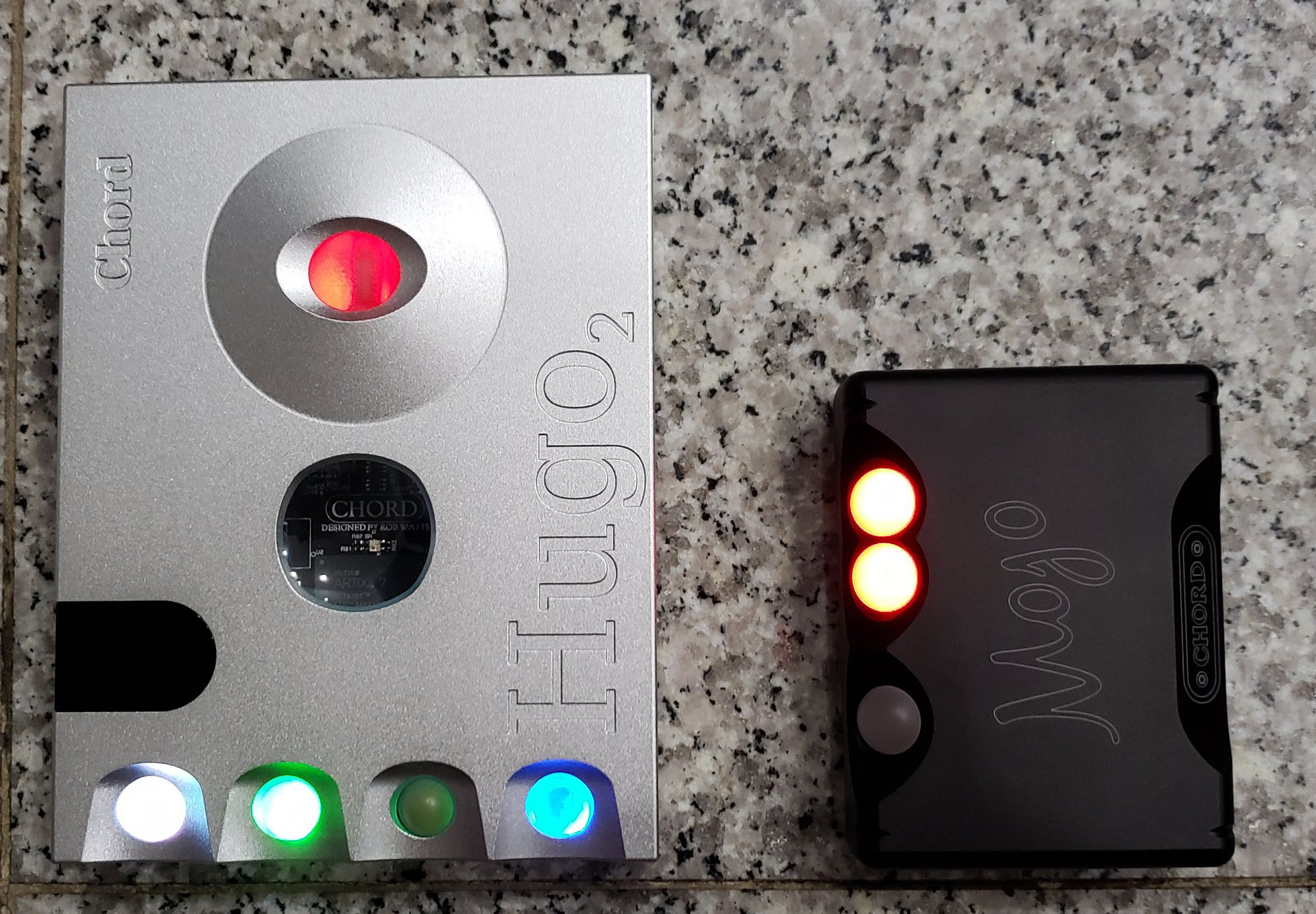
If you are looking for portable high fidelity music listening, especially now that phones don’t even have DACs built in, you’re in luck. We not only have portable DACs and headphone amplifiers, but we have some that rival the performance of elite desktop equivalents recommended above!
In addition to portable DACs+headphone amps, there’s a product called a DAP – Digital Audio Player. This is a modern day, high fidelity, standalone music player, containing its own computer and OS just like a smartphone, but the OS is tailor made for playing music. Unlike modern smartphones, they also include micro SD card storage. Most are not worth the money, due to how good the two recommended portable DACs+headphone amps are, but one does make the list below.
Recommended Portable DACs/Amps/DAPs:
- Topping G5 ($300) – this is the second best portable DAC+headphone amp, and should outperform every DAP except the one recommended below and perhaps the best Astell & Kern KANN series DAPs. There’s one caveat with this though: it has a reputation for questionable reliability. This reputation doesn’t even come from ChiFi haters, it’s on ASR as well. However, it does have overall good product reviews, so the issues must not affect most people? You have to decide.
- Fiio Q7 ($750) – the best portable DAC+headphone amp, it features an ESS Sabre ES9038PRO 4-channel DAC and a balanced THX-AAA 788 amplifier. This is an insane amount of performance packed into a small package! This far outperforms both the Chord Mojo 2 and Hugo 2, for only slightly more money than the Mojo 2 so I’ve taken Chord off of this recommendation list. Though the Mojo 2 does have the advantage of being tiny.
- FiiO M17 ($1,800) – my only DAP recommendation, as this is the best one in the world and the rest are either in the same price category as this, or they lose to the above. The M17 is basically a DAP version of the Q7, with a second ESS Sabre ES9038PRO and two parallel, summed 8-channel circuits, all feeding a balanced THX-AAA 788 amplifier once again. The Astell & Kern KANN Ultra costs slightly less and has a better DAC (ES9039PRO instead which has better IMD), but their headphone amp isn’t on the same level and A&K seems like they might employ those nasty “gentle slope” DAC reconstruction filters (unverified). So FiiO wins. But it is crazy how a second DAC chip and related circuitry, bigger screen, and beefier ARM-based internal computer results in this costing well over double the Q7, all due to demand.
Personally I’m waiting for a DAP or portable DAC+amp featuring 2x ESS Sabre ES9039PRO DACs plus a THX-AAA 888 amplifier instead (unless that’s not feasible in a portable device). Hopefully we see one soon.
Cable Myths
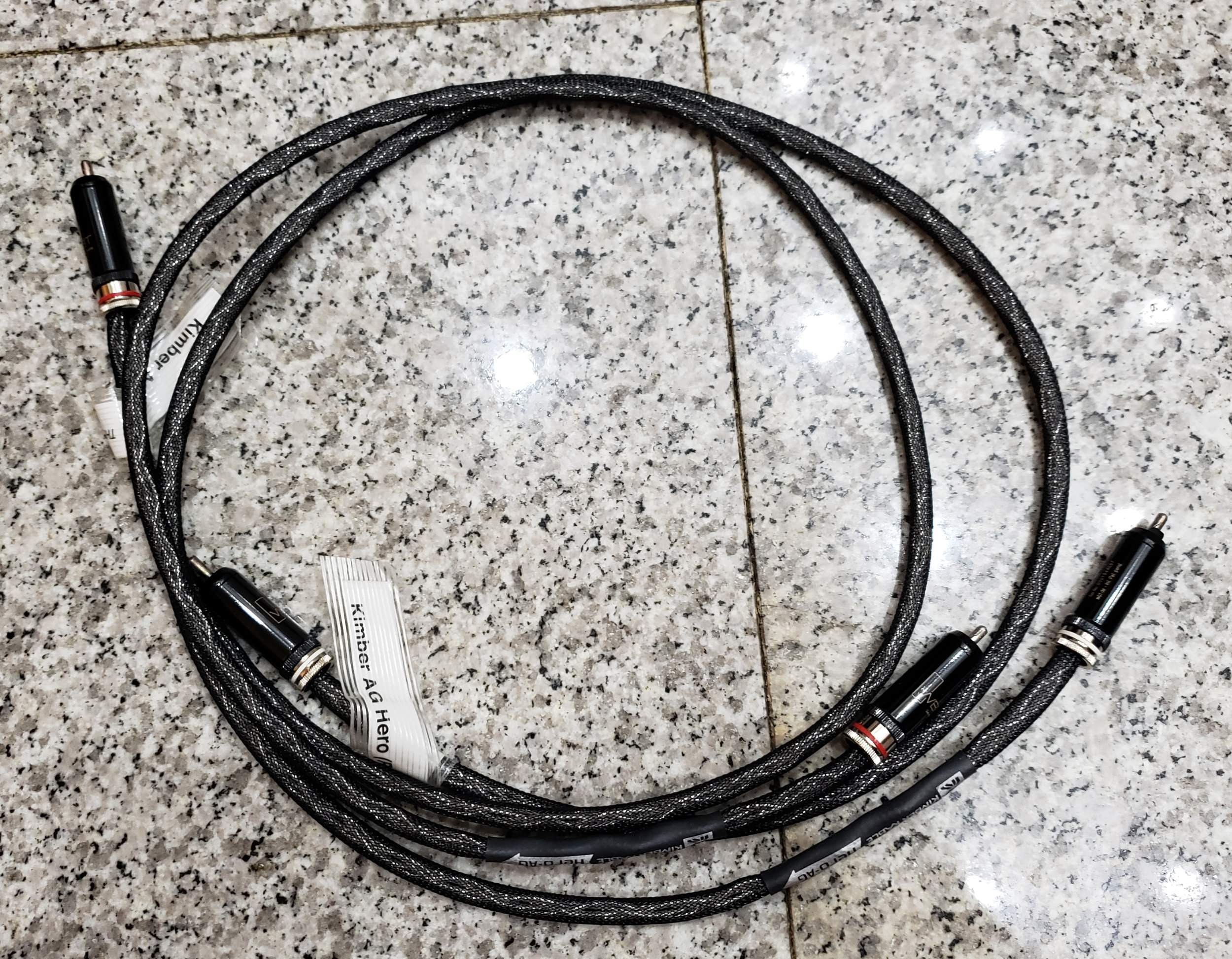
The snake oil gets particularly potent when it comes to cables. There are companies that tell you that power cables and digital cables (such as USB) costing hundreds, thousands, tens of thousands, and yes even hundreds of thousands of dollars, make a difference.
Obviously different power cables and digital cables won’t make any measurable difference at the output of your speakers/headphones! Nor do they make any difference in the measurable output of any component in the signal path. Not unless you have a digital cable unable to transmit the amount of data you need, or a power cable unable to meet your power requirements (which should result in a shutdown of the amplifier). I’ve also discovered recently that there are audiophools who believe the fuse in audio electronics affects sound quality. I don’t think these sorts of people can be reasoned with. If a measurable difference cannot be uncovered, then there’s no audible difference.
Analog cables however, such as interconnects, speaker cables, and to a lesser extent headphone cables, can make a measurable and audible difference. This mostly manifests in systems long cable runs where the noise rejection of balanced cables might make an audible difference, and when gauge starts to matter. Or when a cable is wired improperly, but that can affect all kinds of cables. Don’t buy cables from China.
Here’s a good rule of thumb for speaker cable gauges over distance. Source: Audioholics
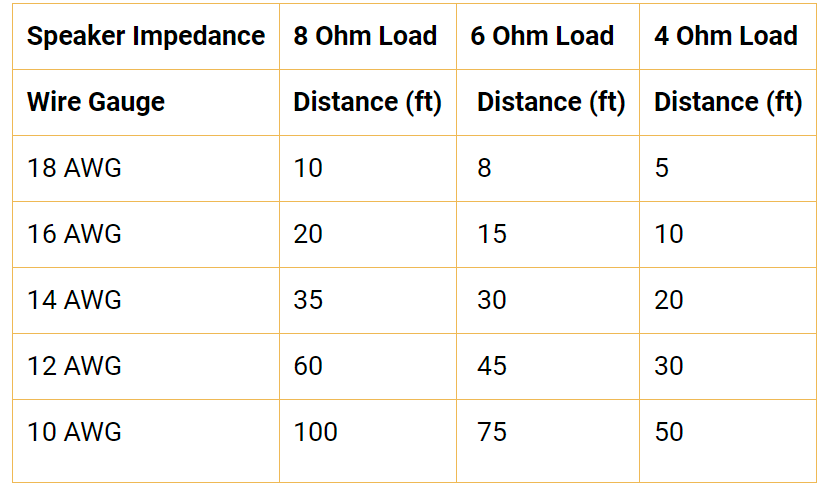
For analog cables, connector design matters more than whether your cables one brand’s copper over another or silver. Some connectors make better contact, most notably Neutrik’s speakON speaker connectors which measurably, but insignificantly, improves performance, as seen in ASR’s two reviews of the Benchmark AHB2.
For RCA cables, I do prefer those with Neutrik Profi connectors as it’s a better design with the grounds connected before the signals. This is a safety feature, but it’s more important than audiophile grade snake oil like all the cable marketing about the fanciest dielectric ever like Teflon vs PVC vs another material (this makes no measurable difference in audio applications), or grounding dongles that actually reduce performance (see ASR reviews of such cables from the likes of AudioQuest), or silver wire (less significant of a difference in the cable’s overall connectivity and performance than connectors), and/or silver solder (makes no difference).
As long as you avoid badly made cables, nothing else really matters unless your cables run through an extremely noisy environment, in which case you’ll want to be using balanced equipment with quad XLR cables. Audiophile snake oil land generally avoids mentioning quad vs twisted pair XLR cables, but when they do, it’s when they’re charging you hundreds or thousands for it, whereas you can get equally or better made pro audio quad XLR cables for less than $30 / meter. Quad XLR isn’t usually necessary, but considering the price increase is just a few dollars, you might as well go for it.
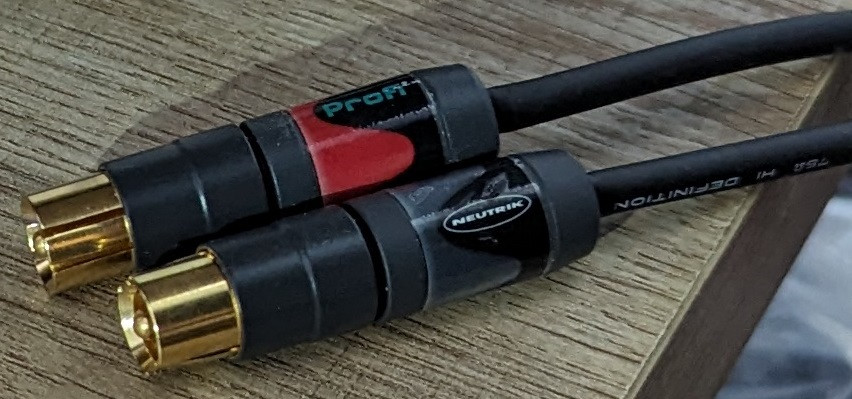
Analog Cable Recommendations:
- Mogami quad XLR with Neutrik connectors
- Mogami RCA with Neutrik Profi connectors
- Mogami speaker cable with Neutrik speakON connectors
- Canare StarQuad XLR with Neutrik connectors
- Canare RCA with Neutrik Profi connectors
- Canare speaker cable with Neutrik speakON connectors
- Gotham Cable StarQuad XLR with Neutrik connectors
- Gotham Cable RCA with Neutrik Profi connectors
- Gotham Cable speaker cable with Neutrik speakON connectors
These are some of the most commonly used analog cables in studios. They’re affordable and very well built, more tried and true than audiophool cables, don’t have any performance-reducing snake oil, and are generally offered with the latest and greatest connectors. So the theme continues here: super expensive audiophile cables are worse than affordable, purpose built studio/pro audio cable.
As for which brand to go for between Mogami, Canare, and Gotham Cable, this one is easy: go by region and price. Mogami and Canare are US based, so people in North America at least should probably go that route. Gotham Cable is German, so those in Europe at least should probably go for them.
These cables are sold at most pro audio stores. Some of them will custom build them for you, like Event Horizon Services. Another good source for these cables, for North American customers at least, is Benchmark. For those in Europe, boXem is a good source but always check local pro audio stores first wherever you are.
All these cables are actually better than the super expensive audiophile cables, which can actually reach 5-6 figure price tags. Yup, 6 figure price tags for cables that are worse than affordable cables. ASR has reviewed multiple audiophool cables, and the interconnects with grounding plugs perform worse as seen in this example. But also, with these sanely priced professional audio cables you get lower capacitance, the same or better quality conductors (Neutrik leads the way here), tried and true shielding as they build cables meant to run for 50+ meters, and they have specialty options like quad XLR cables for even better noise/RF rejection which you won’t find in audiophool land except for outrageous prices (hundreds or thousands).
So don’t obsess over cables, just get the correct cables. If you need an XLR cable for example, application matters: do you need a microphone cable? AES/EBU cable? XLR interconnect? All XLR cables aren’t the same: some are meant for digital applications (AES/EBU), others for analog (microphone). AES/EBU (digital) XLR cables need to be 110 ohm, so using a typical 75 ohm analog cable there may cause issues. The reverse isn’t true though, you can use 110 ohm XLR cables for everything. Though if you need the best possible shielding for analog XLR cables, then you want quad microphone cables which are 75 ohm.
Also, do not buy cheap Chinese cables from the likes of AliExpress or other Chinese stores. These can come improperly wired and create audible issues or possibly even dangerous issues to equipment. Here’s a thread showing the former. This can also include mystery Mogami, Canare, or Gotham cables from Amazon. Buy from a known pro audio store or something comparable like Benchmark or boXem.
Power cables don’t matter, digital cables don’t matter besides impedance being correct, analog cables only start to matter if you have particularly badly made ones, with really long cable runs, or in environments where RCA or even twisted pair XLR cables might pick up noise. If there’s no measurable difference, then there’s no objective audible difference. If you hear a difference where there’s no measured difference, this is called placebo. Assuming the measurements are complete of course, which we know how to do for cables and electronics. Placebo is powerful.
Power Myths
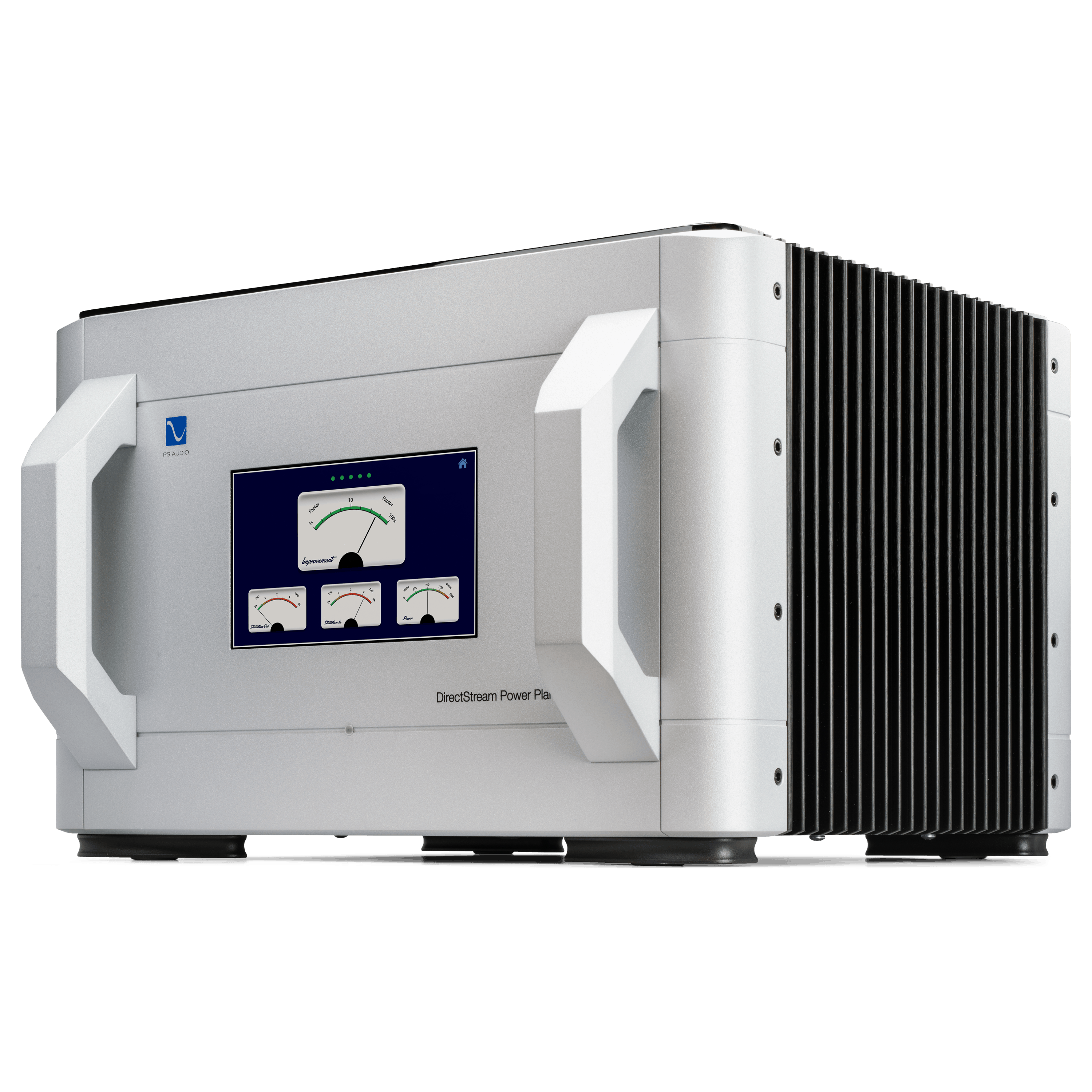
Similarly to the cable myths, there’s a market segment for power conditioners, or even power regenerators, that supposedly improve sound quality. Spoiler alert: this is all BS and it makes no sense from an electrical engineering perspective. Power regenerators and expensive power cables are completely, audibly useless.
This is debunked in this review of a popular power regenerator, which actually increases the amount of noise in the AC signal. It reduces distortion, but when measuring any electronics connected to it, there’s no measurable difference in distortion. There is a measurable increase in noise though, so that $5,500 power regenerator reduces the AC quality. The AudioQuest Niagaras are popular among audiophiles: those don’t degrade AC like the PS Audio, but instead it just does nothing whatsoever.
Audio electronics, except perhaps those using the cheapest crappiest wall-warts out there like the $7k Chord Hugo TT 2, have good enough power supplies to filter out all AC issues. A power cable sure as hell can’t even improve upon that. Audiophile power conditioners do nothing, and as shown in the PS Audio power regenerator review above, while such a device can reduce harmonic distortion in the AC, this makes no difference whatsoever as the resulting DC from the electronics is unaffected by that change (unlike the increased mains noise leakage brought on by that $5.5k device).
Digital Audio Myths and Misconceptions
Moving on from DACs, it’s important to highlight some fundamental concepts with regards to digital audio. First of all, controlling volume in the digital domain is not ideal, worst of all in software or in the operating system. That removes vital data from the digital signal, it’s the most surefire way to ruin fidelity on any system. It’s not quite as bad with a high end DAC designed around digital volume control, like those from Chord Electronics or Bricasti, but it’s never ideal.
USB Audio

You don’t have to pay more to get some fancier digital interface to connect to a DAC. Nor are audiophile USB cables beneficial. Noisy USB can be a problem for low end DACs from decades ago, but all DACs recommended above including the $80 SMSL SU-1 defeat this. With such DACs, there’s no benefit connecting to it from a fancy server using AES or I2S interface, like the one I built just to test this: it has a linear power supply, an expensive SotM PCI-E USB card with a fancy clock (thus isolated from the main USB bus), I even tried both a MOTU 8D audio interface and miniDSP SHD Studio here to connect to my DAC via AES/EBU, and both the USB card and MOTU 8D were powered by the linear power supply which used separate regulation for each (didn’t bother with this with the SHD Studio). All of this sounded no different than connecting to my DAC with a laptop.
More importantly, this has all been measured on places like ASR. USB input is one of the best ways to connect to a DAC as it’s convenient and any worthy DAC has a USB input (any XMOS USB included) with virtually no jitter. Thus, the audiophile “USB cleaners” are worthless.
But something that does matter is audio drivers. Bit-perfect playback is a must for high fidelity music listening, so for this you’ll want to use drivers that provide bit-perfect playback as well as “exclusive mode” so that the audio device isn’t used by anything else when playing. ASIO is the open standard here – there are ASIO drivers for pretty much everything and on both Windows and Linux, including a universal ASIO driver for Windows called ASIO4All. Windows has its own driver that supports bit-perfect playback though, called WASAPI exclusive mode. Use either one in Windows, it makes no difference. Use ASIO in Linux. I have no idea what Mac has to offer.
One problem with exclusive mode audio drivers is that it won’t work with software based EQ. This limitation makes DSP controlled studio monitors and/or DACs with built-in EQ more appealing. If you’re using software based EQ, you need to manually change the settings of your audio device in order to be bit-perfect.
Software Oversampling
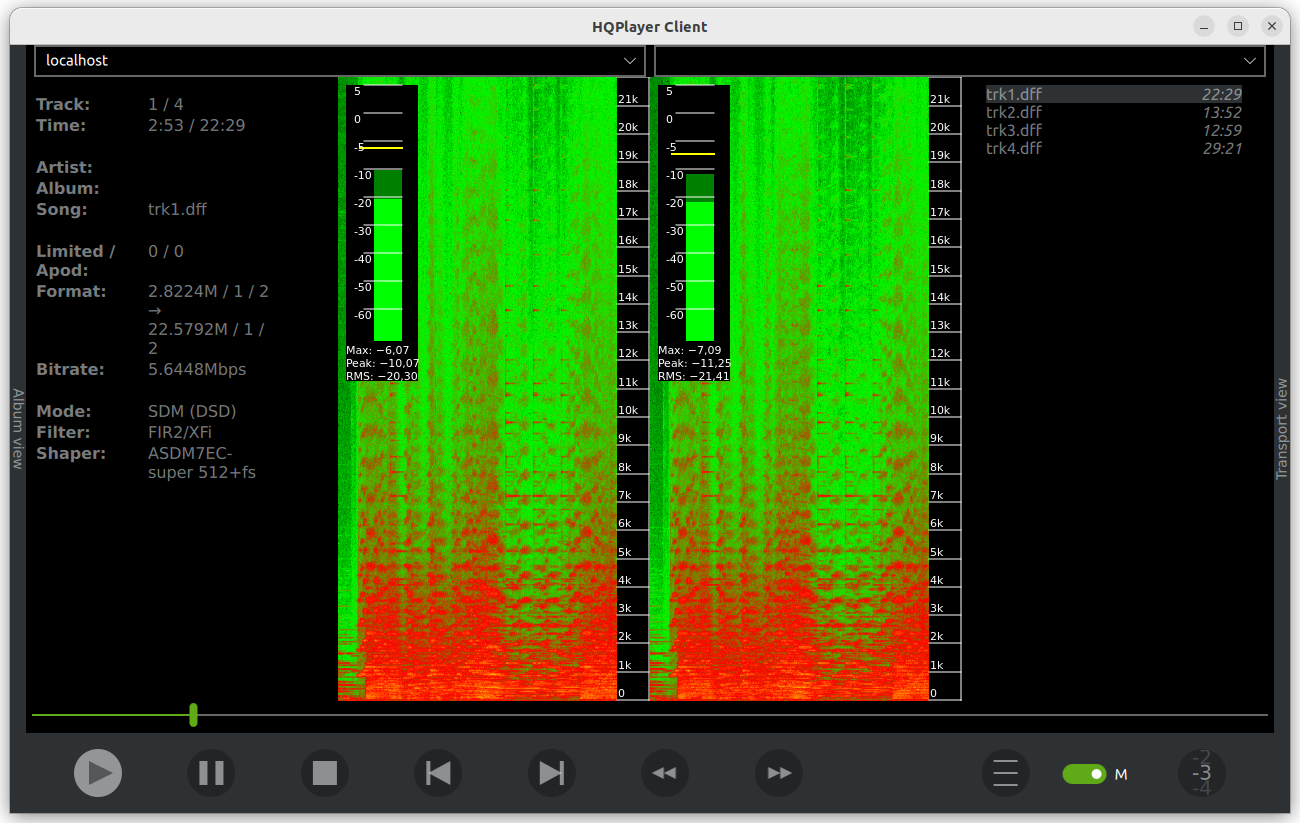
HQPlayer popularized software oversampling, and now there are other interesting solutions like PGGB. The idea behind these is straightforward: almost every DAC (and every worthy DAC) oversamples the audio signal in the digital to analog conversion process. This is built into almost every off the shelf DAC IC (e.g. the Analog Devices AD1955, two of which are used in my DAC), typically 8x oversampling (e.g. 44.1 KHz to 352.8 KHz).
These software solutions try to employ higher quality algorithms to do this, benefitting from the increased power in modern PCs compared to the power of a DAC. Well, that’s not pseudoscience at least. However, as expected, such higher quality oversampling is audibly useless to all humans in any decent DAC like all of those recommended in this article.
I blind tested this using PGGB on the highest quality settings with CD quality music (44.1 KHz, 16-bit, 1,411 kbps to around 1,700 kbps and even some ~600 kbps) with a Bricasti M1 SE DAC and ADAM Audio S3V. Sure, my DAC doesn’t allow for 705.6/768 KHz bitrate, but neither myself nor one other could distinguish the native music file vs the PGGB oversampled one.
Is software oversampling helpful with lower end DACs? I can’t say, but keep in mind not one consumer DAC in the world has the dynamic range to accurately reproduce 24-bit audio. Not that we have the ears for it anyway – around 116 dB hearing limitation vs 144 dB dynamic range. And not that any music actually has 144 dB dynamic range – the highest that has been measured is under 120 dB. Plus, no one listens this loudly. So on that note, don’t spend more money on 32-bit music.
Surprisingly, Mojo Audio has a good article on audio bit-depth. This is surprising because at the same time, they produce some of the absolute worst performing DACs in the world: R2R, non-oversampling, filterless DACs. The type that produces a SINAD of around 70 dB or possibly even worse. The only thing it’s missing is tubes, to bring that SINAD down to 60 dB or 50 dB!
One thing that’s certainly not helpful is the super expensive Chord Hugo M-Scaler upscaling device. It effectively does nothing with Chord’s DACs, and ruins the performance of other DACs as shown in this review. This is pure audiophile unsubstantiated pseudoscience.
Now let’s move onto one of the bigger myths in digital audio: DSD.
DSD – One of The Biggest Myths
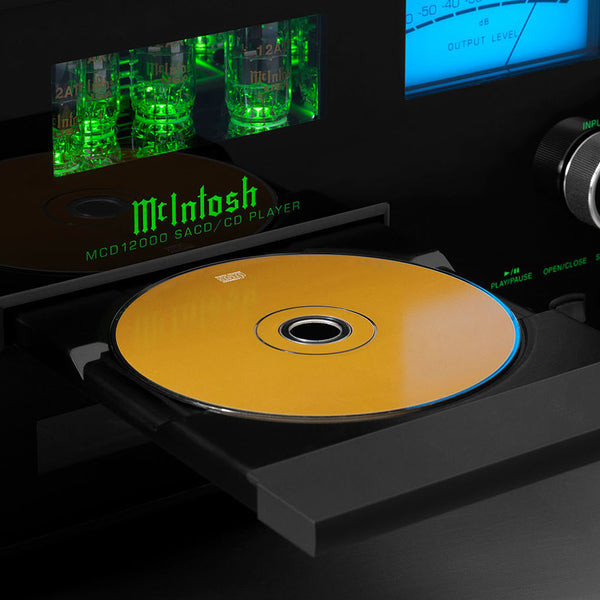
DSD (Direct Stream Digital) is the digital audio format used by Sony and Philips for SACD back in the day. You’ve probably never heard of it, and there are very good reasons for that. SACD is a dead product. Here’s the Wikipedia page on DSD, but essentially it is a more direct, single-bit storage format for a delta-sigma digital signal, whereas we typically deal with PCM format which is downsampled and multi-bit.
Everyone in this day and age is used to 44.1 KHz or 48 KHz / 16-bit MP3 quality compressed audio which has a bitrate of 320 kbps. CD quality audio is 44.1 KHz, 16-bit, with “lossless compression” achieving around 1,411 kbps on average. Professionals who deal with uncompressed audio files typically deal with 88.2 KHz, 96 KHz, and/or 192 KHz and 24-bit audio. DSD is over 2.8 MHz and 1-bit, so 64x higher sample rate than CD quality, or over 29x that of the common 96 KHz uncompressed PCM, or almost 15x that of 192 KHz uncompressed PCM. This is known as DSD-64, but there’s also DSD-128 (5.6 MHz), DSD-256 (11.2 MHz), DSD-512 (22.5 MHz), with the highest being DSD-1024 (over 45 MHz or 1,024x CD bitrate).
Surely this more direct, non-downsampled, much higher sample rate digital audio format has audible advantages in high end systems? Well, if you look at the historical context of it – maybe. An SACD can possibly sound better than a CD, if the music was originally recorded at very high quality, e.g. native DSD vs CD quality. But then the audio system needs to be capable of resolving the difference – and very few, if any systems produced enough dynamic range to resolve more than 16-bits back then. Not to mention, our hearing limits us to around 116 dB dynamic range which is just slightly beyond 16-bit but nowhere near 24-bit.
But comparing DSD to uncompressed PCM is another story. Some audiophiles certainly believe there’s a difference here, but like so many audiophile beliefs, it’s placebo. There’s one key difference between DSD and PCM – storage space requirements. DSD is a behemoth, so if you’re storing a library of DSD music, you need terabytes of storage space.
As for sound quality, between DSD and uncompressed PCM, there’s no audible difference. The academic world can’t point to any. So with DSD you’re spending time hunting down music available in this format, probably spending more money on the music itself, and then spending more money on storage space, for no audible benefit.
I’ve blind tested this on an extremely revealing headphone setup that easily reveals audible differences between different high end analog interconnects, and heard zero difference with DSD-512 vs uncompressed PCM, using a DSD capable DAC. Same for others I had test this. This audio setup comprised of the following: Chord Hugo 2 DAC -> Mjolnir Audio KGSSHV Carbon amplifier (22mA output stage) -> Stax SR-009 headphones.
I recently redid this blind test with a Bricasti M1 SE -> Schiit Freya S -> Adam Audio S3V using DSD-256 (the most this DAC supports) vs uncompressed PCM, and once again, no audible difference. Even when testing with music consisting only of string instruments which, due to the realism of this system, give me distinct feelings on my ears.
Surprisingly, Mojo Audio of all companies has a good article about DSD. Toms Hardware also has a fascinating blind testing article using two very different listeners, in which they talk about >CD quality audio not mattering here. As for the blind testing, no one was able to reliably hear any difference with really expensive DACs. One listener was only able to eventually (by becoming an educated listener) reliably distinguish the sound card. The listener more used to very old, expensive speaker systems, refused to actually guess once they realized they couldn’t tell anything apart. Old people not being able to handle their views being brought into question by facts, what else is new?
The bottom line: ignore DSD. It’s dead for a reason, don’t dig it back up.
Music Streaming Services

Perhaps an even bigger myth than DSD is MQA. This snake oil doesn’t deserve its own section. MQA is a way for a company to monetize every element of digital audio, from the recording to the DAC chips themselves, to the DAC devices and/or streamers/players – all MQA certified, all money that goes to the organization behind it and more money you have to spend if you want MQA certified stuff. Recording studios and manufacturers must pay them to conform to their standards and get the MQA label slapped on. MQA is nothing more than a proprietary digital audio ecosystem that plays on the audiophile’s love for pseudoscience, as a way for them to get rich. Disregard it, as well as the Tidal streaming service and don’t pay more for an MQA DAC. It is perhaps the most organized, widespread audiophile scam ever.
So based on that, I recommend ignoring Tidal. I also recommend avoiding Spotify and Youtube since even the premium versions of those are limited to 256 or 320 kbps which is badly compressed. It doesn’t make much of a difference, but for a similar price you might as well obtain better: either Qobuz or Amazon Music Unlimited. Both have similarly sized libraries and support lossless compression formats up to 192 KHz / 24-bit and around 3,730 kbps I believe thanks to lossless compression.
One thing you’ll come across everywhere is Roon. It is a universal music playing software useful for playing all your music in one player, which can be hosted on your network. This includes any music streaming service you can think of, plus your own music files. It’s convenient, but the cost is outrageous – $15 a month, $150 a year, or $830 for a one time lifetime subscription. Personally, I can’t justify this.
When I was listening to music off of a computer, I just had Qobuz and MusicBee (offline player) open at the same time. Barely an inconvenience, and not one worth spending $830 to resolve in my mind. Now that I use a network streamer, I control all my music through that streamer’s interface, so in that regard it’s like Roon – all in one place. My Qobuz music and raw music files are all in the same player, on my streamer’s OS. That streamer did cost me more than the price of Roon lifetime (its main use case for me is Dirac Live), but you can make your own for way less than the price of Roon using a Raspberry Pi or custom built computer and a free OS like Volumio, which is what my streamer uses. But of course, making your own streamer like that takes some amount of effort, unlike buying Roon.
Conclusion
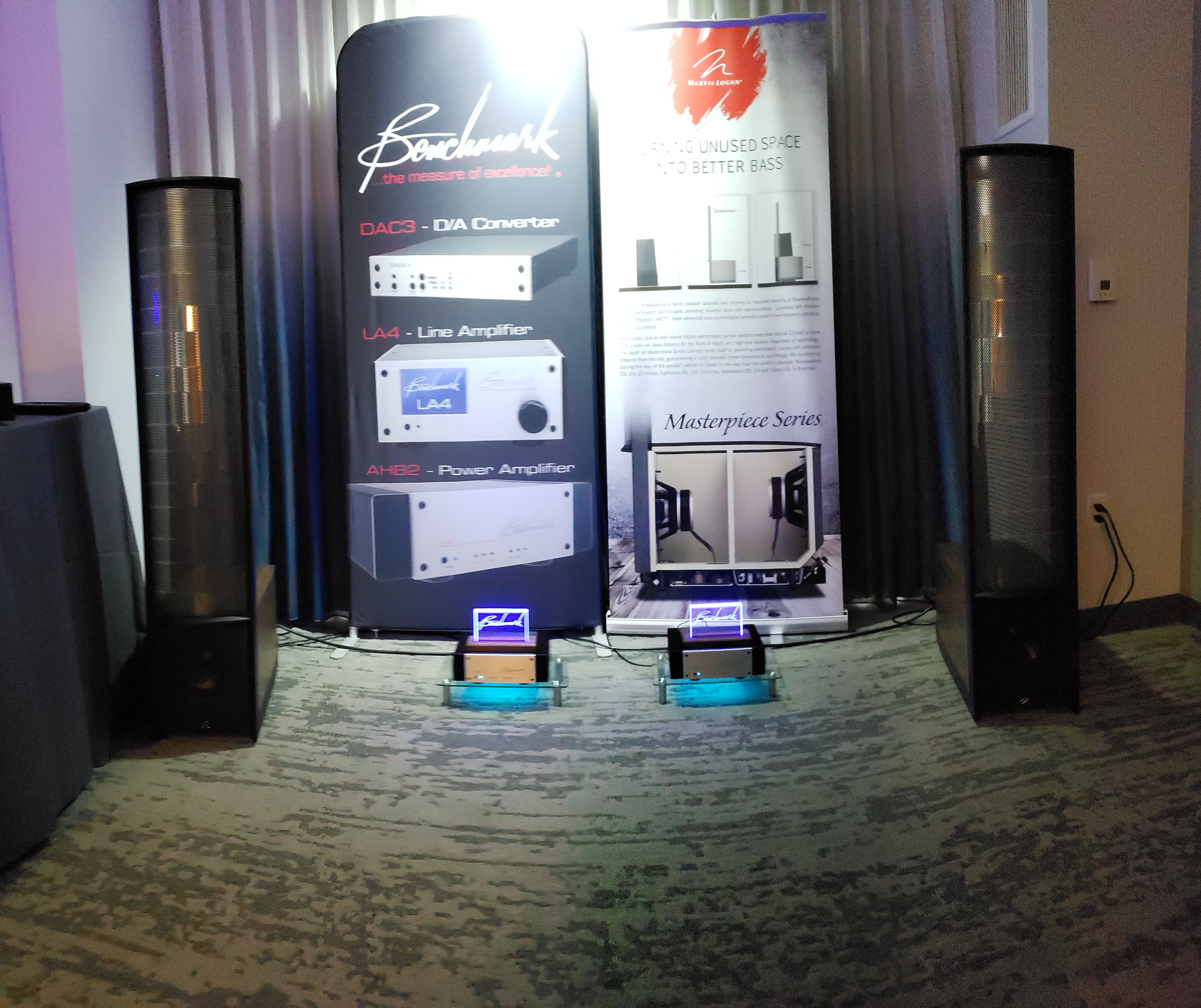
We’ll now end this article with some general speaker system recommendations as component matching is vital. You don’t want an underpowered or even overpowered amplifier for your speakers.
Mid-Fi 2.1 System – This entire system starts at just $885 for the main components below.
- ADAM Audio T5V ($400 for a pair), T7V ($500 for a pair), or T8V ($600 for a pair) depending on budget and space. The only difference between these is the size of the woofer (5″, 7″, and 8″ respectively).
- Dayton SUB-1500 ($260)
- miniDSP 2×4 HD ($225)
High End 2.1 System – This system is expensive at $2,770 total ($2,420 if you omit the Topping L70), but all of it together costs less than most flagship headphones and it embarrasses all audiophile stereo systems in technical performance.
- Neumann KH 80 DSP A G ($1,100 for a pair)
- RSL Speedwoofer 10S MKII ($450)
- Topping L70 ($350)
- Neumann MA 1 ($300)
- miniDSP FLEX Balanced ($570)
End game for less than expected – As good as it gets:
- Genelec 8331A ($4,900 for a pair), or if you want to step it up beyond this then get the Genelec 8341A ($6,200 for a pair), Genelec 8351B ($8,390 for a pair), or Genelec 8361A ($10k)
- Topping L70 ($350)
- SMSL DO400 ($500)
- Genelec GLM (around $300)
These are just some examples of matched systems that will sound great within a set budget. Just remember to do your research, ignore most or all subjective listening impressions since only yours matter, and look at actual data (third party measurements).

The consumer hi-fi/audiophile industry is built upon the idea that it’s very easy to convince someone that fancy looking, very expensive audio equipment adds magic to the music. If you’re a consumer in this industry, ask yourself if you’ve been convinced of this. Ask yourself why would audio equipment be an exception to the rule that technology evolves, improves, shrinks, and reduces in cost over time. Most of all, perform level matched blind listening between audiophile equipment and the products recommended in this article.
The data reveals that all the best performing audio equipment is nowhere near the most expensive, and these more affordable top performers never have striking looks nor are they relatively enormous in size. That’s right, the ultra expensive, fancy looking hi-fi equipment performs worse than sanely priced, plain looking pro audio equipment (speakers, electronics, cables) and also worse than the cutting edge electronics produced by JDS Labs, THX, Topping, SMSL, Gustard, Geshelli Labs, miniDSP, Hypex, Purifi, and 3e Audio.
In this, reality goes against human psychology, especially the psychology of those who do have the money to burn on insanely priced audio playback equipment. This is the essence of the “audiophile” industry – it’s not built on technical performance, it’s built on psychology and thus marketing of course.
Unfortunately, people are extremely susceptible to brand loyalty and becoming stuck in their ways. As a result, not only do the boutique audiophile brands attack the much lower priced, objectively higher performing alternatives recommended throughout this article, but so do their customers. “How dare someone compare an $80 Chinese made DAC to my $150k American made DAC!” Even though deep down they know they’re paying for nothing more than fancy looking furniture or jewelry at the end of the day, they also want to believe their big bucks are getting them “the best”, but these days it’s objectively getting them much closer to the worst.
Be glad that super expensive audiophile equipment is a scam, it means you don’t have to waste your money. The best performing audio electronics are all obtainable, plain looking, and the electronics are small: ~$100 DACs, $130-350 headphone amps, $350 preamps, $250-600 power amps beat all the super expensive stuff and these are the points of diminishing returns due to our hearing limitations (yes, all of us) and acoustically poor listening environment, which innovative technologies such as Dirac Live, Anthem Room Correction, and others are thankfully trying to help mitigate. Like with any other technology, audio equipment improves over time, becomes more efficient, becomes smaller with regards to electronics, and price to performance improves.
Audiophile cables, servers/streamers, vinyl systems, vacuum tubes, oversampling software and dedicated hardware, and digital audio file formats (DSD or super high sample rate PCM) are all wasteful scams that data (measurements and properly conducted blind testing) shows either performs the same or performs worse. The actual expensive top performing consumer audio equipment are speakers ($10-10.5k/pair for the best), subwoofers (top tier performance seems to start at just under $3k), over-ear headphones ($2k, but you can get very similar performance from a $25 IEM), feature-rich audio interfaces with things like Dirac Live and especially Dirac ART ($400 to $20k), and most expensive of all – the best possible room treatment.

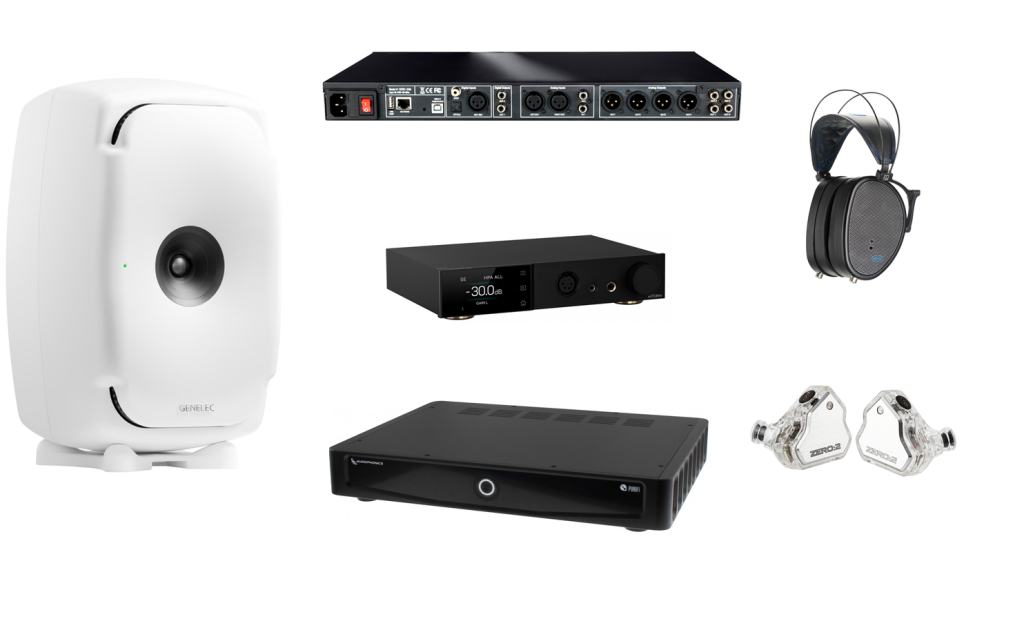
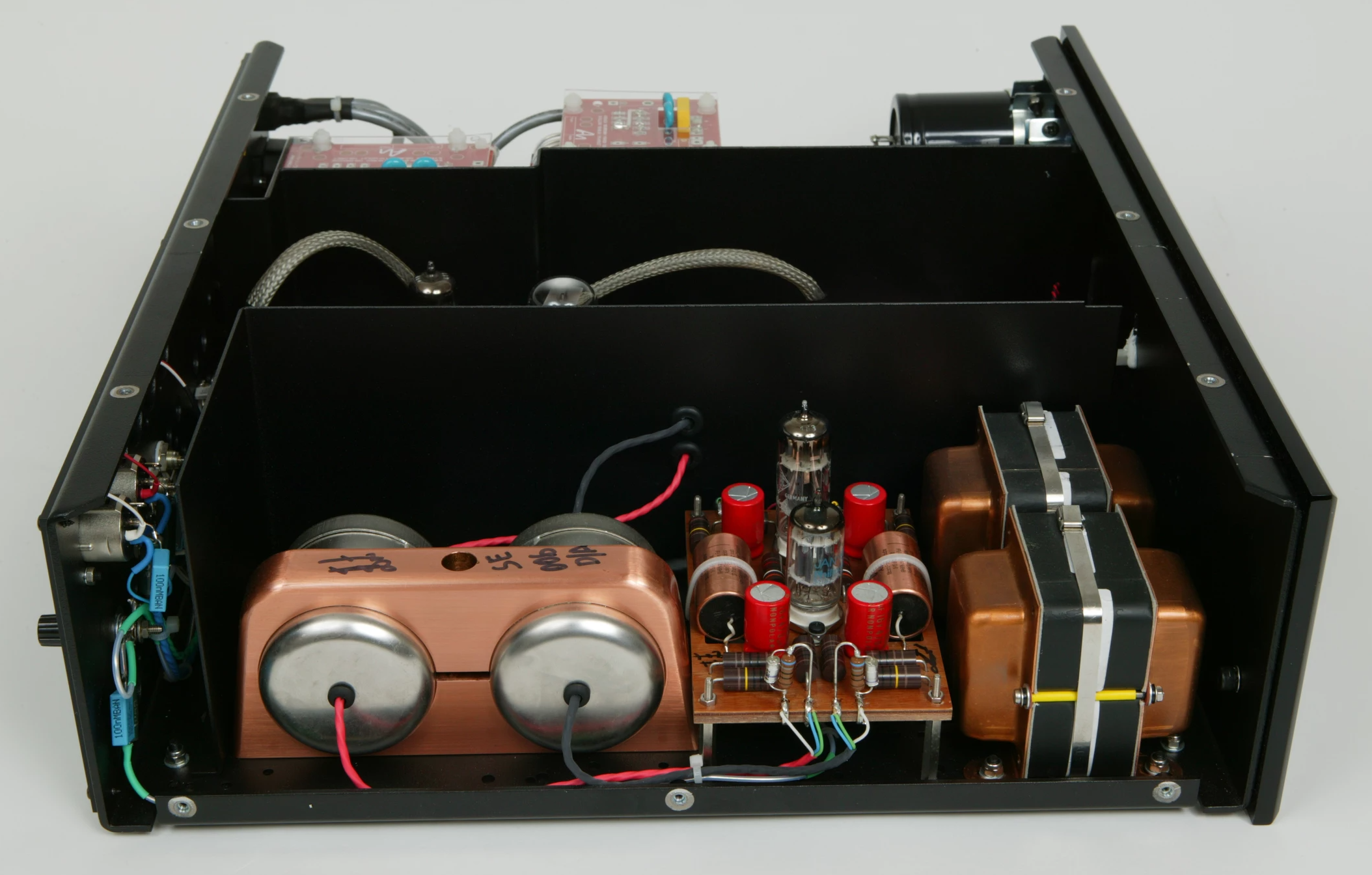




Lots of good info here especially since I’m in the market for some new speakers for my main PC, as well as some headphones for my Aorus laptop. Will be referencing this as I’m an audio noob.
Good to know about the typical “gaming headphones”, I’ll definitely be looking at some of the listed brands.
Lots of good info here especially since I’m in the market for some new speakers for my main PC, as well as some headphones for my Aorus laptop. Will be referencing this as I’m an audio noob.
Good to know about the typical “gaming headphones”, I’ll definitely be looking at some of the listed brands.
[…] Sound is delivered through large 53mm Full-Spectrum drivers. The ear cups themselves that house the drivers are configured in a closed-back setup which is designed to eliminate or reduce outside noise from being heard. This allows the user to focus on the game at-hand by eliminating outside distractions, however, there are draw backs and advantages to this particular style. […]
[…] The DAC features Xamp which works as a discrete headphone amp utilizing bi-amplification technology. The external box will give you a few extra ports which includes two mic ports and two headphone jacks, perfect for interfacing with your high end audio equipment. […]
A couple or points: 1. Your conclusion that preamps are largely obsolete ignores the fact that often better sound can be achieved when using a high quality pre-amp even in conjunction with source components that have an integrated (digital) volume control. Less in not more in this case assuming your employing a pre of high enough quality that is 2. Audio Note UK has the more modern/sophisticated designs (not Kondo). Also, Push/Pull is inherently inferior to single ended as it requires a phase splitter that introduces unnecessary distortion. All top-flight AN UK amps are single ended designs for that reason. They… Read more »